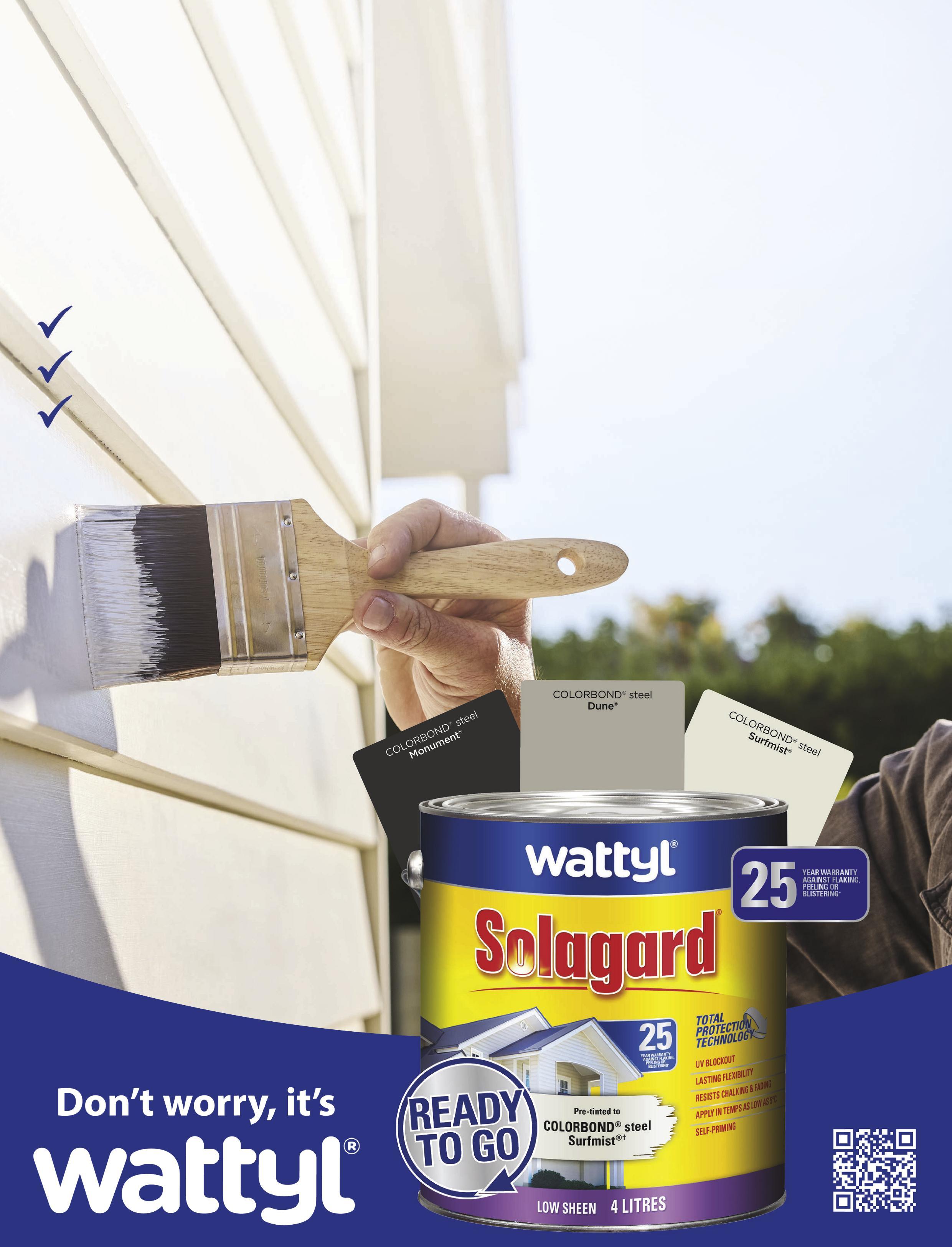





TOOLS & TRENDS
PETROL POWER: YAY OR NAY? PLUS, THE LATEST IN TILES
BIG DECK ENERGY
The cutting-edge materials shaking up the industry
WORK SMARTER, NOT HARDER
Tips to help expand your business, from a landscaper who has doubled his







PETROL POWER: YAY OR NAY? PLUS, THE LATEST IN TILES
The cutting-edge materials shaking up the industry
Tips to help expand your business, from a landscaper who has doubled his
How innovations in frame and truss are reducing build times, costs and onsite injuries

Editor Erin McWhirter
Art director Katie Smith
Chief subeditor Leigh Livingstone
Editorial co-ordinator Joseph Visser
Account partner Henry Kalaf-Tyrrell
Business manager NSW Dale Johnson
Business manager VIC Rosanne Costa
Campaign manager
Deanna Kane
Advertising enquiries bunningsadvertising@ mediumrarecontent.com (02) 8114 8900
General magazine enquiries
trademag@bunnings.com.au (03) 8831 9777
Managing director Nick Smith
Head of sales Annii Hirst
Head of Content: Health, Home & Lifestyle
Gemma Sutherland
Published by Medium Rare Content Agency
Pty Ltd, ABN 83 169 879 921, Level 1, 83 Bowman Street, Pyrmont, NSW, 2009, Australia for Bunnings Warehouse, ABN 26 008 672 179, Botannica 3 – Level 2 East Tower, 570 Swan St, Burnley, VIC, 3121, Australia. © 2024. All rights reserved. For any queries or feedback, please call the magazine team on (03) 8831 9777 or forward to the attention of Bunnings Magazine Team, Botannica 3 – Level 2 East Tower, 570 Swan St, Burnley, VIC, 3121, Australia.
When using power tools, always wear the recommended safety gear. Editorial content is general in nature and is not intended to be a substitute for legal or professional advice. Products featured in the magazine are on offer while stocks last. Some products are not available at all Bunnings stores, but may be ordered. Colours may vary slightly from images shown due to the printing process. Prices shown are Bunnings prices at the time of publication and some prices may vary in regional areas. Pricing is to be used as a guide only. Bunnings Trade magazine runs third-party advertisements. Bunnings does not endorse, evaluate or take responsibility for the products or claims in these advertisements. This publication is not for sale.

Product is available to buy online only at bunnings.com.au and is sold by Bunnings Marketplace. Not all items are available in all states and territories. Delivery charges may apply.


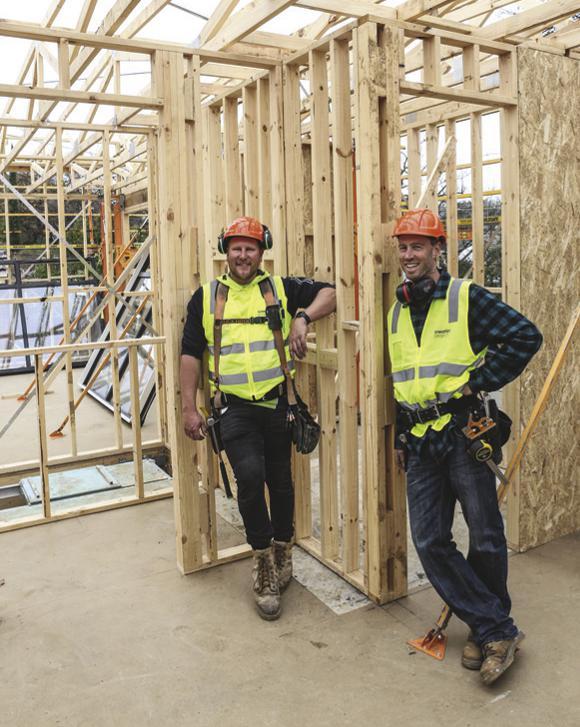

AND UPDATES
Your need-to-know industry info and latest highlights.
EVOLUTION
How prefabricated frame and truss is changing construction.
ON
Building Solutions Studios: your one-stop-shop for planning. 18 NO-BRAINER SUPPORT
The service ready to assist you with those big job logistics.
DIGGING THE OUTDOORS
Landscaper Peter de Beer reveals the specialists that help his business grow.
Can petrol-run garden tools still live up to the hype?
Kincrome’s new BLUESTEEL® range is a monster. 32 LAYING IT ALL OUT
Must-have tiling trends to share with your clients. 34 BENCHTOPS 2.0
Engineered stone is out; we have your best alternatives.
38 YEAH, THE GIRLS!
The apprentices breaking new ground on the jobsite. 42 SAFETY ALERT
Are you contributing to a safe and healthy work environment? 45 CUTTING-EDGE DECKING INNOVATIONS
Carpenter Tim Clark on decking choices your clients will love.
Supercars Championship driver Jack Le Brocq talks shop. 50 SAVE TIME ON YOUR BUSINESS ADMIN
Practical tips from Xero to manage your job costs.



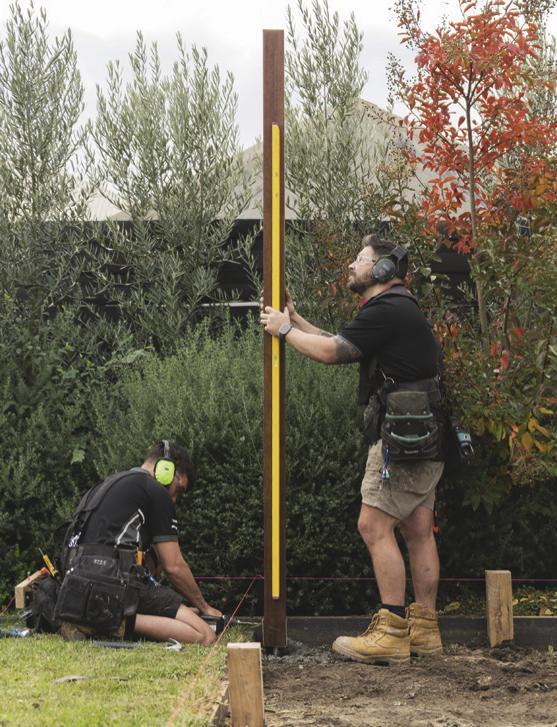
52 CHECK OUT MY RIG
Window installer Matt Mahony takes us on a tour of his innovative van fitout.
54 HELP STOP TOOL THEFT
Protect your gear with these top security tips and products. HACKS HUB
58 HOW’S YOUR SUN SAFETY?
Slip, slop, slap, seek and slide through summer.
60 TACKLING HEAD NOISE
Free mental health counselling service TIACS is looking out for our wellbeing throughout the festive season.
62 THE CRACK UP
Headscratchers and funnies to keep you laughing.
64 MEET THE REAL BOSSES
These furry little CEOs are tough taskmasters.
66 YOU HAD ONE JOB! What could go wrong?




































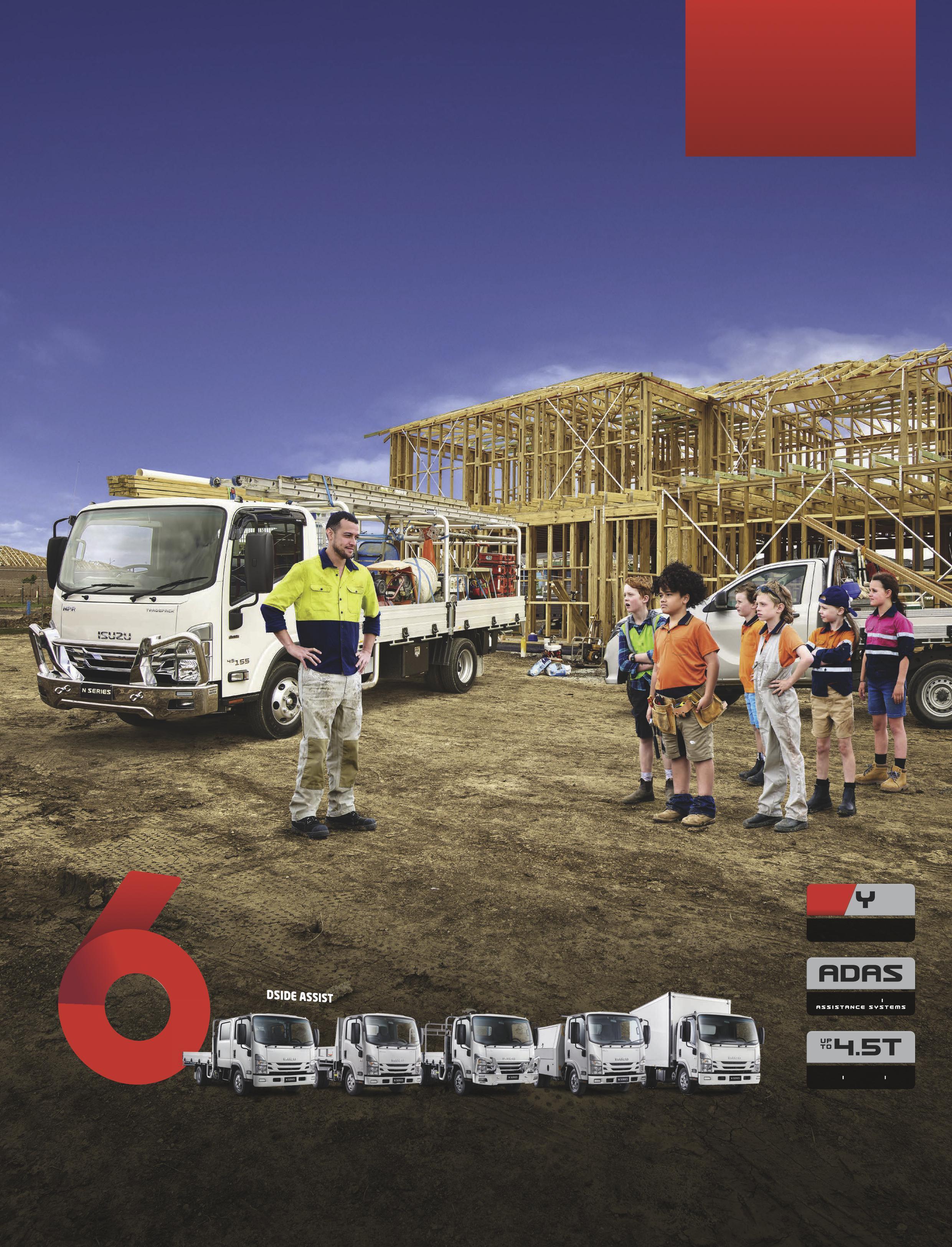




































































































It’s been great seeing so many of you pour through the doors of our Bunnings Trade Expo locations around the country to hear about the latest industry insights, while also connecting with our team and suppliers. Newcastle and Cairns, you’re up next (turn to page 8 for more info).
Whether it’s at our Expo, on the road or in-store, providing personalised, quality service is at the forefront of our team’s minds, and it’s always nice to see you, our valued customers, working closely with our specialists to help your businesses thrive.
Landscaper Peter de Beer admits that without the efficiency and help of his ‘extra pair of hands’, Landscape Specialist Sia, he’d be lost. Working with Sia has ‘taken the edge off’ running his small business, saving him time and money. Peter shares his struggles and triumphs as he continues to grow his Brisbane-based business, as well as his tips on how he uses the Landscape Specialist team to his winning advantage. Hear what he has to say from page 20.
For this issue’s cover story (page 12), we hit up carpenter/framer Rhys Parrott, along with Creation Homes’ Matt Fraser and Stefan Smilevski, to talk about the changes they’re seeing in the frame and truss world, and the innovations that are making their lives easier on the job. The trio also speaks about the strong working relationship they’ve built with our Frame and Truss Specialists, who are helping them deliver their projects on time, on budget, but most importantly, saving them hours upon hours when it comes to delivery and install.
Our jam-packed issue has something for everyone, from whether petrol-powered garden tools still have the grunt to get the job done to decking trends, as well as sun safety tips as we head into summer, and chats with three female apprentices breaking ground in trades.
As we sign off, remember safety is everyone’s business as we head into National Safe Work Month this October. Look out for yourself and your workmates with safe and healthy jobsites.

Bunnings respectfully acknowledges the Traditional Custodians and Elders of this Country and recognises their values, beliefs and continuing connection to land, waters, cultures and communities. May the stories, knowledge and wisdom shared on this land unite us as one people in the true spirit of Reconciliation for today, tomorrow and for our future generations.

With more than 50 years’ experience on the tools, Brian shares his extensive skills as a Trade Specialist.
Brian, who celebrates his 66th birthday on October 8, knows a thing or two about the trade game through years spent as a carpenter/joiner and licensed builder. He tells us of his joy sharing that knowledge with other tradies who come in looking for assistance...
Q: Tell us a little bit about your background.
A: I am a third generation carpenter/builder and grew up working with my father making our own furniture. My grandfather was well known for building houses pre- and post-World War II in the Ryde, Gladesville and Hunters Hill areas of Sydney. The smell of freshly cut timber has always attracted me to this day.
Q: What did working in trades teach you?
A: Being a builder, you learn many different trades, materials and methods. You need to program the progress of the build, and to anticipate stages of construction to keep the flow of trades and materials working together. It also taught me how to liaise with owners and architects in unison to complete the job in a manner satisfactory to all.
Q: You’re on the Bunnings Trade Specialist team. How does your background in building and trades help customers?
A: Being at Bunnings keeps me up-to-date with the new products to assist customers and trades with problem-solving and ideas. As a builder with more than 50 years of experience, customers respect my knowledge. Now, most regular customers ask me for repeat advice. It’s also a thrill for me to pass on time and knowledge to younger team members.
Q: What is your advice to others in the trade industry or apprentices about to dive in?
A: My home truth is to always finish what you started yourself, otherwise you’ll get the nickname ‘Arfa’ (half-a-job). But perhaps more importantly: check twice, cut once. While I was an apprentice and carpenter I was taught by some skilled tradesmen and their acumen was simple: listen, learn, practise – and that will be the standard you achieve.

GROWING HIS TRADE
South African-born Peter’s biggest tip in small business survival? “Budget constantly!” he says. “The best thing I ever did was pay someone to do the book work. Spending money on an accountant is undervalued – it shouldn’t be.”
Peter de Beer (left) of Brisbane’s PWS Gardens appreciates the time and savings of working with Sia (right) and the Landscape Specialist team at Bunnings Trade. “It took me five years to figure out a system as a growing business. I wish I went to Bunnings earlier.”
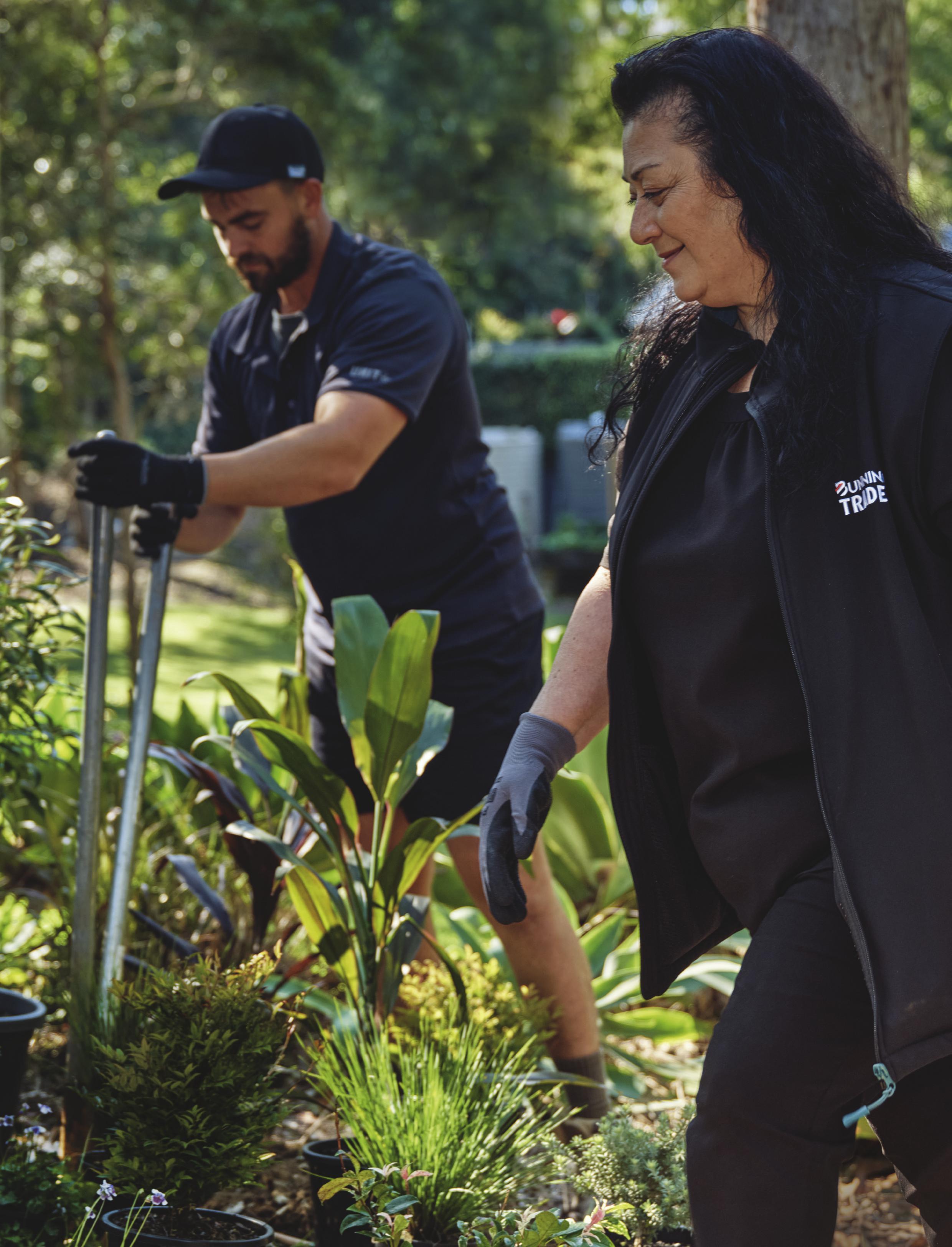
Need-to-know industry info and the latest highlights.


TradeMutt and TIACS partner with Bunnings Trade for an important cause.
“In a cut-throat business like being a tradesman, where you can work big hours away from your loved ones and sometimes see your kids for an hour when you get home, having someone to talk to is really important,” carpenter
Mark Dingle of Merit Builders in Caloundra, Sunshine Coast says (pictured left with his brother, third year apprentice Ryan). The boys grabbed themselves a limited edition TIACS drink bottle and Bunnings Trade TradeMutt shirt (pictured) as part of ‘Funky Shirt Friday’, a TIACS initiative to raise awareness for its free counselling service supporting tradies, truck drivers and blue-collar workers with their mental health. Turn to page 60 for more details on TIACS.
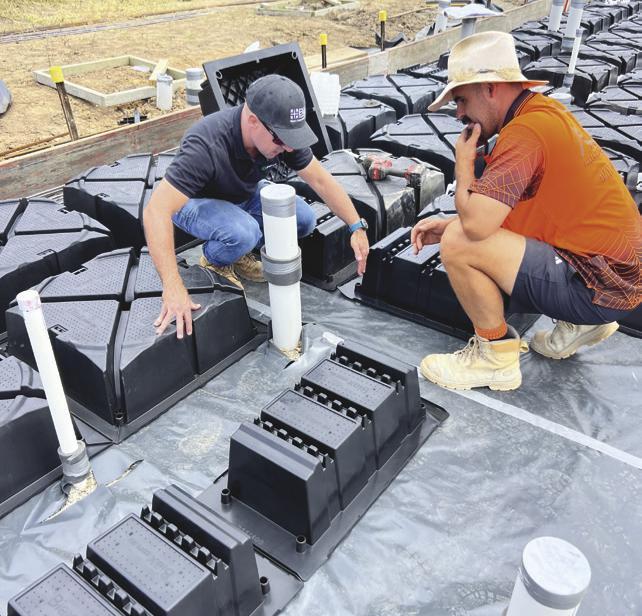
We’ve all been on worksites with EPS waffle pods taking up space, not to mention trying to keep on top of the mess that comes with crumbling polystyrene. Many sites are now using environmentally-friendly BIAX pods – a giant leap forward in how new homes of the future will be built. Made from 100 per cent recycled plastics, the nifty pods stack neatly, creating space and staying out of the way. The engineered ridges also eliminate the need for bar chairs. And no pod movement during the concrete pour means you’ll also notice an improved concrete yield. The price, meanwhile, is comparable or cheaper than standard polystyrene waffle pods.
Bunnings Trade is partnering with BIAX to bring the innovative product to customers – watch this space.

Nab daily deals and be up-to-date with the latest industry innovations when you walk through the doors of Bunnings Trade Expo. With two more events on the calendar before we sign off for the year, it’s time to get involved. If you’re in Newcastle, be sure to register for the date at Newcastle Entertainment Centre on Thursday October 3. For our builders and tradies in Far North Queensland, Cairns Convention Centre will deliver the goods on Thursday October 24. Both events run from noon until 7pm, so be sure to head down and find more than 100 suppliers to peruse – all under the one roof.

It’s never been easier to get a quote or order and delivery updates, as well as info on pricing, stock and general trade enquiries, than by putting in a quick call to 134 TRADE.
The daily slog is real, but there is a way to win back valuable minutes and save on petrol, too. You might be on a job and need to request a quote for something on the spot. Simply go to the Bunnings Trade website and hit ‘request a quote’ or pick up the phone to 134 TRADE – it’s a game-changer for busy tradies.
“You fill in your PowerPass membership details, let us know if you need delivery or collection, add the product details and quantities, and that’s all there is to it,” Bianca Lavars, Operations Leader at Bunnings Trade Assist, says. “We’ll have your quote out to you in about one to two business days, and then have your order ready for collection, or your goods out to site, when and where you need it.”
Designed for tradies, 134 TRADE is your hotline to Bunnings, aimed at reducing your trips to store and minimising tasks that take you off the tools. “134 TRADE is all about simplifying transacting at Bunnings for our PowerPass members,” Bianca says. “It’s your one-stop-shop for quotes, orders, stock enquiries, app assistance, online assistance and account enquiries.”
The phone line is teamed with trade experts located all the way from Sydney to Perth. “We’re available via phone, email, and live chat 7am-6pm Monday to Friday and 8am-2pm Saturday,” Bianca says. “We can action quotes, orders and stock enquiries for any store around the country, so wherever you are – whether that’s onsite, at home or interstate, it doesn’t matter – we’ve made shopping with Bunnings a whole heap easier.”
Yes, it’s a phone number, but there are plenty of other ways to connect with 134 TRADE
Call the team: 134 TRADE (134 872)
Email: trade@bunnings.com.au
Use the ‘request a quote’ form at trade.bunnings.com.au
Start a live chat – go to the website and hit the red ‘chat with us’ button on the bottom right of screen to get started

number to your contacts.











While home building might be at the lowest it’s been in a decade, HIA Senior Economist Tom Devitt says homeowners are still forking out for renovations.
Why is this good news? Because how often do we get to say that a boom is over, while the entire forecast horizon is still expected to remain stronger than anything before the boom?
The pandemic saw tremendous demand for renovations across the developed world, including a record-breaking increased incidence in Australia Homeowners undertook a wide range of projects to improve their living environment, including doing up their kitchens, bathrooms, entertainment rooms, electronics, home offices, and backyards
Since then, many smaller projects have been completed and others are being shelved in the face of elevated build costs and interest rates, causing activity to moderate.
But larger renovation projects – those actually requiring building approvals or external finance – are expected to continue supporting activity at near-record levels Approvals for renovations are still hovering around 40 per cent above pre-pandemic levels across Australia , while lending for renovations is around triple those levels!
This suggests there are a number of Australian households that still have the savings, assets and borrowing capacity to undertake major renovation projects It also suggests that the broader pandemic desire for home improvement across Australia remains strong
As materials and labour pressures continue to ease, and household incomes improve, many of those projects currently on the backburner could come back to market
With the new home building market enduring its weakest year in over a decade, there is comfort in seeing the renovations sector powering ahead
Bunnings has re-teamed with Wattyl, after more than a decade apart, to launch an exciting new Ready to Go range that will save you valuable time.
BY JULIE LEE
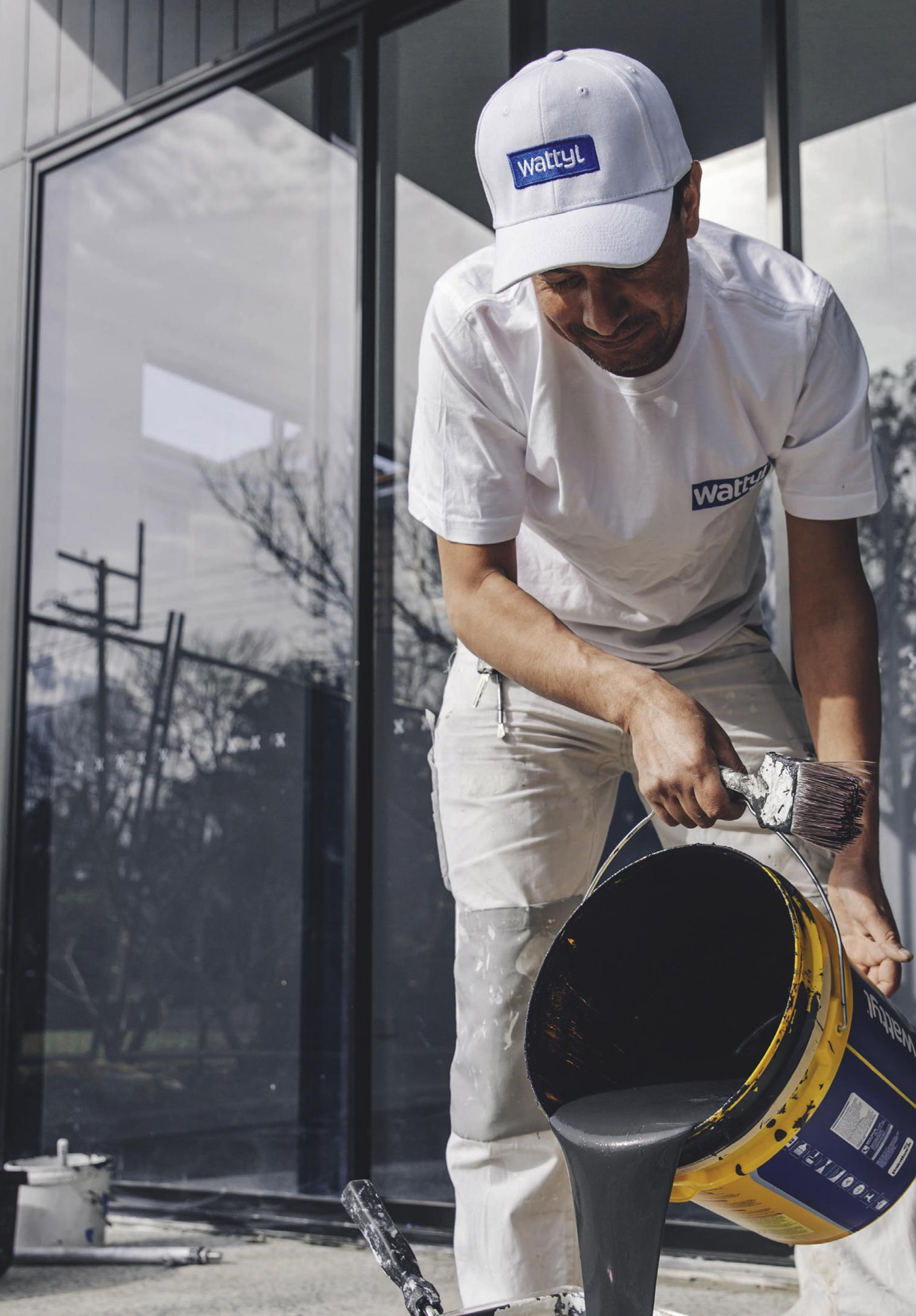
There’s a revolution coming to the paint section of Bunnings that promises to save you time and a whole lot of hassle. Wattyl’s new range of Solagard Ready to Go exterior paints are – as the name suggests – ready to grab and go or, in this case, ready to ‘pick and paint’. Just select the colour, grab a tin, check out at the register or on the PowerPass app, and you’re done.
The new selection, which is Bunnings’ largest pre-tint range with 20 ready-to-use COLORBOND® steel colours, was specifically developed to streamline the process of buying paint. “The consumer can go [straight] to the shelf where the colours are ready to go,” Wattyl’s Managing Director, Matt Crossingham, says. “This ready-to-go
range will enable tradies to get in and out of the store with ease and get back on the job.”
Since Solagard first launched in Australia in the 1980s, Ready to Go sees Wattyl continue to deliver products suited to our harsh Southern Hemisphere climate – who can forget the iconic ‘egg frying’ advertisement of the early ’90s? “It’s developed for the Australian conditions,” Matt says. “We know consumers know the Wattyl Solagard brand and what it stands for: strength and quality.”
With various sheen levels and sizes available (from 100ml pots to 1L, 4L, 10L and 15L tins), the range also eliminates any colour inaccuracy that could occur through mis-tints, saving you valuable time and money.
COLORBOND® steel Dover White™
COLORBOND® steel Southerly®
COLORBOND® steel Bluegum®
COLORBOND® steel Surfmist®
COLORBOND® steel Shale Grey™
COLORBOND® steel Windspray®
COLORBOND® steel Dune®
COLORBOND® steel Wallaby®
COLORBOND® steel Basalt®
COLORBOND® steel Classic Cream™
COLORBOND® steel Paperbark®
COLORBOND® steel Manor Red®
COLORBOND® steel Evening Haze®
COLORBOND® steel Pale Eucalypt®
COLORBOND® steel Cottage Green®
COLORBOND® steel Woodland Grey®
COLORBOND® steel Ironstone®
COLORBOND® steel Deep Ocean®
COLORBOND® steel Monument®
COLORBOND® steel Night Sky®
The range includes all the favourite colours, such as Cottage Green, Classic Cream and the ever-popular Monument and Surfmist. “Colorbond colours are well-known,” Matt says. “If you look at homes today, most are developed off at least one Colorbond colour. Either the roof or the gutter, the downpipes, or even the weatherboards, are typically tinted or painted with a Colorbond colour.”
Wattyl teamed up with Bunnings to develop this easy-to-use range and bring it into stores where, for the first time in more than 10 years, you’ll be able to buy Wattyl products in Bunnings. “It’s such a great opportunity,” Matt says. “Our entire business is looking forward to connecting these two iconic Australian brands.”

The best start withpaint jobs

















































































With technological advancements in prefabricated frame and truss production meaning a simple smartphone scan reveals the whole layout in 3D, builders are increasingly turning to offsite construction as a method to bring their builds in on time and on budget.


































































































Anyone who works in construction knows one of the most time-consuming and toughest parts of the job is framing Like stuffing up the slab, if your framing is off, the whole build could be put in jeopardy (and you’ll likely cop more than an earful about it). It’s vital and has to be done right



For decades chippies have been onsite, spending days on the drop saw and working the nail gun alongside other trades in the inclement weather – often hand-tied by noise restrictions.






Carpenter and framer Rhys Parrott, director of Build Wright Carpentry in Melbourne, says he’s seen it all while toughing it out in his more than 18 years in the building game









As jobsites get more savvy and technology allows for brands to innovate, Rhys says the introduction of prefabricated frames and trusses has revolutionised the way he works The technological advancements, mean faster install times, less wastage, cost savings and improved safety outcomes for his team now that













BY SCOTT ELLIS



the majority of his framing and carpentry work on a building site is done mostly using prefabricated frame and truss


“Without a doubt, one of the biggest improvements to my job has been prefabricated frames and trusses,” Rhys says.





“For a start, it’s quicker and speed is a big thing on a site It used to be that the sticks would land and you’d have someone there for at least half a day on a drop saw cutting all your studs or window trims or whatever you need. Then you’ve got the crew putting them all together as per the plans For a single-storey stick-build it would be about three days ”








Made to size with all the lintels in, prefabricated frames have slashed install time





“They come and fit where they’re supposed to go; the same job that used to take several days now takes about a day,” Rhys says




The process is simpler and a game-changer in building construction, says Shane Keating, executive director – building policy at Housing Industry Association (HIA) Prefabricated frames and trusses are becoming increasingly common





in the Australian building industry, particularly along the east coast





“A degree of offsite construction brings time savings, for example, allowing walls to be constructed before a slab, or a roof to be constructed in parallel with the walls,” Shane says.



“The outcomes these products need to achieve are the same, even where standards might differ ”







He notes that in some circumstances onsite methods will still be preferable, but increasingly builders are looking to prefab.


“In most cases, industry is aware of each alternative, and its advantages,” he says


That’s true, says Creation Homes head of construction Matthew Fraser, who works closely with Rhys and his team onsite for the best quality outcomes when it comes to frame and truss
















“Simplicity and consistency are two words that spring to mind when you talk about frames and trusses,” Matthew says “That gives us a number of advantages.”






We take a look at seven reasons why prefab frame and truss is used by some of the largest home building companies around Australia







HAVE SEEN MANY IMPROVEMENTS TO THE JOB USING

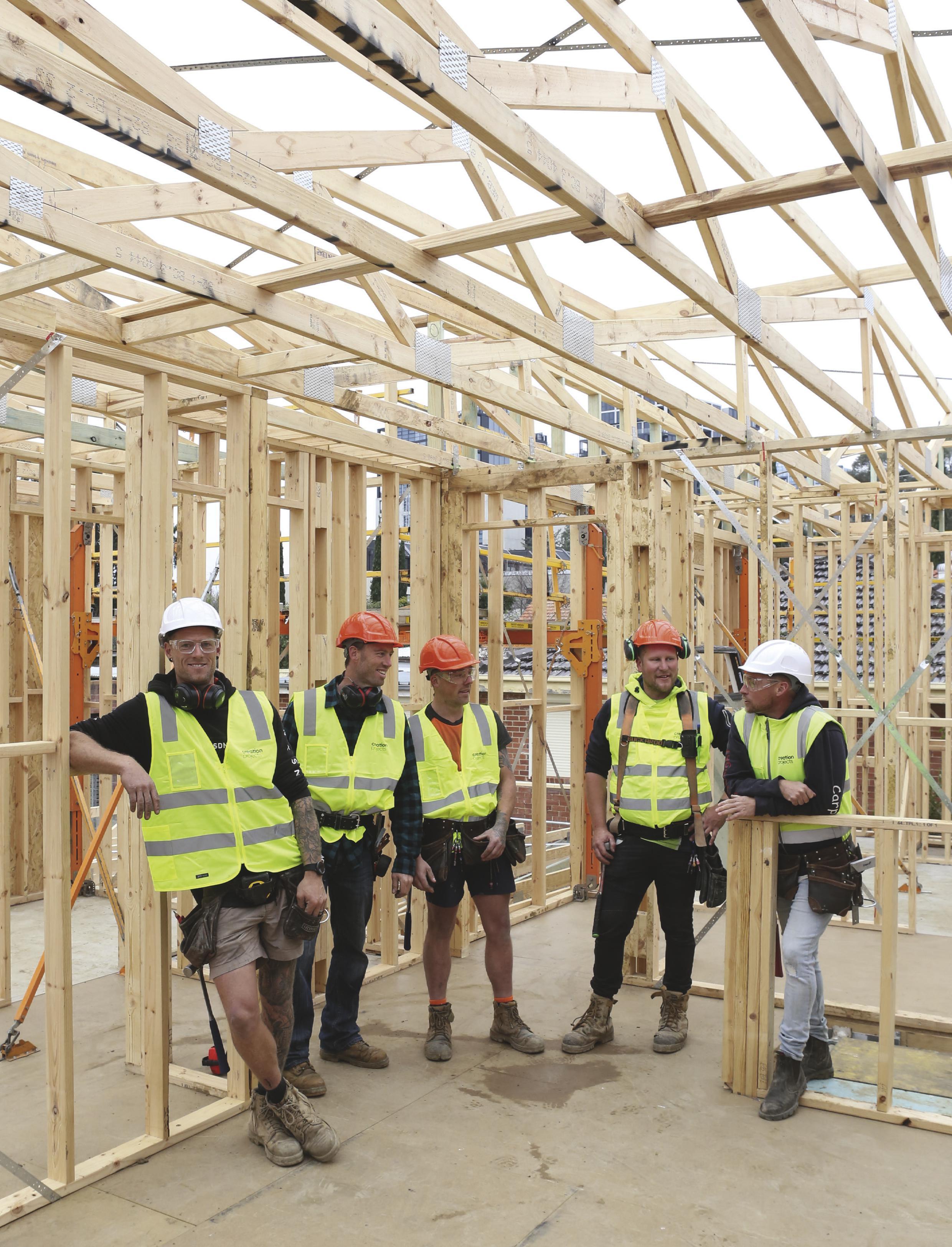
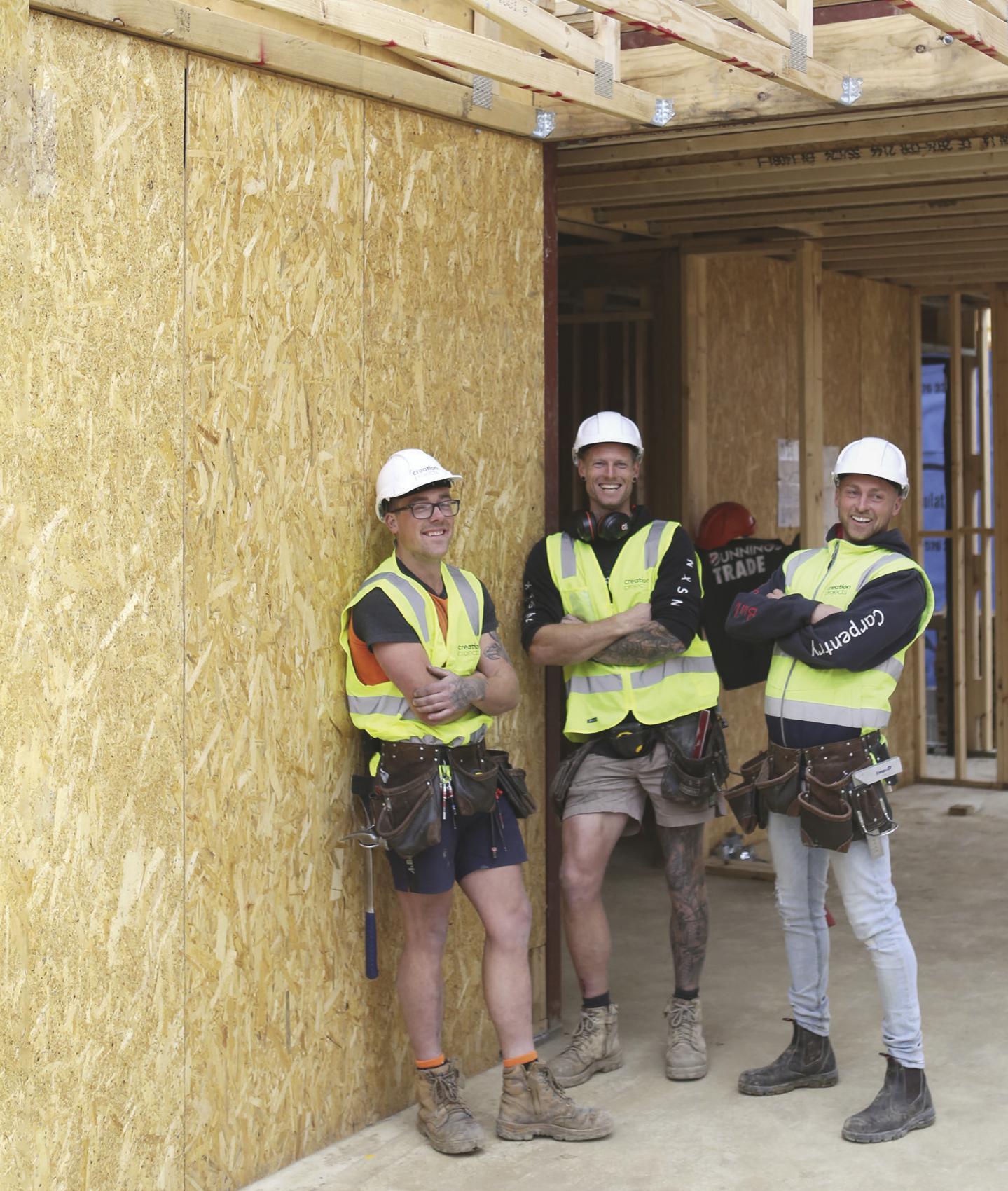
Reduces labour costs
Less hours onsite
Improves scheduling

Deliveries aligned to your build schedule
Superior quality control


Designed by engineers and manufactured by experts to meet Australian standards





Custom-made solutions

Allows for greater flexibility and complexity in designs
Eco-friendly


Less wastage of materials
If the speed and convenience of prefabricated framing isn’t enough to convince you to make the switch, the tech that comes with it might do the trick.
Frames supplied by Bunnings Trade’s Frame and Truss service arrive with a barcode attached. A quick scan with a smartphone pulls up a 3D diagram of the project being worked on, to show exactly where that frame goes.
“It’s the best thing ever invented,” Rhys says. “If you’re looking at where a window or a parapet goes, you just scan the barcode and then zoom in or zoom out and go: ‘Oh, okay, that’s how they’ve designed it, that’s where it goes’ and you assemble it like that... it’s wicked!”
Hand over your plans to Bunnings Frame and Truss specialists, who use software from Pryda Australia – a leading supplier of software, equipment and engineering in frame and truss manufacture – to handle the most complex designs and bring the build to life.
By sending all the architectural and engineering plans to an offsite fabricator, everything is built in a controlled environment and only arrives once it’s ready to be put in place.
“A normal double-storey stick-build can take about 10 days, but with prefab, when everything [needed] arrives on time, then that is about five days per house,” Matthew says. “We literally save 50 per cent on frame construction time as a result.”
Each frame gets checked again for accuracy onsite and can also be adjusted to fit in the case of uneven slabs or measurements being a bit out.
The same offsite production that speeds up install results in a more consistent finish, adds Creation Homes’ construction manager, Stefan Smilevski.
“Because the frames and trusses are made [by using the] shop drawings and then steel drawings, architects plans, engineering reports and whatever else is needed, it’s done properly,” he says.
“What arrives onsite is exactly what you need. With a good supplier, the frames and trusses that arrive can just be put straight into place.”
Although a prefabricated frame might be initially more expensive, Matthew says the bulk-buy option and the labour time-saving when it can be hard to find skilled trades in this area makes it worthwhile.
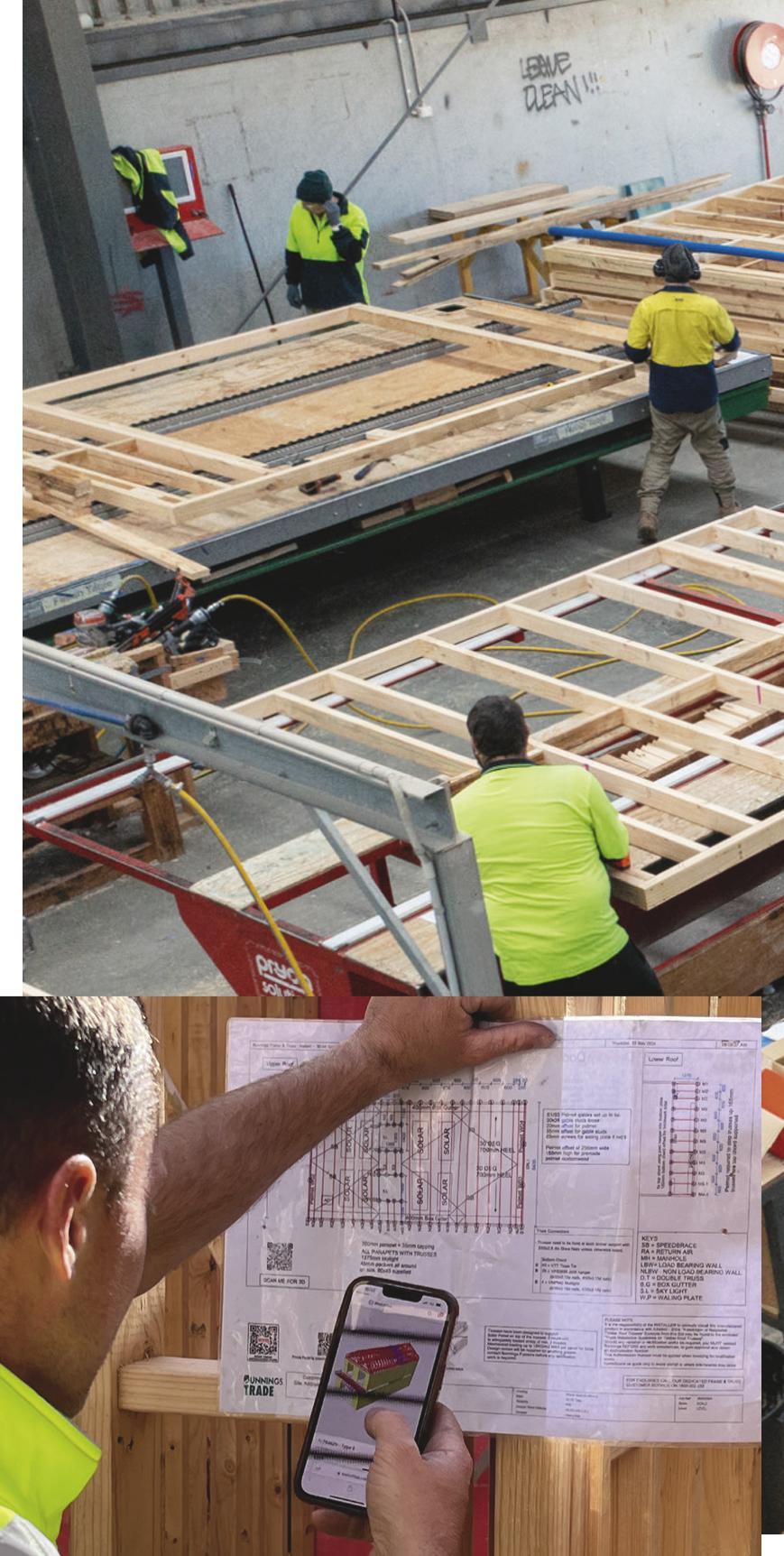
And while Rhys admits the labour costs for a stick-build might be a little higher on the surface, the time being saved in the long run also keeps his crew in demand on the job.
“You can punch out a lot of work,” Rhys says. “So you move on to the next job faster.”
The fact frames and trusses are pre-assembled means onsite safety improves.
“The use of power tools goes down massively because there’s just less of them required onsite, which is always a good thing [as it improves safety and noise levels],” Stefan says. “There’s minimal use of drop saws, for example, because the cuts are already done.”
Even something as simple as passing sticks to those assembling frames means less risk of possible injury. “There’s just less moving parts,” Rhys says.
Another huge improvement associated with prefabricated frames is the reduced waste.
Sawdust from drop saws, offcuts or incorrectly measured noggins no longer land in a skip. It also means less clean-up for the crew.
USING 3D IMAGING (LEFT) BUNNINGS TRADE FRAME AND TRUSS IS REVOLUTIONISING THE GAME FOR BUILDERS

This is a better bottom line for builders and installers, but also for the environment.
“Minimum waste means it’s definitely better from the sustainability side of things,” Matthew says, adding: “When you’re doing a big build, that’s important.”
An unexpected benefit from using prefabricated frames is a reduction in site theft. Simply put, the lack of spare sticks laying around means cheeky locals are less likely to help themselves to timber.
“LVLs (Laminated Veneer Lumber) beams are very expensive and you’re a lot less likely to get someone to come onsite to pull a frame apart and de-nail a beam versus just picking [a stick up] if it’s sitting on the ground in a packet,” Stefan says.
It all adds up to a shift in the landscape that those in the building game need to be aware of.
The decision to stick-build or use prefabricated frames and trusses will be affected by the individual circumstances of each job, but for Rhys, at least, he’s happy to move with the times.
“Would I go back to stick-build?” he says, “Not if I can help it!”
The Bunnings Trade Frame and Truss team of specialists is helping tradies save time and money with the service.
With prefabricated frame and truss plants in Victoria, NSW and Queensland, and partners in other locations to further support customers’ needs, Bunnings Trade is delivering on supplying high-quality prefabricated roof trusses, wall frame and floor-truss systems for residential and commercial projects.
It’s a service geared towards helping builders and trades by reducing labour costs, streamlining installation, accelerating project completion and improving onsite safety, and Stefan says it has opened his team’s eyes to new ways of working.
“At the beginning of a job we send through the shop drawings, steel drawings, engineering reports, and whatever else the Bunnings Trade team needs, then they send back a preliminary design for approval,” Stefan explains.
“It’s a pretty quick process and the communication to ensure we’ve got everything accurate and as per our plans is very good.”
The next step is agreeing on a delivery schedule.
“I’m in contact with the scheduling team and if I have deliveries booked with our traffic management people for 8am, they will usually arrive right on time or within a 30 minute window, which is really impressive,” Stefan says.
“As long as we’ve got the right site access and
have left [a location] to put the delivery, it’s here.”
And left in the correct order, Matthew adds.
“We stage the deliveries so we get the ground floors first, then the upper floors and then the trusses,” he says.
One of the other main benefits? Besides being a one-stop-shop and being able to easily manage your orders through your Bunnings Trade PowerPass account, the quality in craftsmanship of the materials – with Bunnings Responsible Timber Sourcing Policy applied to all timber used in the frames and trusses – gives the service a huge advantage over others.
“We’ve used Bunnings Trade Frame and Truss for a long time and the quality has certainly impressed,” Matthew says.
“It’s straighter and it’s more accurate, and it’s just a better-quality frame, so when the boys install it and you see the finished product, you can just tell when you’ve got a quality prefab frame.”

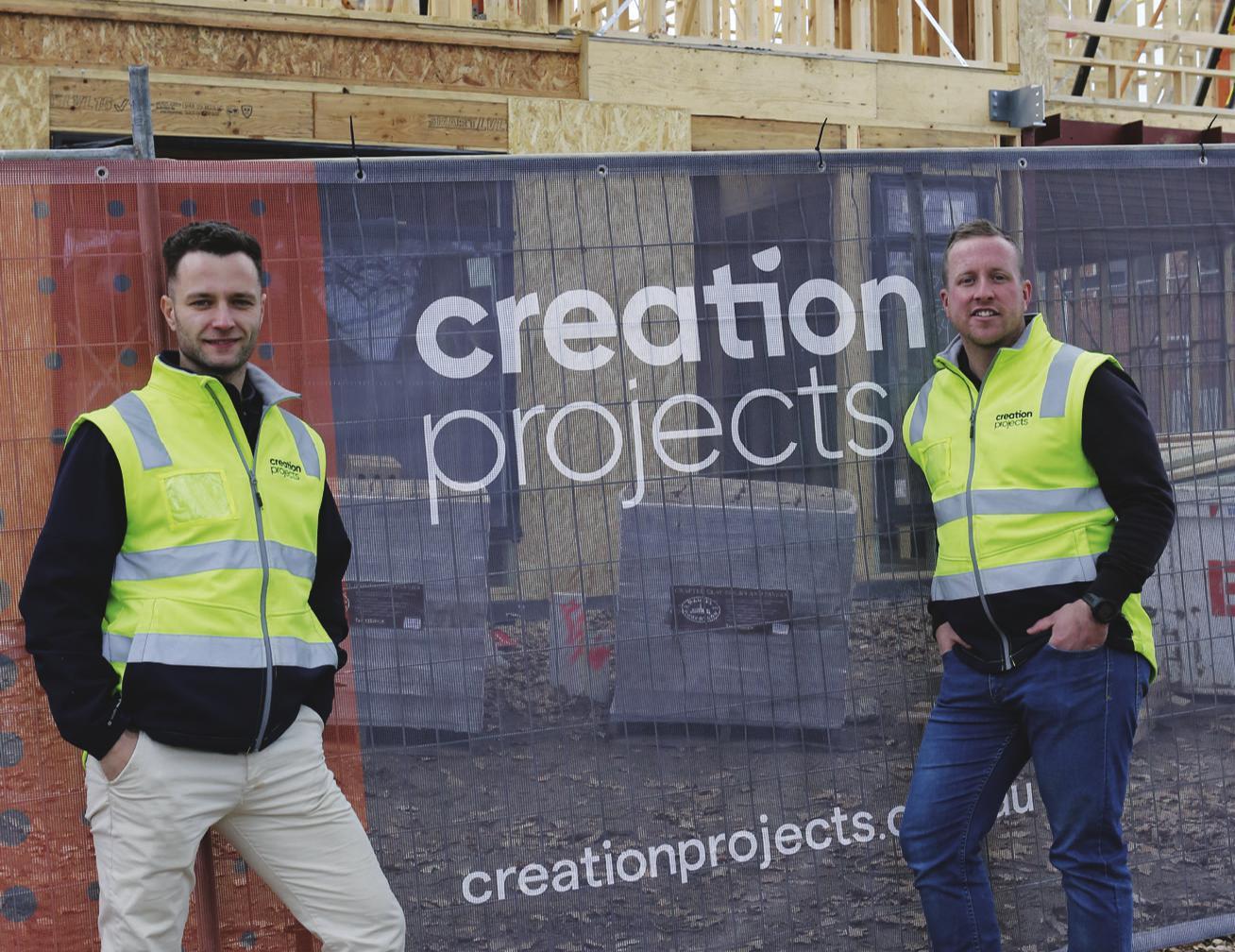
Did you know Bunnings Trade has three studio locations that are exclusive to PowerPass members and their clients, where curated product ranges can be found all under the one roof?
BY RENATA GORTAN
ome builders refer to it as the ‘secret side’ of Bunnings – state-of-the-art studios showcasing the latest innovations in whole-of-build and fitout solutions, ready for PowerPass members to use to their advantage.
Whether you’re a builder, developer, architect, designer or tradie, you’ll find Bunnings’ exclusive Building Solutions Studios (BSS) are dedicated spaces with a carefully curated selection of standard and premium product ranges, where value and maximising margins are front of mind.
BSS spans products and services across all building categories – residential and commercial – and is open to you and your clients to explore in three locations in Sydney (Castle Hill, pictured), Melbourne (Port Melbourne) and Brisbane (Cannon Hill).
We had a chat with Chris Nel (pictured at BSS with his wife and business partner Helen), a licensed builder and the owner of Astene Homes who moved to Australia from South Africa in 2013. Starting their award-winning boutique building company in NSW, Chris and Helen soon found themselves working on everything from project homes to custom-designed builds and recently completed a multi-unit, class 2 building. Chris says the one-stop shop of BSS has been instrumental in streamlining and supporting the business as it goes from strength to strength.
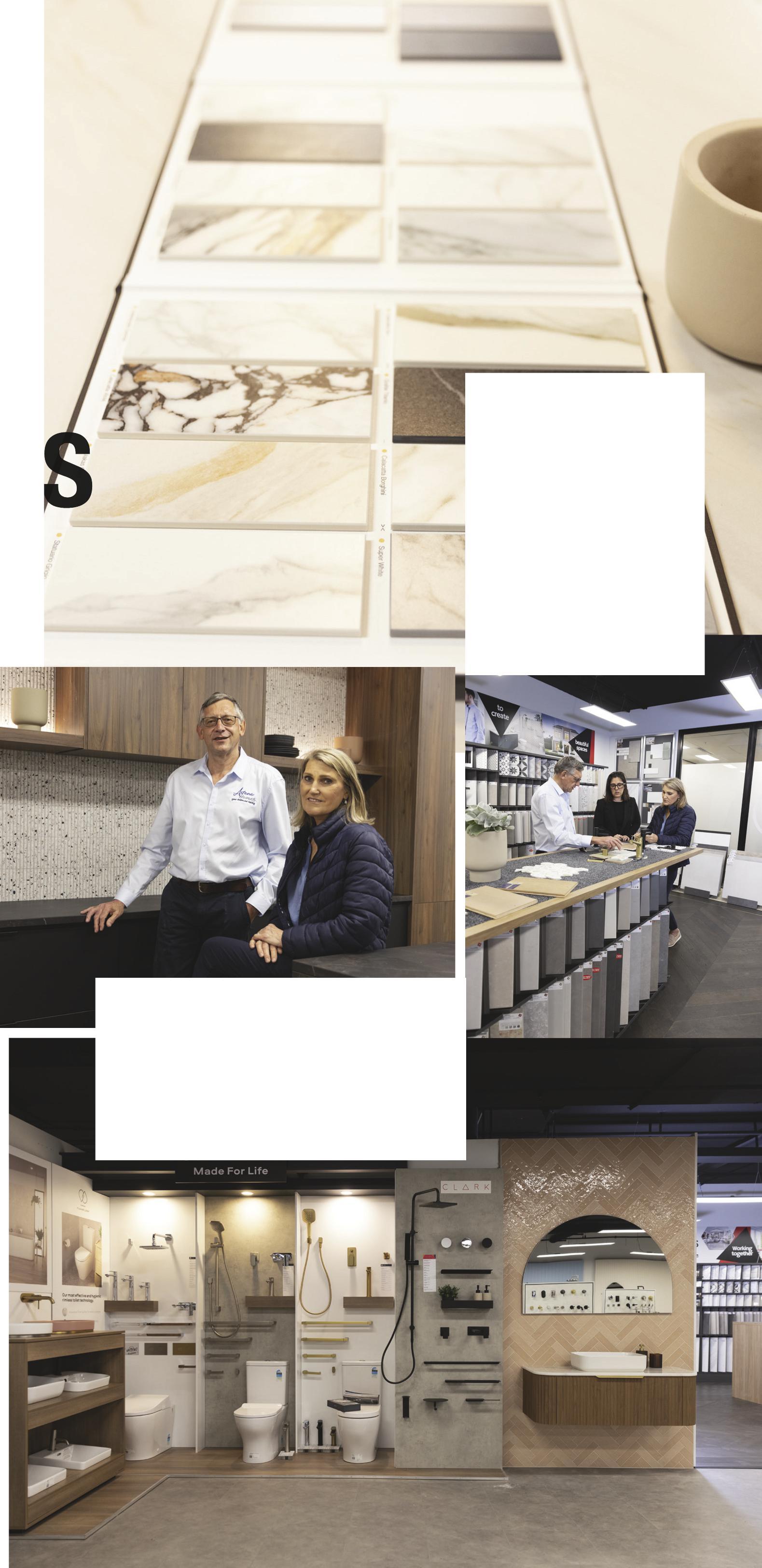

“What I like about it is they’ve got various items and products under one roof You can compare products, then you also compare as part of your colour selection. You can put your taps, tiles and your floors together, and it helps you visualise a lot,” Chris says
“When I have a design, I start visualising it At a selection centre with that variety, sometimes you see new things We selected tiles recently, and when we got there we saw two walls with tiled wall coverings and it changed our decisions. That is the benefit of a one-stop centre, you get a wider perspective ”
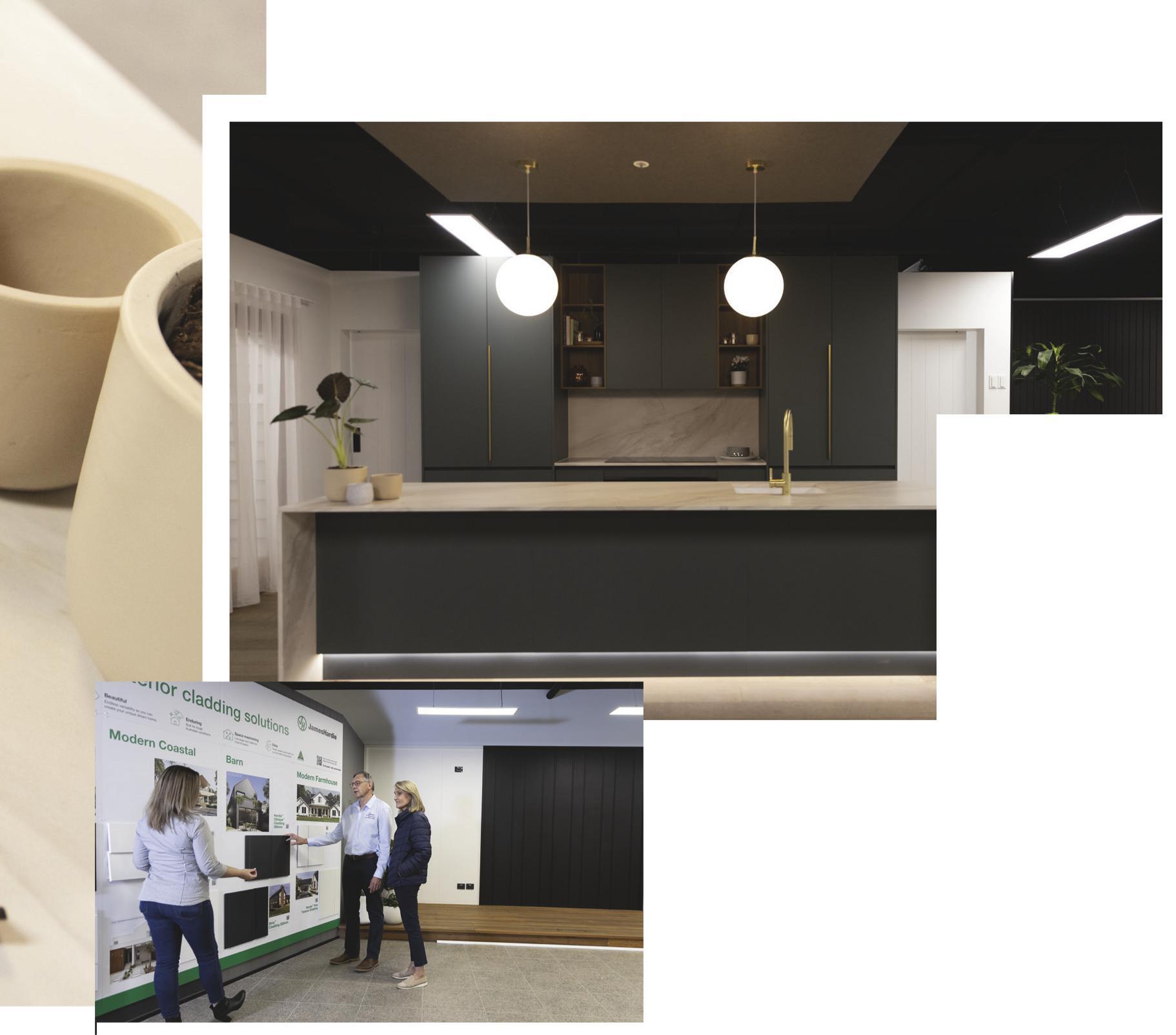
“I’m in a niche market and it’s not high volume, but Bunnings still gives me very competitive pricing. I wouldn’t get this kind of competitive pricing from everyone in the industry, especially when it comes to bespoke quotes for the big manufacturers in building ”
“My clients have a positive experience because BSS is a professional environment. They can select from a huge range of items. And now that Beaumont Tiles is a part of Bunnings, you’ve got a selection of floor coverings.”
“With a supplier such as Bunnings, it’s been fairly easy My business system integrates with theirs I can request quotes electronically, they respond and I can then create a purchase order. That businessto-business system integration makes me feel that I’m one of their most important clients, even though I am a boutique builder.”
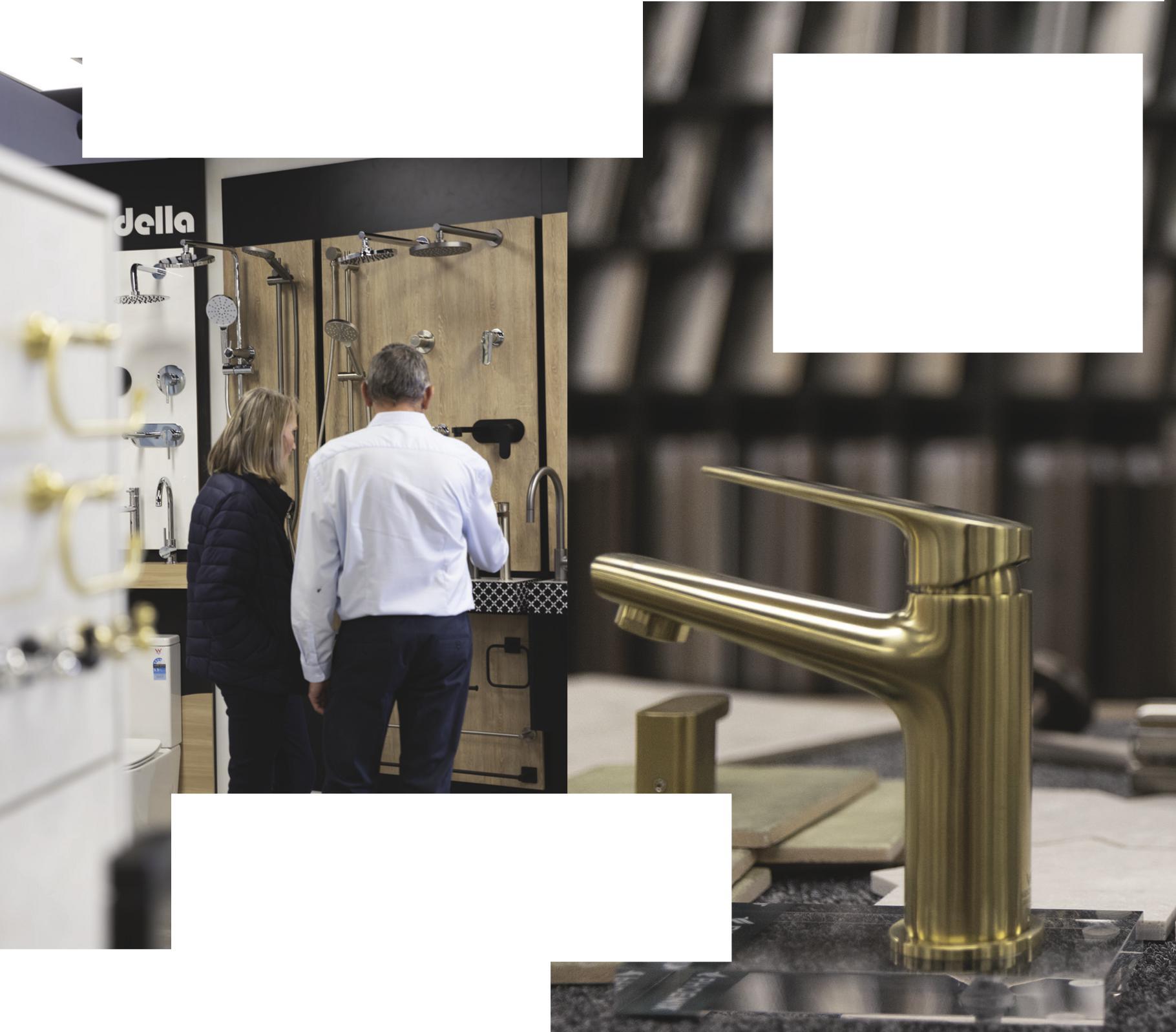
“It’s not a matter of going for tiles at one place and then thinking, ‘Oh, how will that fit into my tapware?’ You have it all under one roof. That to me is the success of BSS It saves me, and also my clients, a lot of time because they can come to the one spot ”

Building Solutions Studio is your one-stop shop.
PRODUCTS: There are more than 100 brands on display. The curated range covers all price points, from standard to premium.
RANGES: Everything from the initial slab to the final touches of kitchens to custom joinery, front-of-wall plumbing, external and internal doors, flooring, tiles, staircases, windows, appliances, assisted living ranges to meet SDA and DDA requirements and more.
SELECTION SERVICE: Bring your clients in to see how the extended range works together, rather than visiting multiple suppliers.
EXPERTISE: BSS offers expertise in kitchen design, front-of-wall plumbing and custom joinery with qualified teams available to help.
THREE LOCATIONS: Find the one-stop convenience of BSS in Brisbane (Cannon Hill), Sydney (Castle Hill) and Melbourne (Port Melbourne) with consultations by appointment only.

“We build high-quality homes and I believe the suppliers have a role to play in that Bunnings helps me with the right products and the quality of products is very high ”









Support with design solutions to achieve architectural specifications
















































































Thinking of developing a property, but not sure how to co-ordinate the materials and trades you need? Perhaps





























you could be looking for someone to do it all for you...
BY SCOTT ELLIS

Almost every builder or tradie has looked at a site and wondered if they’ve got what it takes to develop it themselves.
For some, the challenge of organising supplies, fittings and fixtures, and then getting them delivered on time and installed properly – within a reasonable timeframe – is one headache too many.
That’s what developers have entire teams of people for, right? Well, sometimes, but that doesn’t necessarily mean you need a team like that yourself.
Developer Colin Parkes made the move into the construction business from an accounting background more than 20 years ago. He quickly realised that one of the big problems builders generally face is the cash-sucking overheads: business development officers, build managers, supervisors and more.


Flexible credit terms
Fully warranted product and installation
Dedicated onsite



project management
Trade qualified installers (License numbers: QBCC 1191280, 186807C, BLD 248065)
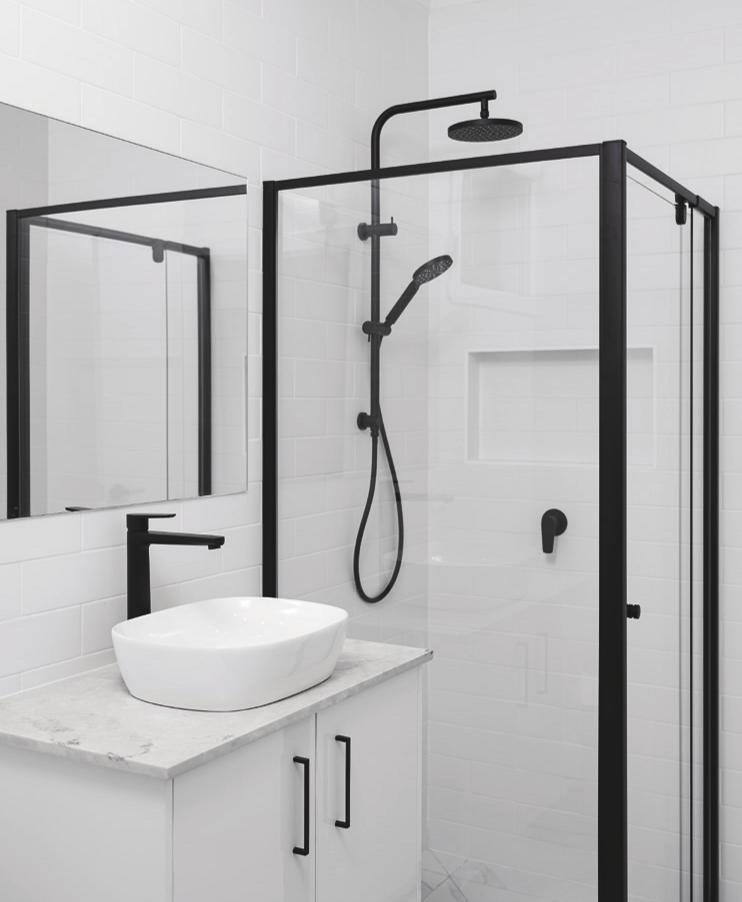
It’s like having a full build management team, he says, without actually having one.
From frames and trusses to windows, joinery and more, it all arrives onsite when he needs it.
“They ring me up and say: ‘Are you ready?’ and sometimes I’ll have to say no,” Colin says.
“And that’s great! Some other places you have to get on your hands and knees begging for the product to get there, these guys want to get it out and get the job done as quickly as possible.”
Juggling trades was a logistical pain point when he first started out as a developer. From plaster to flooring or even complex joinery like a kitchen, there’s an install option where teams who know the product well take on the job.
“Those overheads cost [money] and it’s got to be added to the project,” says Colin, the man behind boutique developer Gembrook in Victoria.
But what if someone took care of those overheads for you? After struggling through it all himself, Colin discovered the benefit of using Bunnings Trade’s Supply and Install Service – he’s now a decade into using the service and will never look back at the old way of working.
Contacting Bunnings Supply and Install from the moment he puts in a development application, Colin will let the team go over his plans, make suggestions where they think they should, listen to their materials and crew needs, and then leave them to deal with details and logistics.
“It just takes away a hell of a lot of the stress and worry that I’d have if I was having to deal with individual contractors,” Colin says.
It’s become a sort of business partnership, with Colin happy to point out if he sees a more efficient way to get the build done that works for him.
“They are a business partner of mine,” he says.
Contact Bunnings Supply and Install Service through the Bunnings Building Solutions Studios in Sydney (Castle Hill), Melbourne (Port Melbourne) and Brisbane (Cannon Hill) or your Account Manager.

SCAN HERE to learn how Bunnings Trade Supply and Install Service can benefit you and your business.






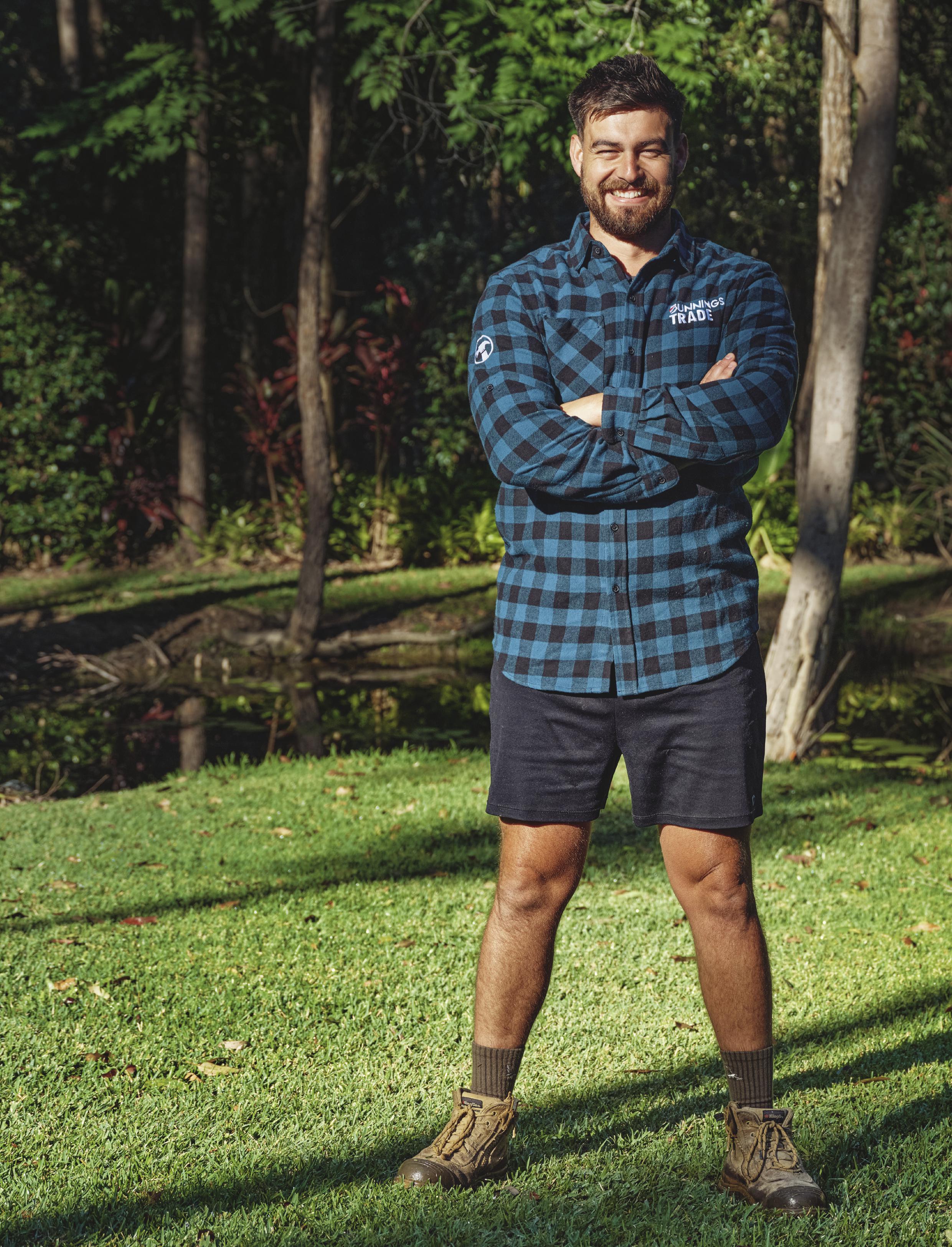
Starting a business is a huge undertaking, as busy landscaper Peter de Beer knows. He shares the lessons he’s learned – from the fails to the triumphs – to ensure his business continues to thrive and grow.
BY ERIN MCWHIRTER & ANGELA TUFVESSON
Small business owner and landscaper
Peter de Beer is a master juggler. From keeping his admin and financials organised, to managing clients, sending out quotes, mentoring and guiding his team, as well as working on the tools, his daily list is quite hefty (and that’s just for the on-the-job tasks). You know the drill.
“It’s a constant juggle to stay on top of everything and it’s crazy busy managing your own business, as it’s all on you,” explains Peter, who runs landscape construction company PWS Gardens in Brisbane’s north and employs five tradies.
in massive debt and broke. I’ve taken wise risks – that’s part of the fun of it – and they taught me so much. That means buying machinery that costs more than you want to spend instead of the cheap rubbish; I admit I’ve made thousands of mistakes doing that in the past.”
The structural landscaper says that he would have saved $100,000 or more if he’d had a bit of mentoring in his early years as a business owner.
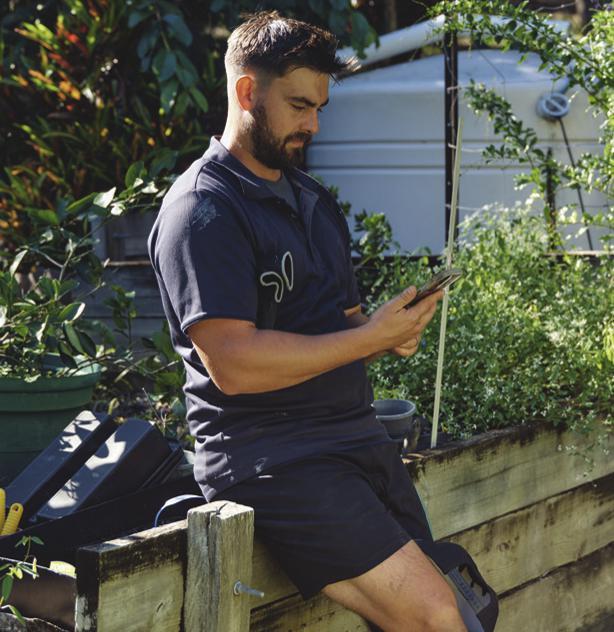
I try to talk to as many people as I can, not just from my business area. I intently listen and take in their advice... right now, on rainy days, I’m talking to people about the way I quote.
SMALL BUSINESS
OWNER, LANDSCAPER PETER DE BEER
“I want to do the best I can for clients, and staying on top of it all is a challenge. I started off mowing lawns after I finished my apprenticeship, just to see how far I wanted to go in the industry with my own business. I didn’t take a salary for four years, which seems crazy now. I just saved and saved and saved to see how big I wanted to grow.”
“If I hadn’t started small, I wouldn’t be where I am now,” Peter says of starting from the ground up, taking risks and making mistakes. Just recently he quoted one of his biggest jobs for more than six figures, thanks to networking and positive word-of-mouth recommendations.
“Most people will take out a huge business loan when they start, but I would have been
“Now I try to talk to as many people as I can, not just from my business area,” Peter says. “I intently listen and take in their advice. I meet up with three multimillionaire business owners every so often to get ideas. Right now, on rainy days, I’m talking to people about the way I quote and my marketing to attract the right customers we want to work with.”
Getting caught in “sticky situations” due to limited access to his jobsites means Peter and his team need to have the right machinery to carry out their work safely and efficiently.
“Making an investment in the right equipment has saved me time and money when moving in tight spaces,” he says. “A lot of the homes we work in have 600mm to one metre down the side – we need tiny access machinery that can turn on a dime. I have two mini-diggers and a scissor lift, and my mini-compactor is the best thing I ever bought online – it’s saved me on so many jobs because I can carry it straight in.”
Keen to stay on top of what’s happening in landscaping? Here, business owner Peter shares the trends he’s noticing onsite.
While Peter is constantly researching the latest innovations hitting the market globally – “I am forever reading, checking out nurseries and attending conferences” – he is also seeing it with his own eyes every day. One such movement is that his clients are gravitating towards eco-friendly materials.
“We are doing a lot of composite retaining walls at the moment, made from 88 per cent recycled plastic and wood,” he says. “The SSR sleepers also have solid steel reinforcement. It’s very popular because they are lightweight; it saves people money on labour – which is something we tell our clients when working with them. It’s the way of the future.”

“White is just going off the charts – a lot of Greek-look gardens with that classic curved white aesthetic.”


SCAN HERE to find out more about how Bunnings Trade’s Landscape Specialist team can help you.

“There’s a big trend towards silvery blue mixed with a Monument-colour backdrop.”
“We’re seeing a shift away from concrete to composite materials.”
LANDSCAPE SPECIALIST SIA “ORGANISES DELIVERY AND CONTACTS FOR ME WITHIN THE STORES,” PETER SAYS. “I WISH I USED [THE SERVICE] EARLIER”

Without the efficiency and help of his ‘extra pair of hands’ –Bunnings Trade’s Landscape Specialist team – Peter says he’d be lost.
Bunnings Trade’s Landscape Specialists offer end-to-end project support for landscapers across the country. They can supply a huge range of landscaping products for all types of jobs, including plants and green life, turf, retaining walls, decking materials, pavers, drainage, fencing, screening and power tools. They source products, manage quotes and organise delivery (from Bunnings Trade and with third parties, if required).
Over the past year, Peter estimates Landscaping Specialist Sia has helped him save tens of thousands of dollars and eight to 10 hours a week on phone calls. “To be able to deal with someone like Sia takes a lot of responsibility off my shoulders,” he says.
Peter works directly with Sia via email, call or text.
“I’ll send Sia a list of products that I’m interested in – for example, 20 bags of green Bastion concrete, 40 hardwood posts and some sleepers – and I’ll ask for the best price and whether she can do it from the store that’s closest to the job,” Peter says of the team’s ability to quote on bulk quantities. “She often knows of a new product or has a suggestion that may work better – and at the same time she saves me money! It really has changed my business.”
Such is the nature of the job, says Sia, who looks after customers spanning 12 Queensland Bunnings stores between Brisbane’s northern suburbs and Bundaberg, that quote requests can be last minute.
“One of my top customers has just rung me and said they need two first-up deliveries tomorrow – he’ll have guys at both sites – and he wants the product there ready to go,” she says. “People often need items organised quickly. We look after them, and they keep coming back.”
Peter admits it took him the best part of five years to really figure out the structure of his business as it grew. He says working with Sia takes the edge off running a small business.
“I wish I did it earlier!” Peter admits of Bunnings Trade’s support service, which is now available nationally. “If I didn’t have Sia now to help me manage the day-to-day, I don’t know what I would do because a lot of the time I would literally be hand-loading into trucks – she organises it so forklifts are ready. She knows how our business works and every Bunnings product. Things change all the time, and Sia quotes quickly and makes sure that the product is ready to go for each of the three or four jobs I’m running at any given time.”
The Landscape Specialist team can source directly from suppliers, too, which means less stress and more money in Peter’s back pocket.
“We do a lot of retaining walls, and Sia can often get everything direct from the supplier, which saves us on freight costs,” he says.

“TO BE ABLE TO DEAL WITH SOMEONE LIKE SIA WHO KNOWS EVERY PRODUCT, KNOWS ALL THE DETAILS, KNOWS HOW WE WORK... IT’S JUST SO EASY,” PETER SAYS


She went from running a travel agency in tropical Queensland to becoming an Adelaide local. Team Member Kate shares how her love of plants put her on a path to becoming a Landscape Specialist.
I love being a Landscape Specialist because…
Have you ever met an unhappy gardener? I chose to move to Adelaide because it’s the greenest city in Australia – the one with the most parklands and conservation parks. I studied horticulture and conservation and worked on the register at Bunnings. As soon as I heard about the Landscape Specialist role, I knew it was what I wanted to do. There’s so much diversity in the role and I get to interact with so many different people every day.
My passion for landscaping began...
I feel like it was inevitable. When I was a child, we lived next door to an artist who painted beautiful landscapes. I have fond memories of their Dutch house with an indoor atrium full of plants. Then, as a teen, one of my parents had a wholesale plant nursery and the other owned a landscape design business.
The tool I use most in the garden is... my Felco secateurs. My dad always said: “Invest in quality tools and they will last you a lifetime.”
The types of customers I serve daily are... everyone from landscapers and fencers to general maintenance people that do lawn mowing. Some of my customers are sole traders while others are commercial-scale businesses.
The best part of my job is... aside from getting paid to do something I love, is working for a company that cares about its people, the community and the environment.
A design trend I am seeing in landscaping lately is... the use of composite materials and low-maintenance, durable and sustainable materials. More people are using them for decking, cladding, retaining walls and fencing –so many things can be made out of these materials. They’re affordable and better, and they’re going the distance.
One of the best innovations in landscaping I am most looking forward to is... xeriscaping – or sustainable landscaping – native plants, smart technology for water conservation, water tanks, grass-free lawn alternatives and eco-friendly and low-maintenance gardens.
KATE’S TOP BUY
Felco 2 Original Secateurs, I/N: 3358858


POWER UP
“If you’re up against a big job, a petrol tool will get through the work quickly,” says David Youhaneh, a Jim’s Mowing franchisee.
The latest information on new-release products, reviews and topical trend forecasts.
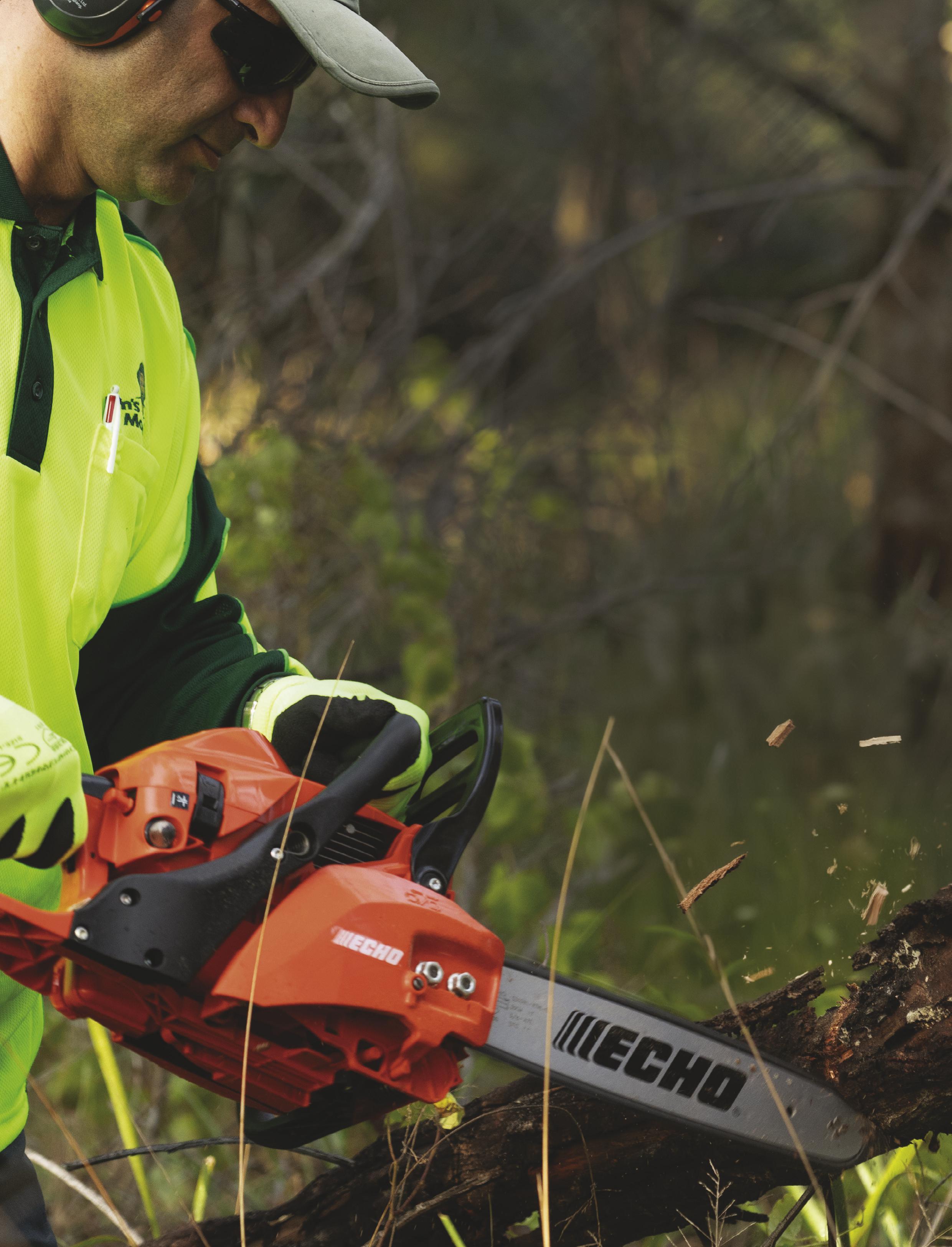
FAST WORK
Petrol tools might not be as quiet as electric, but they’ve come a long way, David says. “Also remember, you’re not using the tool as long.”
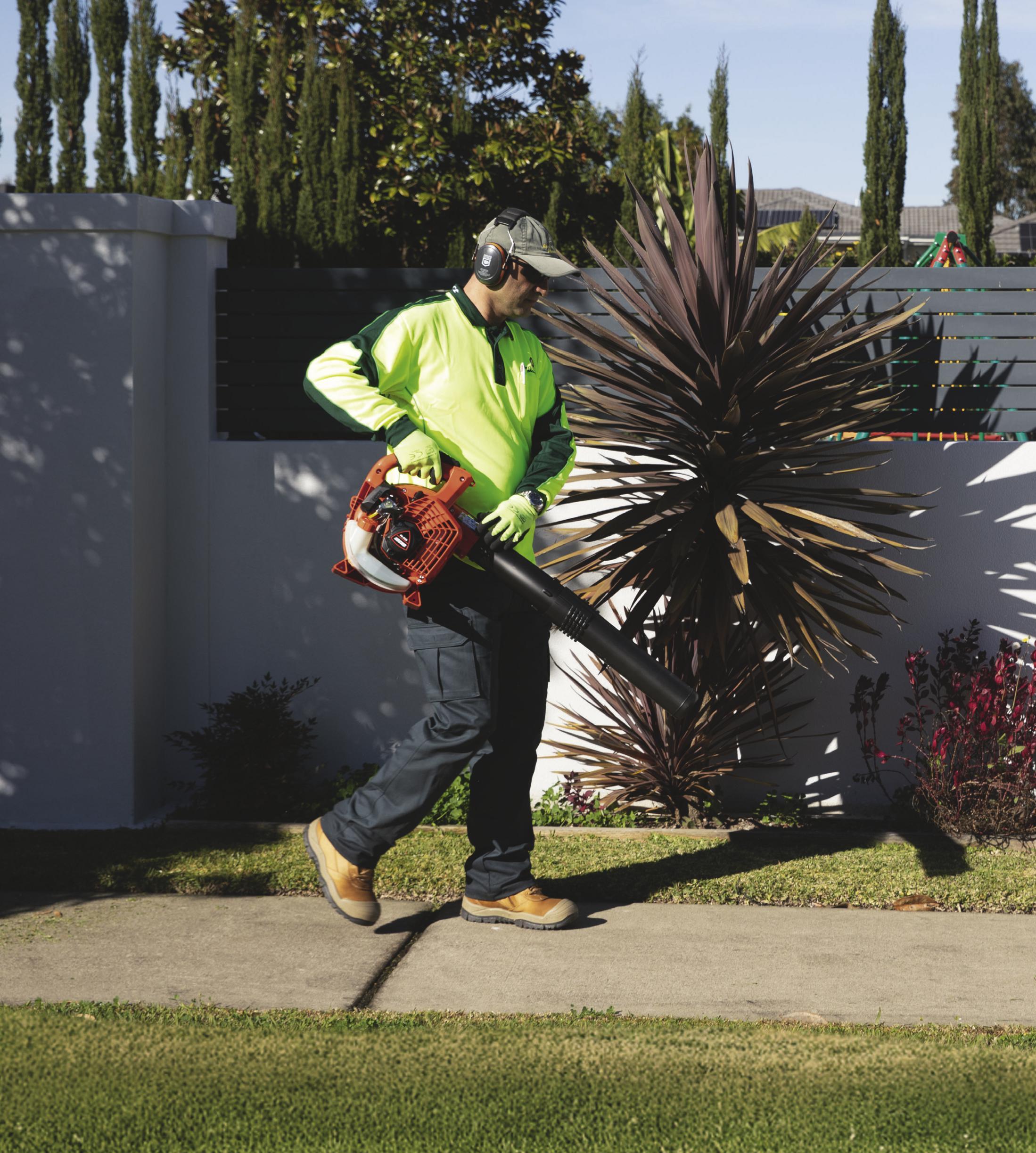
It’s the debate dividing lawn and landscaping jobs around the country – when it comes to tools, is petrol or battery the best for the job? While there are benefits to both, depending on the task, petrol is still around for a reason.
BY SCOTT ELLIS
You’re on the landscaping hustle. You’ve always used petrol, but battery-powered garden tools are making major inroads. One mate is saying petrol is the way to go, the other is saying battery is a no-brainer. But when it boils down to it: is the new tech better than going old-school – or is there a place for both?
Fans of electric tools will tell you how light and easy the latest battery equipment on the market is, but those with the petrol versions insist you can’t beat the traditional motors for power and reliability.
And while the choice ultimately comes down to which task you need the tool for – let’s face it, it’s impossible to say one or the other will be perfect for everyjob – Jim’s Mowing franchisee David Youhaneh often opts for petrol-powered. “Petrol tools have the power to get things done!” he says
Tackling overgrown gardens and lawns has been David’s speciality for eight years and it’s normal for him to take on half a dozen jobs a day. With each job presenting its challenges, David says it’s important to have the strength of a petrol engine ready to go.
“Petrol just has more power,” he says. “For a lot of homeowners doing something around the house, battery tools are fine, but when you come up against a big job, you want to know you can get on with it.”
“Petrol tools stay powerful all the way, unlike a battery that will run out and slow down,” David says. “On a job that has wet grass, heavy branches or a lot of brush to get out, the power from the petrol engine will go through that a lot easier than batteries.”
One key factor in using petrol over battery for David is the sheer convenience of knowing if he runs out of power he can refuel in moments, not hours.
“I have two petrol cans; one is five litres with two-stroke mix and the other is 10 litres unleaded, and that’s all I need to make sure all of my tools are ready to go,” David says.
“If one runs out of fuel I can refill straight away. If battery tools run out, that’s it until I can charge again. Plus, you have to think about them every time you come home after a long day at work – take all the batteries out, recharge them and then repack them – and I have enough to do already!”
Even if you ignore the increased power and torque of a petrol-powered tool, having the one power source is a huge weight off David’s mind when he’s out on the road going from job-to-job.
“A big advantage is I know it’s easy for me to get petrol anywhere, but it’s sometimes not easy to recharge a battery,” he says, adding: “So, that’s one less hassle for me to have to worry about when I’m also running a business.”
“Petrol engines are not as quiet as electric, we all know that,” David admits.“But they’re not as loud as they used to be, that’s for sure. And anyone using these tools knows they have to have the right safety equipment, like ear muffs. Also remember you’re probably not using the tool for as long.”
David says this is because the powerful motor of a petrol-operated tool cuts through jobs quicker. With brands such as ECHO making advancements in their tools, including reducing emissions for the

The grunt of petrol for bigger, time-sensitive jobs can’t be beat

ECHO 350mm 34.4cc 2-Stroke Petrol Chainsaw, I/N: 0457340
“I like this chainsaw, it’s a little weapon!” David says. “It’s a great size and small enough to be easy to use, but still powerful and strong enough for commercial purposes. It goes straight through the wood – a very handy tool.”
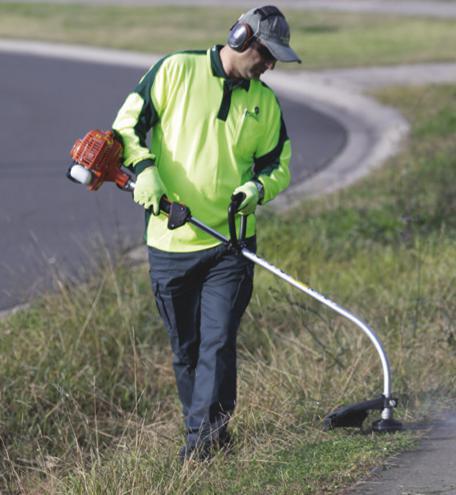
ECHO 21.2cc Curved Shaft Line Trimmer GT-222ES, I/N: 0087561
“I’d never used this before and it was very easy to handle and use,” David says. “I think this would be perfect for using around the home, or for lighter jobs. The curved arm actually makes this very good for doing the edges.”
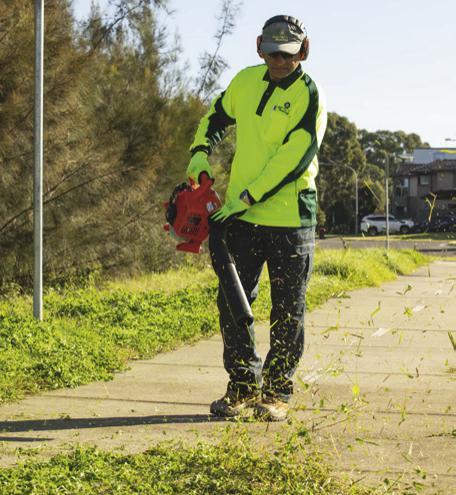
ECHO 25.4cc Petrol Blower Vac, I/N: 0232291
“It’s a really good blower. Handheld and, again, very easy to use,” David says. “It has lots of power to move leaves or clippings, and the vacuum is good, too. Plus, the curved blower tube has rotational control, which helps reduce fatigue.”
For most of my tools I’ll stick with petrol. It’s easier to go through big branches with ECHO than with electric tools.
YOUHANEH
latest 350mm 34.4cc 2-stroke petrol chainsaw and increasing the torque on the 21.2cc curved shaft line trimmer (both of which David used for this story), a lot of the arguments against petrol tools are losing their momentum. You’re also running them for less time, according to David.
“If you’re up against a big job, a petrol tool will usually get through the work very quickly,” he says. “That means you can go on to another job.”
David acknowledges that battery-powered tools have their place in a landscaper’s arsenal.
“For a quick job, such as a small hedge or edging, battery-powered tools can be an easy alternative,” he says. But petrol is still his go-to.
“For most of my tools, I’ll stick with petrol,” David says. “It’s easier to go through big branches with the ECHO than with electric tools.”
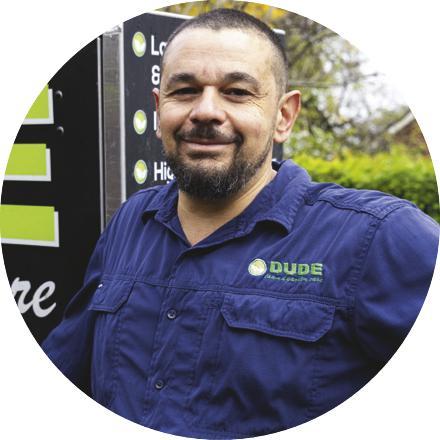
1
Battery tools are quieter with less vibration. “That’s been a major improvement in using battery over petrol,” Eduardo says of the noise and vibration reduction. “I’d never go back to a petrol trimmer. A batterypowered one is lighter and has better balance.”

Eduardo Pasotte of Dude Lawn & Garden Care in Sydney reveals five reasons why there’s a place for battery tools in the garden.
2
Time savers. “I use mostly battery tools – except for the mower because the power doesn’t compare,” Eduardo says. “But when I started replacing my petrol tools I found battery handy to use because you don’t need to turn them off all the time.”
3
Less stress on the mind and body. “Petrol chainsaws are loud – they’re right there in your face as you work, every day, and that’s tiring,” he says. “Using the battery-powered chainsaw is way quieter and generally it’s lighter, so it’s easier to use than petrol.”
4
No petrol needed – just charge up. “People say we go through a lot of batteries in our line of work, but we go out with six batteries, which we rotate and charge while working,” Eduardo shares. “They can be expensive upfront, but you save money on buying petrol.”
5
Less mess and general upkeep. “There are no fumes, less noise and it’s easier to carry when working,” he says. “Battery-powered tools are also less messy with less grease and dirt. You still have to lubricate electric tools but nowhere near as much.”

As far as tool storage solutions go, Kincrome’s BLUESTEEL® products are hard to beat. Now, they’ve added a monster to their range that’s worth a look.
BLUESTEEL® TOOL TROLLEY 9 DRAWER 41”, I/N: 0633323*
Time to roll out the big guns with a bad boy of storage. This trolley isn’t nicknamed ‘The Beast’ for nothing!
WHO IS IT FOR?
If you love your tools, this is for you. A great choice for mechanics to hold spanners, sockets and drivers.
WHAT ARE THE SPECS?
• Reinforced heavy-duty outer steel chassis and UV-stabilised powder coating
• Twin gas strut lid support
• Nine drawers, all compatible with Kincrome box and EVA trays
• 45mm ball bearing drawer slides with Automatic Drawer Retention System (ADRS)
• Full keyed security with Internal Rear Drawer Locking System
• ‘Big Grip’ drawer handles and heavy-duty side carry handles
• Nine EVA foam drawer liners
• Easy-roll swivel casters (two are lockable)
• Part of the BLUESTEEL® Modular Storage System
• Weight: 87.9kg
• Dimensions: 1127mm x 850mm x 535mm
IS IT ANY GOOD?
The trolley is a complete tool storage solution that can easily be rolled through your workroom to the job at hand, but you’ll need a fairly large dedicated space to park the trolley when you’re not using it.
BLUESTEEL® HUTCH 1 SHELF, 41”, I/N: 0633321*
The fully lockable hutch keeps vaulable tools safe and also has perforated backing, perfect for hanging hooks.
WHO IS IT FOR?
This extends the storage for anyone with an existing Kincrome BLUESTEEL® Tool Trolley and offers a handy option for putting away any larger tools.
WHAT ARE THE SPECS?
• Compatible with the Kincrome storage range
• Purpose-built in matching Kincrome BLUESTEEL® colour and size
• Reinforced heavy-duty outer steel chassis and UV-stabilised powder coating
• Twin gas strut lid support
• Pegboard backing for hanging tools
• 20 hooks for the pegboard
• Adjustable internal shelf
• Power access grommets
• Fully lockable for security
• 41-inch steel hutch
• Weight: 47kg
• Dimensions: 1135mm x 560mm x 563mm
IS IT ANY GOOD?
The hutch is a match made in heaven for the existing trolley and will take your tool storage to the next level. The extra length means more space is needed to park the trolley between uses and added weight makes the combined trolley system heavier to move around.
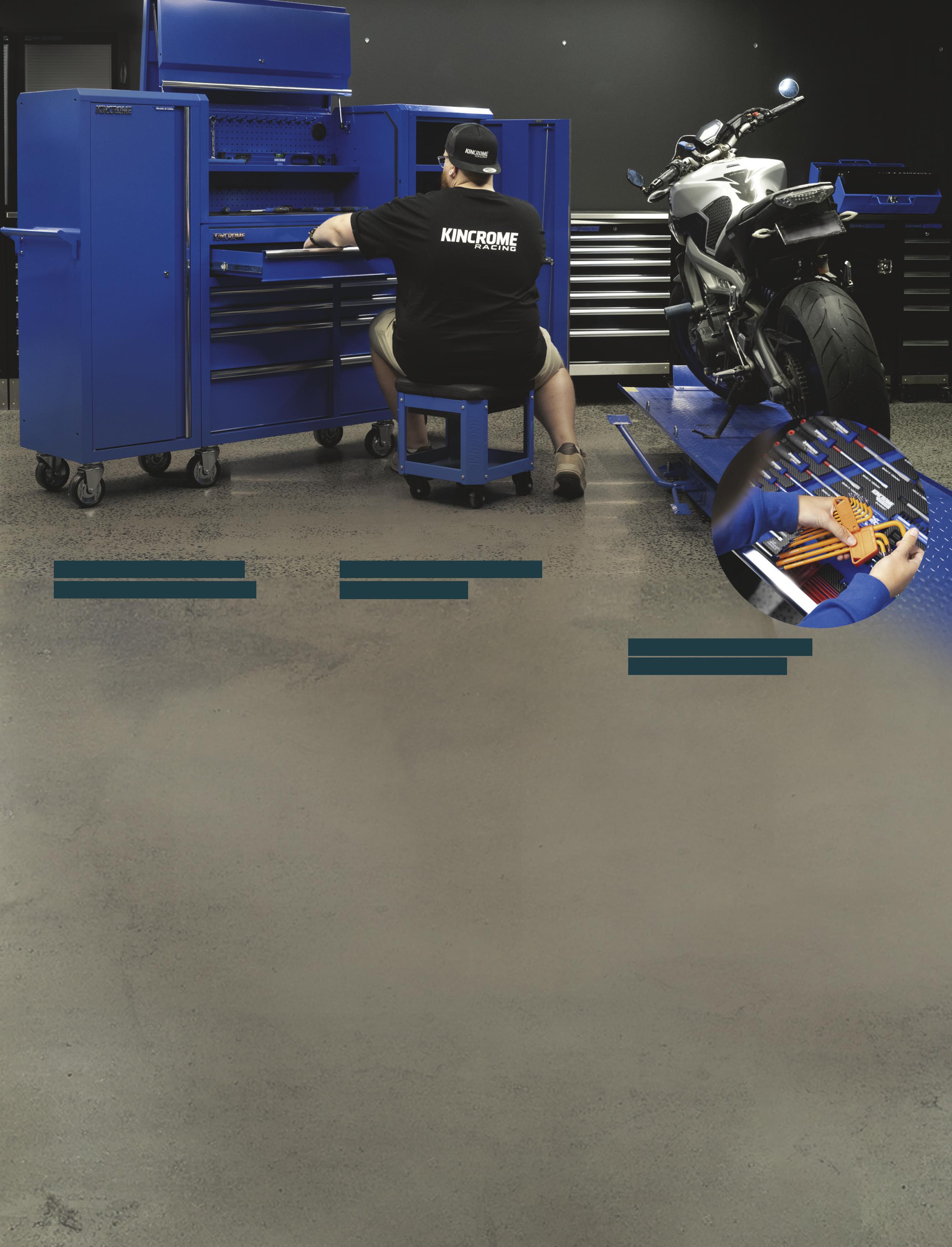
Fill the drawers with anything from spanners to Allen keys
BLUESTEEL® SIDE LOCKER 4 SHELF, I/N: 0633320*
A solid, lockable cabinet that will attach to either side of your Kincrome BLUESTEEL® Tool Trolley.
WHO IS IT FOR?
With four moveable shelves within the locker, it’s versatile for tools of all shapes and sizes.
WHAT ARE THE SPECS?
• Compatible with the Kincrome BLUESTEEL® storage range
• Purpose-built in matching Kincrome BLUESTEEL® colour and size
• Reinforced heavy-duty outer steel chassis and UV-stabilised powder coating
• Fully lockable for security
• Reversible door for left or right opening
• Four adjustable shelves
• ‘Big Grip’ drawer handles and heavy-duty side carry handles
• Weight: 43kg
• Dimensions: 553mm x 1360mm x 593mm
IS IT ANY GOOD?
The side locker offers deep shelving and enough height to store large tools or products, but can be heavy to relocate, especially if combined with the new trolley.
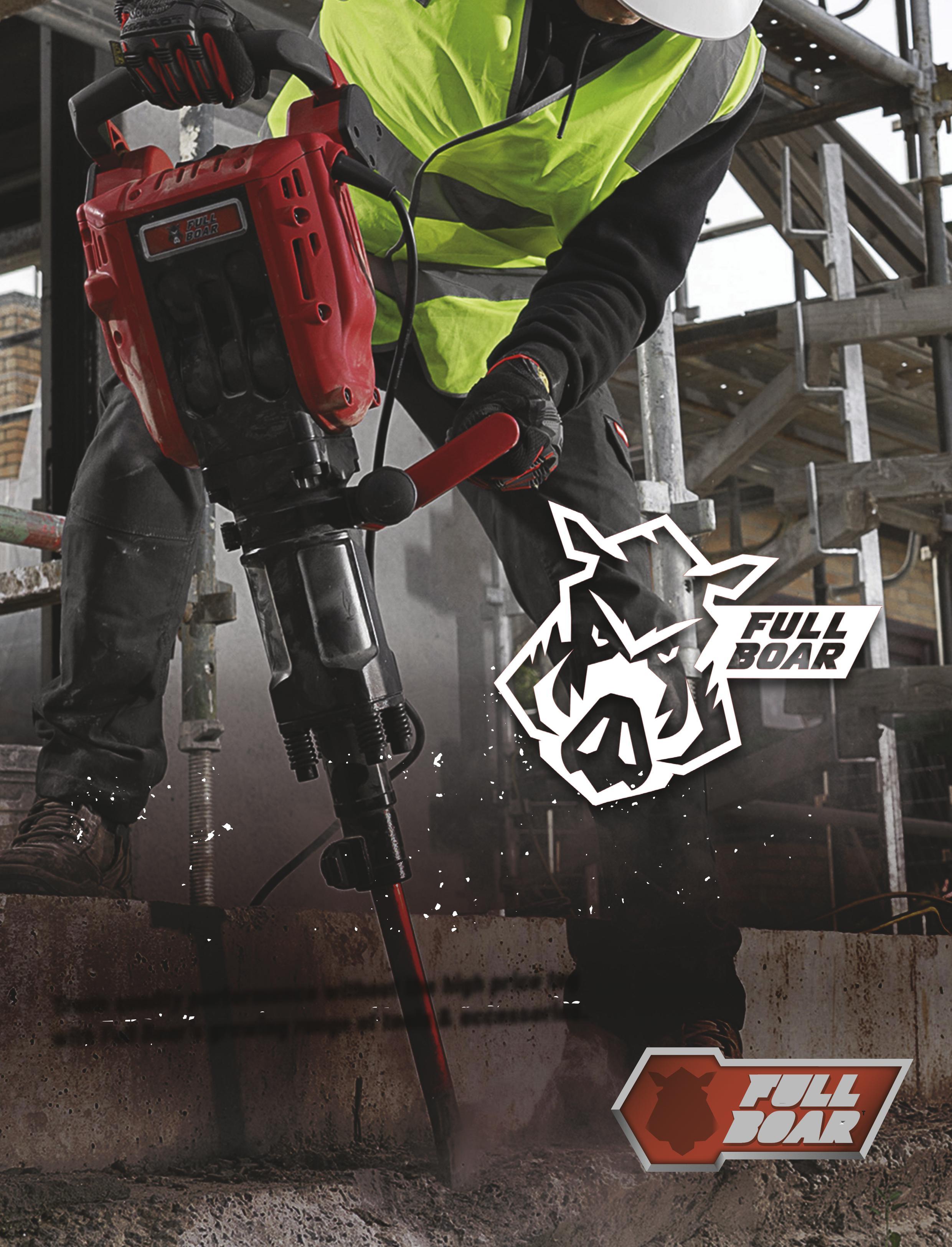

Technology is changing the tiling industry. Here are the trends tilers need to know.
BY SCOTT ELLIS
With Beaumont Tiles now part of the wider Bunnings Group, tilers can benefit from the specialist knowledge and extensive range Beaumont has been providing for more than 60 years.
It’s an important connection as advances in technology are changing the tiling industry, says Beaumont Tiles expert Rachel Gilding. From new manufacturing methods that save time and money to tile size, tiling is evolving.
“Knowing what’s coming can give a real competitive edge to a tiler,” Rachel says. “By being up-to-date with the market, they show their customers they’re a leader in their space. It also helps when they’re on a jobsite and there’s something new – [it means] they don’t have to stop and learn how to use it. Staying on top of trends and products is a huge opportunity.”
So, what’s new? Rachel breaks down the trends...


IF YOU’RE A TILER, KNOWING THE LATEST MARKET TRENDS IS A MUST
“The first of the current design trends is a return to basics,” Rachel says. “A connection to place and country is super important with the Australian lifestyle, so we’re seeing colours that reflect our immediate location and also embrace our indoor/outdoor living. That means a lot of earthy-coloured tones, organic shapes and textures.”
“There’s a lot of retro-modernist motifs, pops of colour, floral embellishments, terrazzo and even coloured marble coming through, which is great,” Rachel says.
“Aussies are a bit reserved when it comes to interiors but we’re seeing bathrooms where they have introduced colour, texture and some marble.”
“New manufacturing methods are making it harder to tell imitation products from the real thing,” Rachel says. “Terrane Marble, Pompeii Travertine and tiles with a reactive glaze that create a highlight feature can have depth and dimension like you see with real marble or stone, even how they have a bit of a shimmer to them or might have surface details you can feel.”
Those same tech advances have also changed the way tiling can be used in our houses, Rachel says, with Microtec glazing a great example.
“Microtec is a slip-resistant glazing applied before firing that’s smooth to touch dry, but when it’s wet it activates a high-performing slip-rating so you can use the same tile inside and outside,” Rachel explains.
“That allows people to have the same flowing look from the front porch right through to their outdoor alfresco areas.”
Thinner tiles are coming onto the market, which is a big tick in sustainability because they use fewer resources to produce. It also means less weight and the chance for tiles to be laid in places they previously couldn’t.
Even design composition of the way tiles are laid has changed, Rachel says, with popular chevron and
herringbone styles being joined by French pattern and crazy paving, a mixture of different size tiles in the same area to create a unique look.
But it’s the size of tiles that’s the biggest change – literally. “Large format tiles – one metre by one metre or bigger – are very popular in Europe and are making inroads here,” Rachel says. “And because they cover more surface area, they’ve got less grout joints and are suitable for such a broad range of applications. At the end of the day, you get a really classy and more modern result customers love.”
Designs and innovation aside, another huge change to a tiler’s world are Australia’s new laws around silica, which came into effect on July 1, 2024.
With any tiling process, such as cutting, drilling, grinding and sweeping up dust as you go, tilers need to make sure they are putting controls in place to eliminate or minimise their (and others’) exposure to crystalline silica dust, says Beaumont’s Quality, Safety, Health and Environment Manager, Katie Watson. “This can be done by using a scoreand-snap-type tile cutter, wet cutting or water suppression tile cutters/saws, or tool-dust extraction systems, and by wearing correctly fitted respiratory protective equipment,” she says.
Respirable silica-free products, which minimise harmful airborne dust, are also available and a safer alternative to other more traditional grouts and glues.


Do you know about one of the greatest and little-known advancements to transform tiling? It’s antibacterial coating.
It’s one of the biggest developments in the tile world to date: a powerful antibacterial treatment for tiles. Yes, this is not a drill! Designed to inhibit the growth of bacteria and other harmful microorganisms on tile surfaces, the treatment makes it an excellent choice for installation in areas where hygiene is paramount, such as kitchens, bathrooms, hospitals and other healthcare facilities.
How does it work?
Created by Florim (a B Corp certified tiling manufacturer) and offered on a made-to-order basis at Beaumont Tiles, the antibacterial ingredients are integrated into the ceramic material during the tile production process, ensuring it cannot be removed or damaged, and is resistant to heavy foot traffic and environmental factors. Florim’s MatchUp tile range, which was awarded Tile Of The Year in 2023, is just one from their many collections that can have the antibacterial guard applied during manufacturing.
Which bacteria does it protect against?
Internal and independent testing reveals a 99.99 per cent efficacy in eliminating bacteria, such as Escherichia coli (E.coli), Staphylococcus aureus, Enterococcus faecalis and Pseudomonas aeruginosa.
How long does it last for?
The tile treatment offers around-the-clock protection – both indoors and outdoors –reducing the need for harsh chemical cleaning products. This is not only better for your clients, but better for the environment.








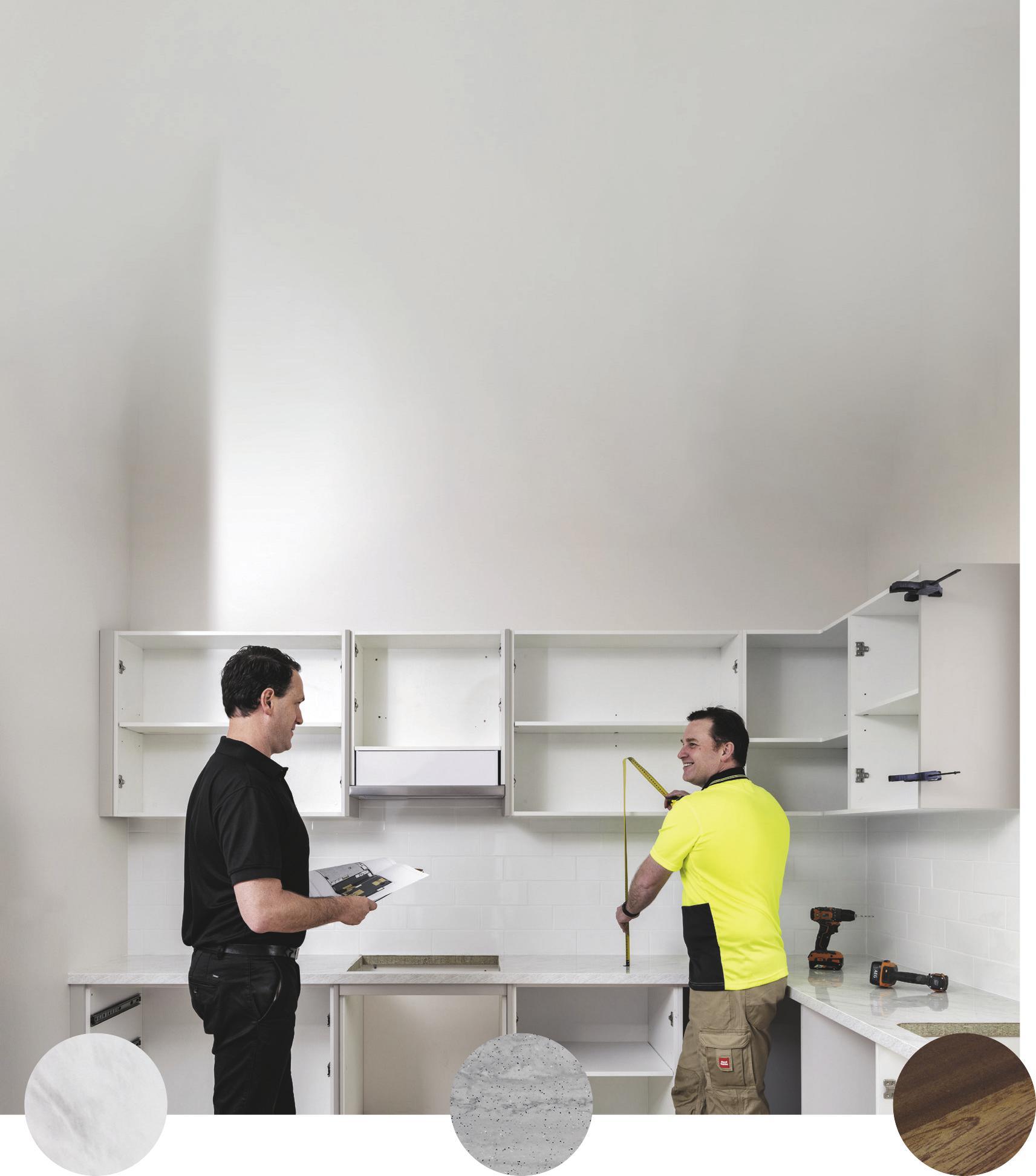




















































With engineered stone now banned due to serious health concerns, check out these alternatives that are safe, durable and environmentally friendly.






































WBY GEORGIA MADDEN

ell-liked for its durability, engineered stone has been a staple of the past two decades in builds, but when it’s cut it releases a fine silica dust that can harm the lungs if inhaled.





The Australian Government announced a complete national ban on the material, which came into effect on July 1 of this year Now, a range of alternatives are being installed Here are three safe, affordable and low-maintenance options you can offer your clients


NexGen stone is the newest range to hit our benchtop offering, replacing engineered stone. With a zero per cent crystalline silica-vitrified compact surface, as well as stain, scratch and heat resistance – it’s worth a look. NexGen comes in 20mm- or 40mm-edge profiles.
Laminex was one of the first companies in Australia to manufacture and distribute decorative plastic laminates. But benchtops wasn’t the original plan. Business-owner Robert Sykes first dipped fabric in a drum of resin, wrung it through a mangle and allowed it to dry into stiff, waterproof sheets for insulating electrical circuit boards.
A wide-ranging European study* via Aalto University in Finland found using wood in interiors benefits more than the environment. The evidence showed the presence of wood can help to lower our heart rate, blood pressure and stress levels.
*Source: Wood2New – Competitive wood-based interior materials and systems for modern wood construction, 2017
• Hard-wearing and non-porous
• Affordable
• Look of luxe materials, such as marble, woodgrain and concrete
• Available in a vast array of colours and patterns
Why it’s a good option
“With laminate, homeowners can capture the essence of stone, while enjoying its inclusive price point and durability,” says John Harrison from Kaboodle Kitchen. With care, a laminate benchtop will look good and perform well for years. Laminate is stain-resistant and wipes down easily with mild detergent and water. For added protection, there are laminates with scuff resistance and anti-fingerprint technology (Kaboodle Kitchen’s Molasses and Feta Whip offer this).
Some things to keep in mind
Minor chips and scratches can be repaired following instructions (check with the manufacturer). But if damage is extensive, the affected benchtop section would need to be replaced. It’s not as heat-resistant as stainless steel or natural stone, so a protective mat should be used.
• Hard-wearing and hygienic
• Softer to the touch than natural stone
• Range of colours and aesthetics
• Durable: resisting scratches, stains and moisture
• Look of luxe materials, such as marble and concrete
Why it’s a good option
Not only is a solid surface benchtop quick and simple to install, but it is less prone to chipping.
“Think Solid [solid surface] is made from natural materials and polymer resin, and has zero silica content, making it a safe alternative to engineered stone. It’s also recyclable,” says Ryan Clarke, National Sales Manager at Think Benchtops. “It offers exceptional stain resistance, plus it’s easy to clean and any damage can easily be repaired in the home.”
Some things to keep in mind
“While Think Solid [solid surface] benchtops are resistant to high temperatures, homeowners should always use a heat pad beneath hot pans or any heat-emitting appliances,” Ryan cautions.
• Long-lasting
• Easy to clean
• Natural look and adds warmth to a space
• Sustainable and renewable material
• Available in a wide variety of species
Why it’s a good option
For many homeowners, nothing comes close to the beauty of a timber benchtop. “Their raw tones add warmth and textural interest to a space,” John says. Think Timber recyclable kitchen benchtops are made from solid, 32mm-thick hardwood timber and sourced from responsibly managed forests. They also come in a selection to suit a range of kitchen aesthetics, including European oak and rich walnut.
Some things to keep in mind
They do look beautiful, but require extra TLC as the surface can scratch, dent, stain or burn with hot objects. Applying a protective coating can help prevent damage. “We recommend applying Cabot’s Benchtop Clear or similar,” Ryan says. “If scratches occur, remove them with fine sandpaper and apply a re-coat.”
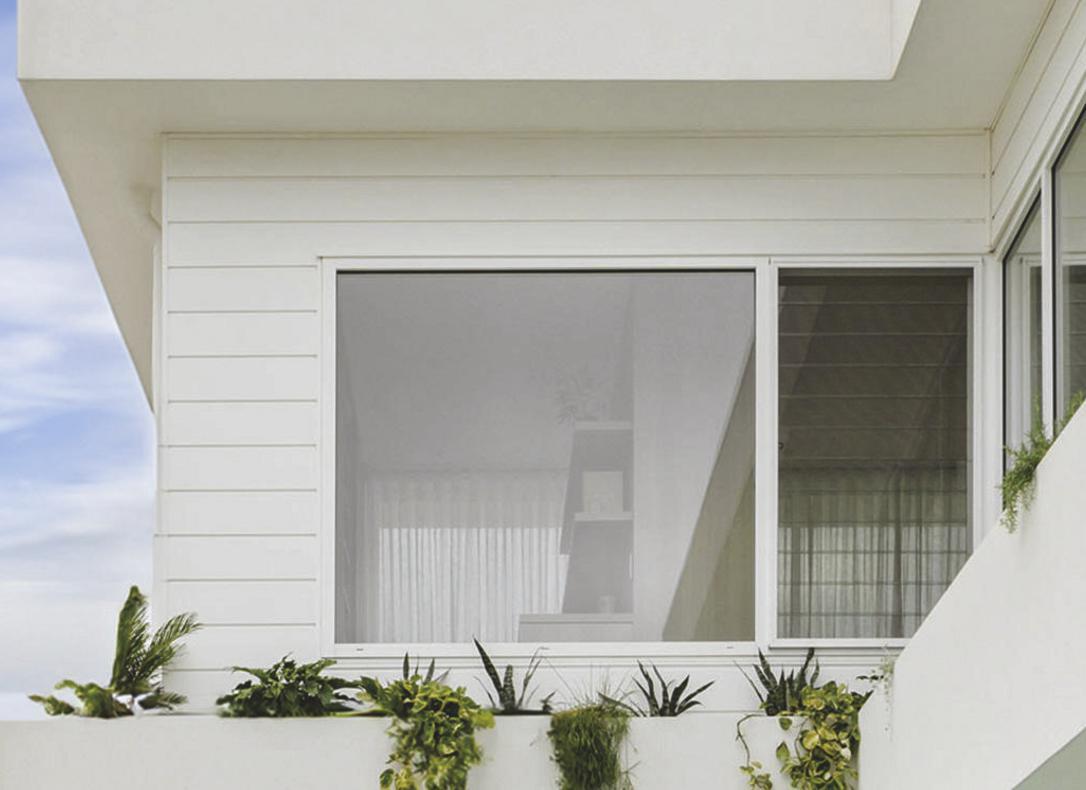

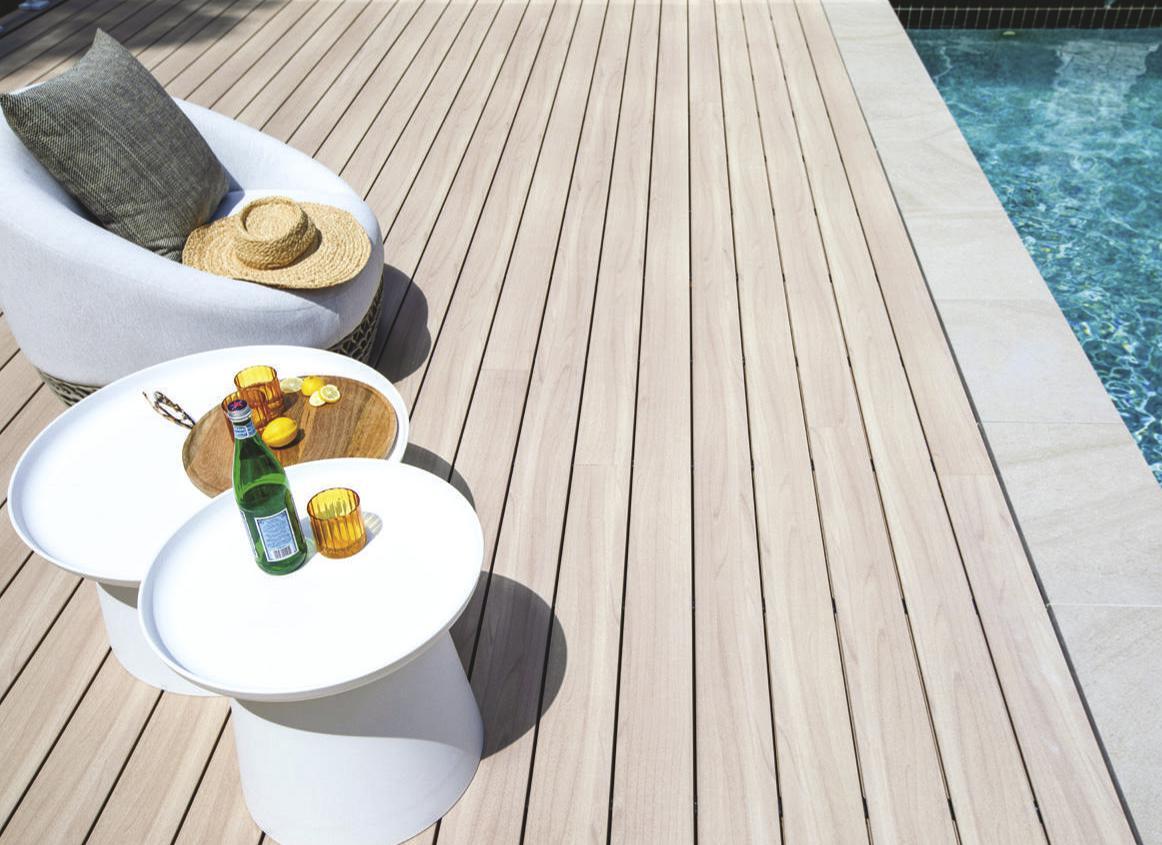
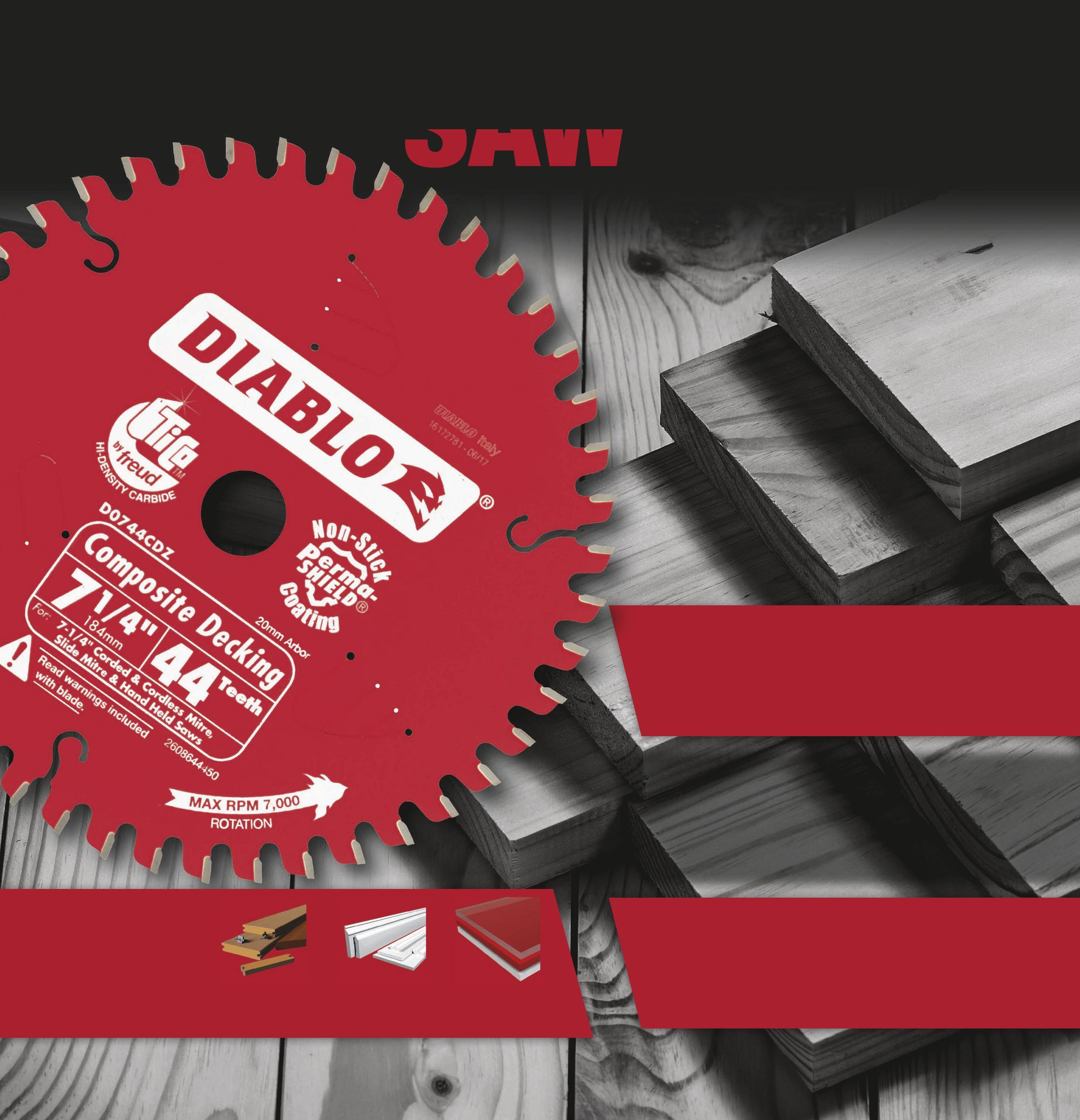

“Make sure you pre-oil [or buy pre-oiled] timber for protection,” says builder, carpenter and renovation expert Tim Clark. “If you oil it when it’s constructed and laid, you’ll only get the oil on the top surface.”
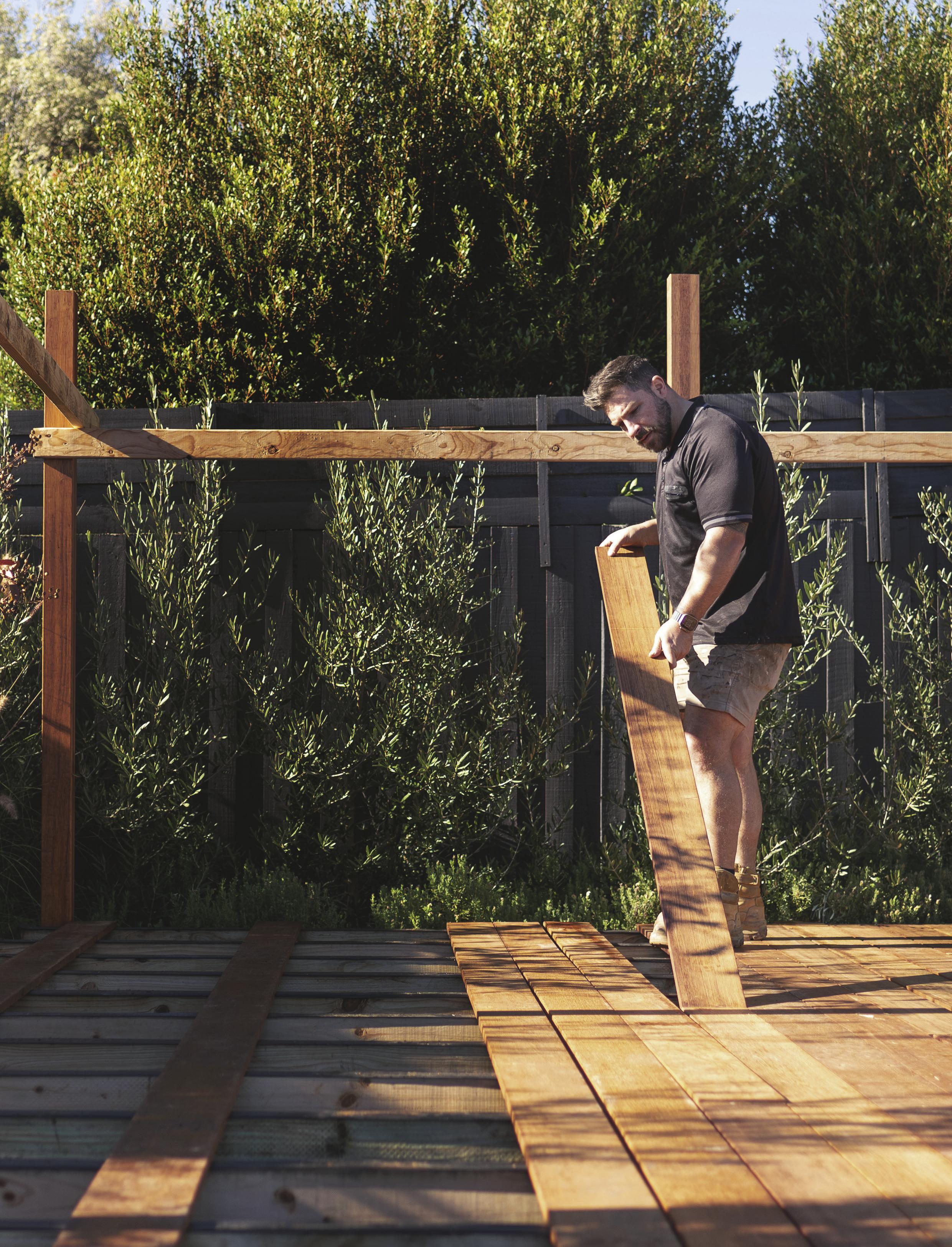
BEWARE OF IMITATIONS
“All the timber lookalike decking materials will fade over time to some degree – remember, they are fade-resistant, not fade-proof,” Tim says. Turntopage45formore...
AS A LANDSCAPER, “THERE’S A LOT OF VARIETY IN THE JOB,” SAYS PARRIS DRAKOPOULOS
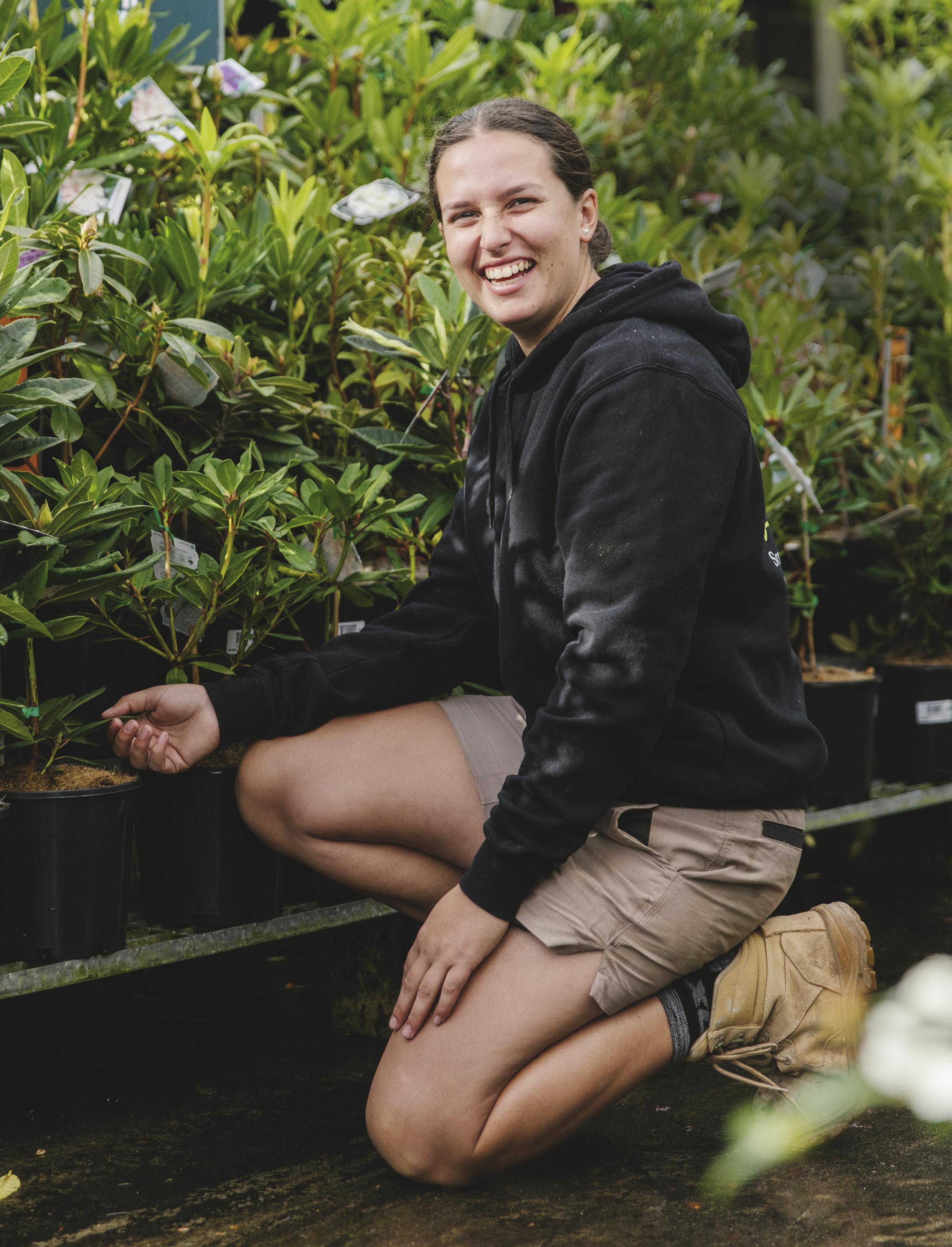
Meet three female apprentices breaking new ground in construction.
BY JULIE LEE
Just two per cent of tradies working in onsite construction roles are female, but that’s a number the National Association of Women in Construction wants to see increase to 25 per cent by 2025.
We meet three female apprentices working in trades who share their stories in the hopes of inspiring other women who are looking to join the industry. They are three of 10 winners of the Bunnings Women in Apprenticeships Awards 2024, which recognises women who are excelling in their trades. Here, they talk about their experiences…
Parris knew she was never destined for a desk job. She wanted to work outdoors, and from her first day on the site, landscaping was her calling. “Landscaping is perfect for me because I’ve always been an outside, hands-on person. I thought about carpentry, then decided on landscaping –it’s a bit of everything. As well as the landscaping, there’s carpentry with the decking and formwork, there’s paving and tiling, there’s a little bit of electrical work,” Parris says.
“To do my apprenticeship, I had to leave my family back home. I left my family, my dogs, all my mates, and moved three-and-a-half hours away to Adelaide. Leaving your mates and family behind is obviously not the easiest thing, but I knew it was going to get better – and it did.
“I love landscaping because no day is the same. I find it really satisfying when we get to the planting stage because that’s pretty much the last stage of the job and you get to see – from where you started to where you’re nearly finished – the transformation.
“I’d suggest women thinking about a trade should give it a go. See if you can get some work experience, but the biggest thing is showing your employer that you’re eager to learn and keen. Being an apprentice has taught me that if I don’t get something right the first time, I have to keep asking questions until I get it right. It’s hard sometimes – you think to yourself, ‘Why don’t I know this?’ but you’re still learning, so it’s OK not to know how things are done.
“The best advice I’ve been given as an apprentice is that being a woman doesn’t determine your ability. Just because you’re a female, it doesn’t mean you can’t do what the boys do. Being a landscaper is a really satisfying and rewarding job. It’s definitely going to be my career for as long as I can do it.
“The handiest tool I have is the tape measure. It’s hard to narrow it down to one tool, but this is the thing I use most frequently. Without it I wouldn’t be able to measure plans, make out the site, cut pavers… the list goes on. “
Parris’s employer, Tim Sortino, co-owner of Sortino Collier Landscaping, says he looks for both a willingness and eagerness to learn, as well as an interest in the trade, when hiring an apprentice. “Sometimes people can grow to love a trade, but with Parris it was easy because she already knew she had an interest in landscaping,” Tim says. When selecting the right person for the job, he also believes it all comes down to the individual. “Parris was the best fit for us and ticked all the boxes.”

PARRIS’S BUY Crescent Lufkin Shockforce Nite Eye G2 8m x 32mm Tape Measure, I/N: 0420955

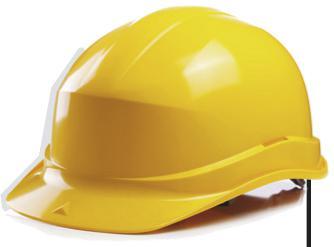


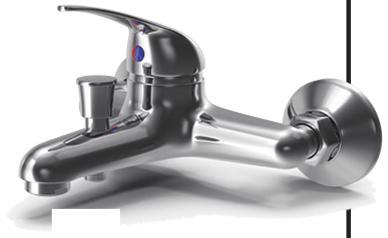


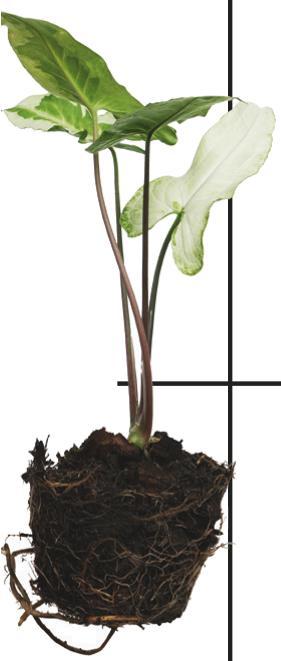


2% of tradies working in onsite construction are women* 25%
The 2025 target for women in construction*
$5,000
Current incentive for apprentices doing a trade on the priority list# x2
The number of female electricians has doubled since 2011^ 3% of tradies working in plumbing are women¥
5% of tradies working in landscaping are women¥
$55.6 MILLION
National government investment in the Building Women’s Careers program over the next 4 years~ H E S
Kincrome 10 Piece
Metric Geared Spanner Set, I/N: 6110154
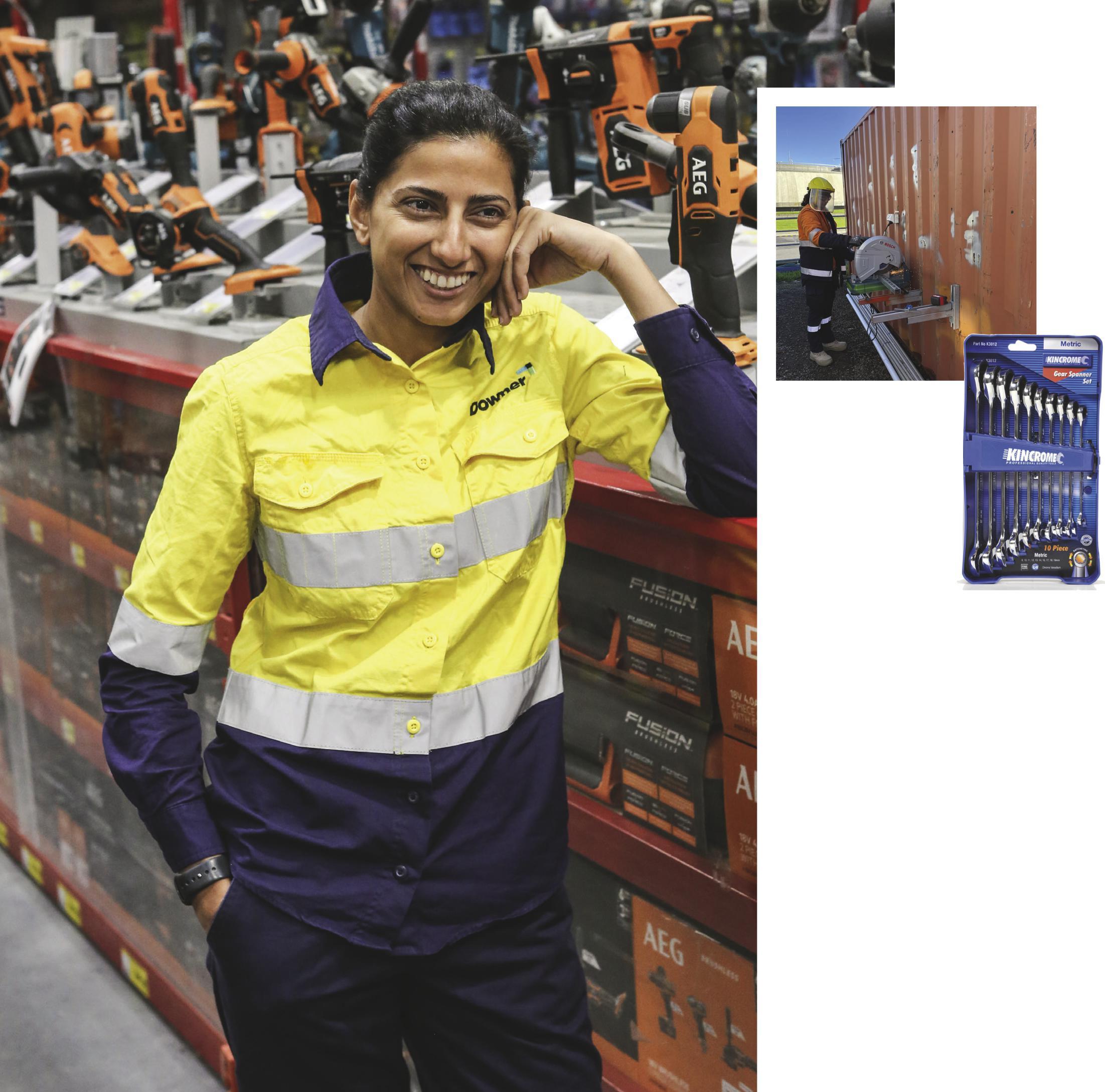
“I’VE GONE SO FAR IN MY FIELD AND I’M LOOKING AHEAD FOR A LONG TIME,” SAYS FAIZA NAZAR. “IT’S A GREAT OUTCOME”
Moving from Pakistan to Australia in 2019 meant Faiza could finally achieve her dreams of starting a trade and working the tools – she loves using her hands so much she didn’t even mind which trade she ended up doing.
“It’s taboo for women to be tradies in Pakistan,” she says. “The typical thinking of parents is that girls should do careers like engineering and medicine. They think girls are safe in these fields – no-one thinks outside the box that they can do something else. I did an undergraduate degree in computer sciences, but my passion was always working with tools.
“It was unbelievable when I came to Australia and could start an apprenticeship. I was very happy, and am still very happy that I’m doing it. On the first day of my pre-apprenticeship I was out there working with the men. We were given a task [using] tools, and from day one I just loved it.
“More than being an electrician, I just like being a tradie. I think every trade is good. I also wanted to be a carpenter and a painter. I just want to do hands-on work. When I came here, I went to Bunnings with my husband and there were tools everywhere. I loved walking along the aisles and looking at the tools.
“I think the best thing about being an electrician is that I’m learning new things every day. There’s not a single day that I can say I haven’t learned anything
– one day we’re doing wiring and then another day we’re doing cable pulling – it’s different every day.
“My confidence grows every day as an electrician. When I started, I thought I’ll do my first year, but because I’m from a different background I won’t be able to pursue the apprenticeship further. But now I think I can do it – I’m feeling better and more confident. It’s the best decision of my life.
“My best piece of advice for other apprentices is to be dedicated to your work. There will be some hard days and good days, but be dedicated, be passionate. I’m always passionate about my work – every day when I start working with tools, it increases my passion.
“The tool I use most is the Kincrome spanner set. I really love them. They are sturdy with a good grip and they are very long-lasting. I use them most days.”
Aaron Firth is a substation fitter worksite leader at Downer Group, and Faiza’s employer. He looks for diverse skills and backgrounds when interviewing apprentices. “Technical aptitude is important, but equally valuable are qualities like reliability, adaptability and a positive and proactive attitude,” Aaron says. “Promoting diversity in the workplace fosters innovation and creativity by bringing together people with different perspectives, backgrounds and experiences. Diverse teams are better equipped to solve complex problems and adapt to changing circumstances. It also improves employee morale and engagement by creating a more inclusive and supportive work environment where all employees feel valued and respected.”
FOR JESSICA LANCASTER, HER DAUGHTER, DELLA, IS HER INSPIRATION.
“I WANT TO DO MY BEST FOR HER,” SHE SAYS. “TO SHOW THAT SHE CAN DO WHATEVER SHE WANTS”

Jessica had a few extra challenges than most plumbing apprentices – she found out she was pregnant not long into her apprenticeship. Now, she pushes herself to be the best plumber she can be to set a positive example for her two-year-old daughter, Della.
“I started my apprenticeship when I was 23,” Jessica says. “I chose plumbing because I was a bit stuck with what I wanted to do. I’d done a chef apprenticeship, but couldn’t really find what I wanted. Trades popped into my head and plumbing was the one. I love problem-solving and I really love water.
“It was a big thing for me to go away from my daughter full-time. If I’m going to be leaving her for
40 hours a week, I want it to be important and I want to inspire her. I started my trade before she was even born, so she’s never going to have it in her mind, like I used to, that a trade is a male thing –she has a mum who’s done it.
“What I love about plumbing is problem-solving. Things aren’t always the same – if there’s a burst pipe there are all these different ways to fix it. You’re always thinking on your feet and having to figure out what’s going to work best and how you’re going to do it.
“I would tell other women thinking of doing apprenticeships that they absolutely should. There are so many more females in trades than even three years ago when I started. Now people are pushing for women in trades and there are great things like the Bunnings Trade Women in Apprenticeships Awards.
Makita 18V Brushless Impact Driver DTD153Z (Skin Only), I/N: 6240412
“Winning the award made me feel empowered. To have someone go, ‘You deserve this, we’re picking you’ – it makes me feel really good about myself. I’m not only doing this, but it seems like I’m doing it pretty well
“The handiest tool I have would have to be the Makita impact driver. I bought it as soon as I got my apprenticeship and it has been so useful on and off the job. In plumbing you often have to take things apart to get behind – or even in! – things to fix pipework or to find a leak. Having a tool that can take things apart and put them back together quickly is great.”
Tom Martin, Jessica’s boss and owner of Water Tight Canberra, says that when he’s hiring apprentices, he’s looking for an understanding of the trade and a desire to learn. “We generally look for mature-aged apprentices who have already completed some sort of formal training and can explain why they want to be a plumber. We find applicants that fit this criteria bring a world of diverse experience and skills while understanding the commitment and benefits of becoming a licensed plumber,” Tom says. “Jess had completed a cheffing apprenticeship when she applied for a position with us; she knew all about the plumbing industry, what the job entailed and why she wanted to be a plumber.”
October is National Safe Work Month –are you doing all you can to help make your jobsite a safe and healthy place to work?
BY SCOTT ELLIS
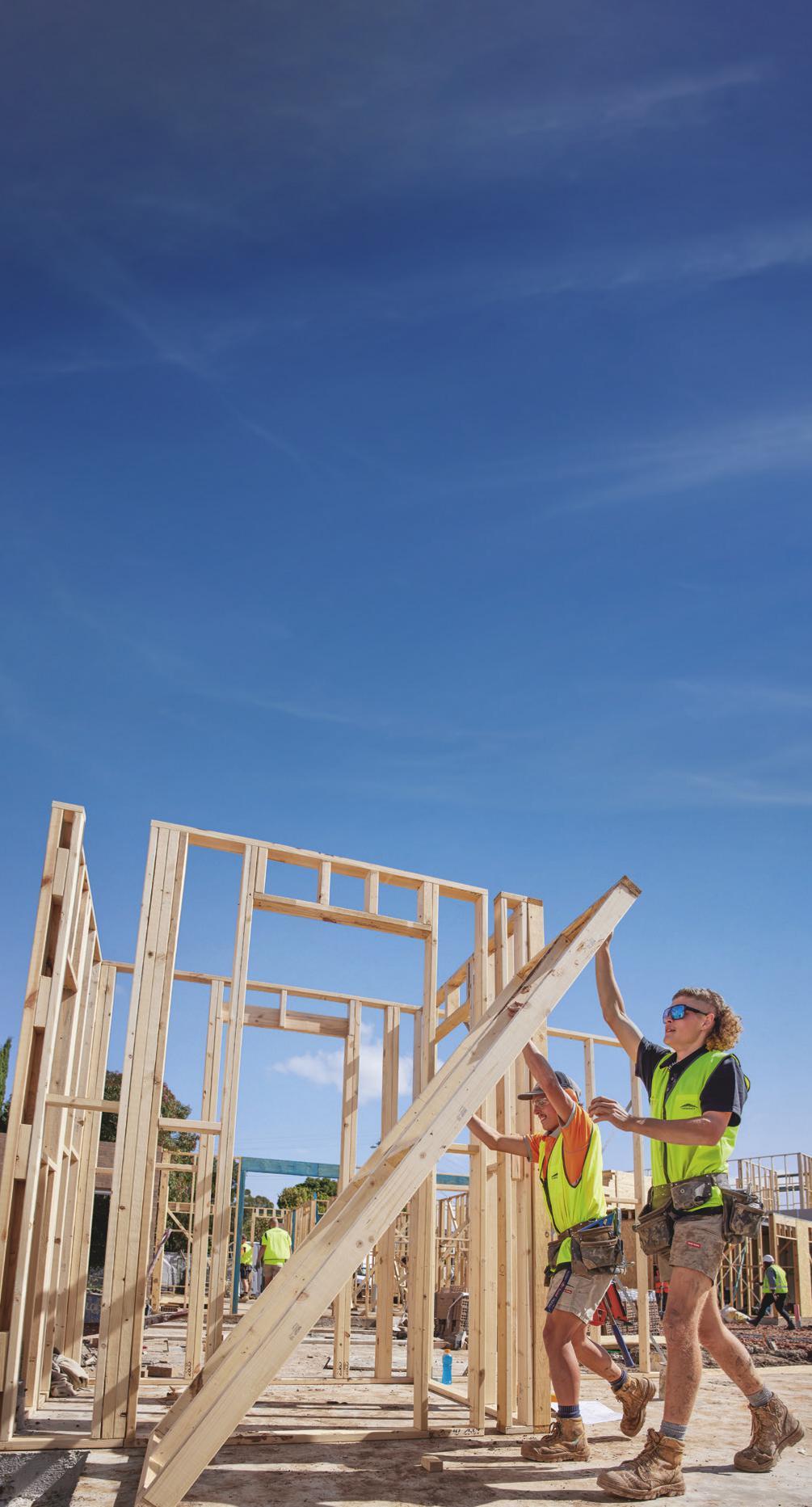
The theme for this year’s National Safe Work Month is ‘Safety is Everyone’s Business’. Every October, Safe Work Australia pulls together a program showcasing how we can collectively benefit from a safe and healthy workplace, especially when one wrong step could be fatal.
“No job should be unsafe, and no death or injury is acceptable,” says Safe Work Australia (SWA) Chief Executive Officer Marie Boland.
“National Safe Work Month encourages all individuals and organisations to prioritise workplace health and safety, and take preventative action to reduce the number of work-related injuries, illnesses and fatalities.”
Safety is all of our business onsite, and these gut-wrenching stats (the latest at print) prove why a safe jobsite is a must.
72 WORKERS
have been fatally injured at work in Australia this year* (*up until August 1, 2024).
$28.6 BILLION is how much better off Australia would be each year if we didn’t have workplace accidents.
4 is the number of steps there are in the risk management process to minimise psychosocial risks.
Firstly, identify hazards, followed by assessing risks (known risks and control). Thirdly, control those risks, and lastly, review control measures. This should all be done in consultation with your team.
5 WORKERS
lost their lives this year after being trapped between stationary and moving objects* .
28 WORKERS have been fatally injured in vehicle accidents this year* .
93% of fatalities were men in 2022.
1 IN EVERY 12 WORKERS have put in a compensation claim for more than one week of work time lost due to work-related injuries.
6 WORKERS fatally fell from a height this year* .
2 METRES is the recommended maximum height to work from where possible.
When you are two metres or more from the ground, make sure a Safe Work Method Statement (SWMS) has been completed and there are safety measures in place.
1 METRE RULE: is such that if a worker needs to raise their voice to talk to someone one metre away the noise level is probably too high.
85 DECIBELS on average is the noise level workers must not be exposed to. This is over eight hours of work. The rule changes based on decibels and length of time exposed.

WEEK 1 (OCT 1-6)
WORK HEALTH AND SAFETY FUNDAMENTALS
Understand the work health and safety fundamentals that everyone should know.
WEEK 2 (OCT 7-13)
PSYCHOSOCIAL HAZARDS
Learn what psychosocial hazards – such as bullying and fatigue – are and how they harm mental health at work.
WEEK 3 (OCT 14-20)
RISK MANAGEMENT FUNDAMENTALS
Employers must to do all they reasonably can to eliminate or minimise risks.
WEEK 4 (OCT 21-31)
MUSCULOSKELETAL INJURIES
How to prevent musculoskeletal injuries, such as sprains; muscle, ligament and tendon strains; and back and nerve injuries.

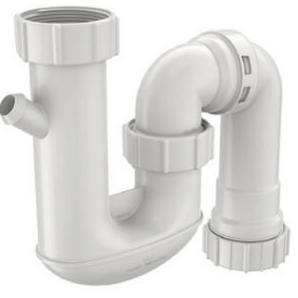
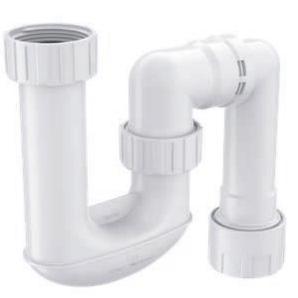

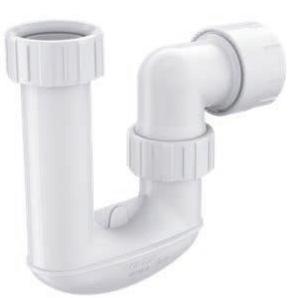

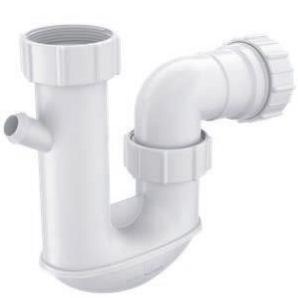
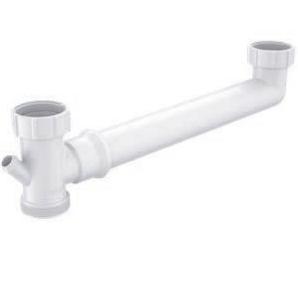
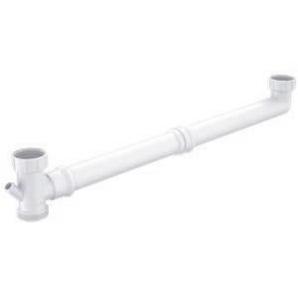
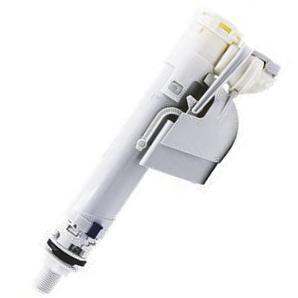
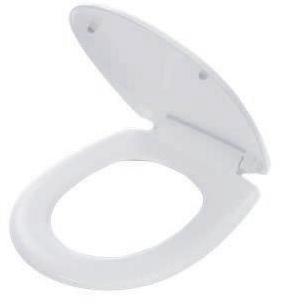
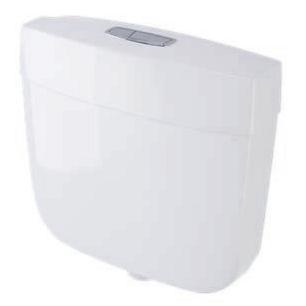

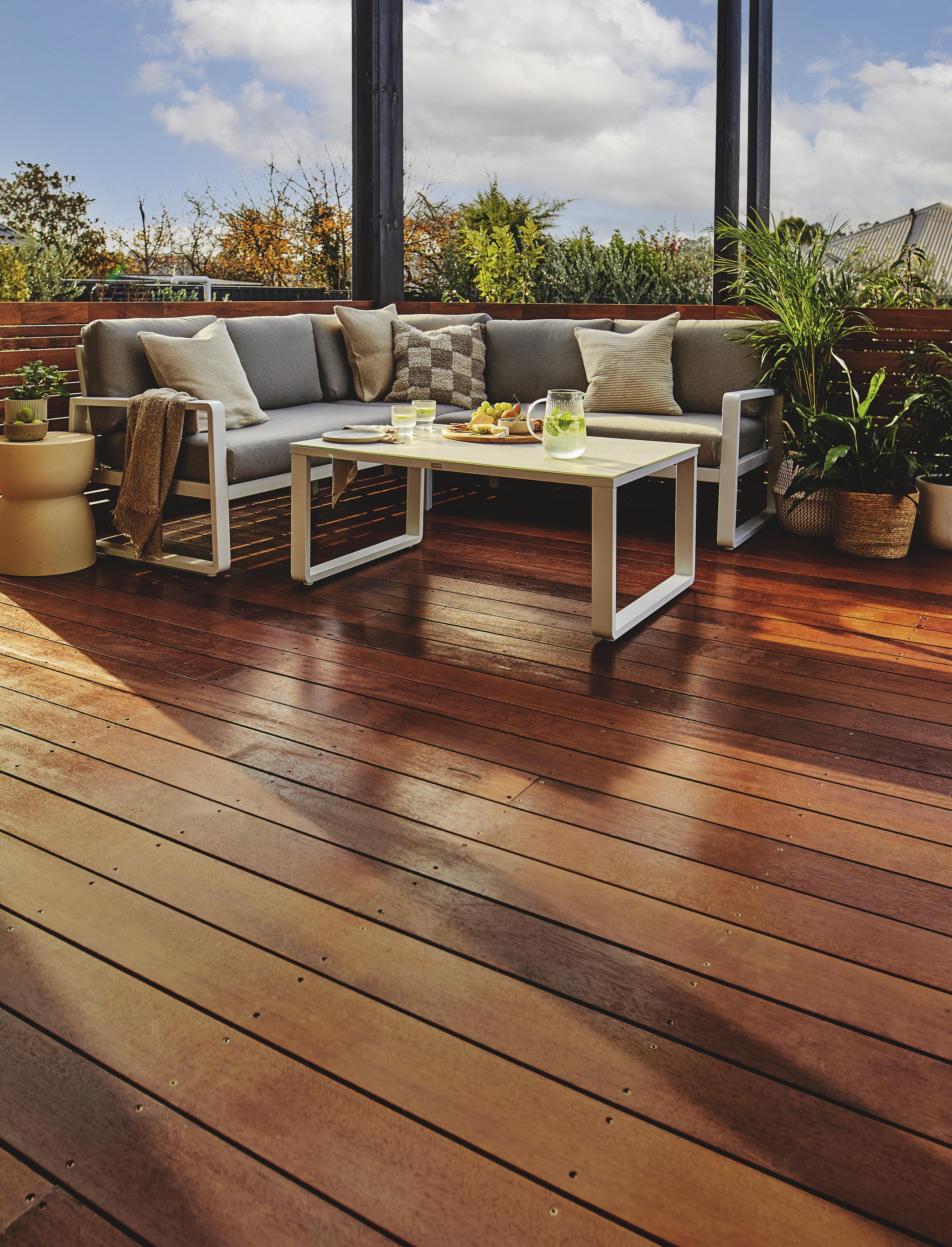
A great finish on your deck goes back to the start. And when you start with Specrite Merbau Timber, it comes pre-oiled and ready for a finishing coat.
Plus, it’s easy to install for a premium, natural look that lasts.
Carpenter Tim Clark loves bringing his client’s vision for their home to life, including helping them decide on the best and most practical decking solutions to transform any outdoor area. He shares his insights.
BY GEORGIA MADDEN
Agreat-looking deck can be a gamechanger, giving your clients loads more usable living space and a flexible area where they can relax and entertain. While timber comes out on top for warmth and natural appeal, there are other decking materials available these days that offer a host of additional benefits, such as easy upkeep, fade resistance and quick installation. Builder, carpenter and renovating expert Tim Clark, whose Essential Services Group business has laid hundreds of decks in Melbourne homes, shares the latest innovations in decking and his tips for a flawless installation.

MEET THE EXPERT
NAME: Tim Clark
COMPANY: Essential Services Group, Melbourne
YEARS IN THE BUSINESS: Nine
THE JOB: Building, carpentry and home renovations

“For many clients, nothing beats the warm, natural feel of real timber,” Tim says. “I love working with [rainforest] merbau [or kwila]– it’s the most durable decking species for Australian conditions. It weathers well and tends to be more stable than other hardwoods.
“SpecRite’s select-grade merbau decking boards come pre-oiled on both sides, unlike standard timber
decking. It’s slightly more expensive than regular boards, but it will last longer and your client will have less issues with movement, moisture, mould and weathering.”
They can safely be used in homes in different climatic conditions across Australia, including those in bushfire areas rated up to BAL-29. FSC-certified timbers are also available, allowing clients to build or renovate their home in a way that’s kinder on the earth.

“In situations where timber isn’t suitable, I tend to use composite decking, which is a wood plastic composite,” Tim says. “It comes pre-finished, needs no sealing, oiling or painting, and installs with a clip system with hidden fixtures, so it goes in fast.”
Unlike natural timber, it comes in set lengths, so you don’t have to spend time working out the board layout and there’s less wastage.
“You also don’t get the roughening or splintering of real timber, which can be a real boon for families with young children who play outside barefoot,” Tim shares. Another plus is that composite boards are getting better all the time thanks to advances in technology. “While the cheaper, entry-level composites tend to be a solid, uniform colour, premium ranges – such as Ekodeck Designer Series – feature variation and gnarls, making them look far more like real timber,”
To maintain its performance and look, timber decking needs oiling at least once a year – more in highly exposed areas.
There’s no escaping the fact that every timber deck needs TLC. “Maintenance is the biggest challenge clients face with a natural timber deck,” Tim says.
“To maintain its performance and look, timber decking needs oiling at least once a year – more in highly exposed areas – which is a cost in both time and money. But the payoff is a stunning natural addition to your yard, and a product you can sand back and refinish many times.”
• Traditional look and natural feel underfoot
• High maintenance
• Can warp, rot, shrink and twist if not maintained correctly
• Could need painting or oiling every six months
he says. “Ekodeck also has a Flame Fighter decking range that is rated BAL-29 and suitable for homes in bushfire-prone areas.”
There is a downside clients need to be aware of: if composite decking boards get scratched or stained, you can’t refinish them – they’ll need to be replaced.
“The new boards will be a different colour to the rest of the deck, which will have naturally faded over time,” Tim says. “And if a deck is partially undercover, the covered and exposed areas weather differently.”
You may also consider other options if your client’s deck is in blistering sun or a hot climate. “Composite boards also tend to retain more heat than natural timber, which can make them uncomfortable to walk on when the sun is blazing.”
• Comes pre-finished: no sealing, oiling or painting
• Installation via clip system with hidden fixtures
• Less wastage and no splinters
• Ekodeck Designer series available in Flame Fighter decking range for bushfire-prone areas
• Needs replacing if scratched or stained
• Retains more heat than natural timber
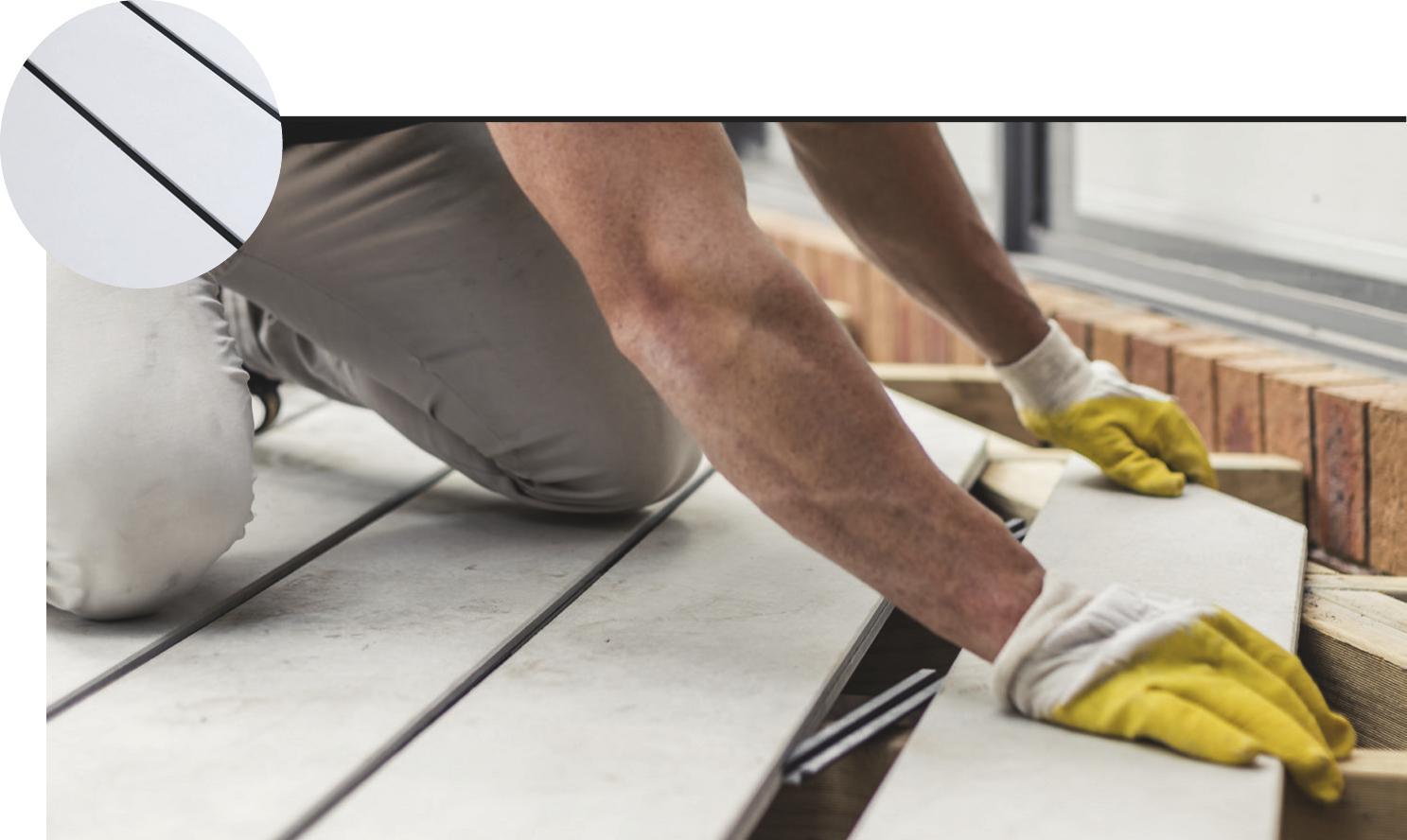
Taking half the time to install as a timber deck and complete with hidden screws for a seamless look, fibre cement decking is a great option for those who don’t want much maintenance.
“For clients who are less concerned about having a timber look and more concerned about fading, fibre cement decking like HardieDeckTM is a smart pick
as it’s less prone to fading,” Tim says. “It comes in a cool, flat grey, which gives a contemporary feel. Or you can paint it in a colour to match or blend in with your client’s home, like the roof or interior.”
As well as less fading, HardieDeckTM fibre cement decking resists termites, rotting, warping and moisture damage, so your clients won’t have to worry about time-consuming maintenance. And as it adheres to
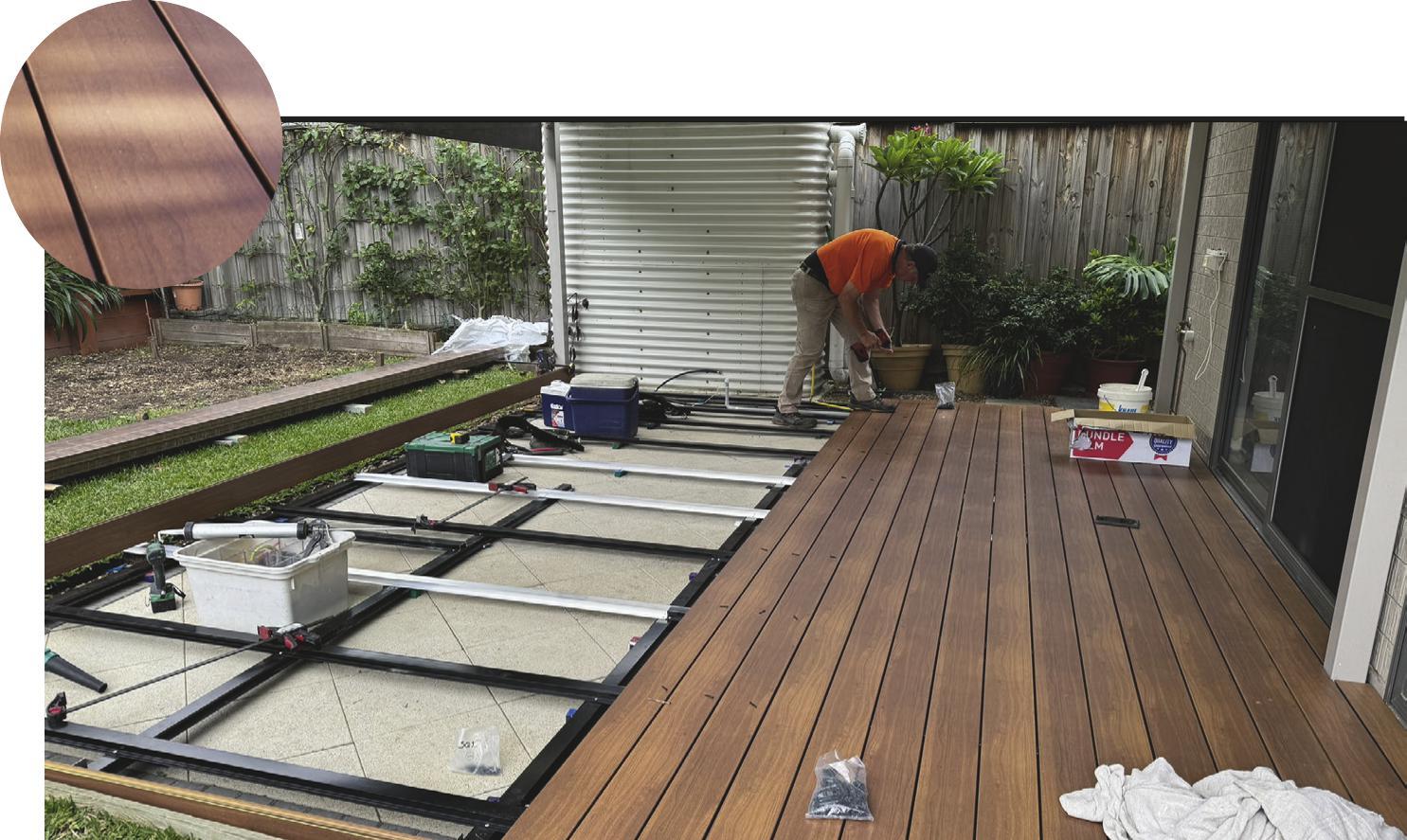
Aluminium timber-look decking combines the natural beauty of wood with the strength of aluminium for a durable, no-fuss decking solution.
“Your clients won’t have a problem with aluminium timber-look decking – it doesn’t need painting, staining or oiling, it won’t rot or warp, and it lasts practically forever,” Tim says. “And as it’s lightweight and installed with a simple clip system, the deck goes up fast.”
Aluminium timber-look decking doesn’t need painting, staining or oiling, it won’t rot or warp, and it lasts practically forever.
BAL-FZ requirements, you can also safely install it in bushfire-prone zones and in a firepit area.
“There are also minimal gaps, making it easy to sweep or mop clean,” Tim says. “Plus, it feels solid and smooth underfoot, and won’t splinter.”
Another appealing feature is you can install it as low as 150mm from the ground, so long as you have adequate cross-flow ventilation. Timber, by contrast, requires a minimum clearance of 400mm.
“A low-level deck can blend seamlessly into the garden and reduce the stairs needed, or eliminate them, which makes the area safer for kids and those with mobility issues,” Tim says. “It’s also safe to install around a pool area as it’s not affected by chemicals.”
Lacking the look of a traditional timber deck, fibre cement decking can also be more expensive per square metre to install compared to composite.
• Low maintenance and fade-resistant
• Can be installed 150mm from the ground
• Lacks traditional appearance of a timber deck
• Fire, weather, termite and water-resistant
You can now find varieties that not only look like real timber, but feel like it, too. DecoDeck, for example, has a textured woodgrain finish baked onto the powder-coated finish that mimics the real thing. The range comes in a variety of timber tones, all of which have some natural variation. These include Australian native timber effects, such as snow gum; exotic effects like French oak and kwila; plus a new concrete-look finish for a modern, minimalist look. It also suits homes in a variety of locations. The finish is marine grade, so it’s suitable for coastal areas, and the elements are non-combustible for installation in bushfire-prone areas rated to BAL-FZ.
Large deck? Not a problem – the boards go up to 6.5 metres in length.
“On the downside, aluminium does feel hotter underfoot than natural timber in summer,” Tim says. Plus, it exceeds the cost of timber and composites.
• Anti-slip powder coating
• Long-length boards
• No painting, staining or oiling
• Lightweight and easy install clip system

When Supercars Championship driver
Jack Le Brocq isn’t behind the wheel racing, he’s busy on the tools getting stuck into his latest renovation project.
BY GAVIN DENNETT
NAME // JACK LE BROCQ
TRADE // MECHANIC AND SHOPFITTER
LOCATION // BRISBANE, QUEENSLAND
Clocking up to 300km/h behind the wheel of his Chevrolet Camaro, Supercars driver
Jack Le Brocq is in his element. But away from the track, where he races for Erebus Motorsport, he boasts plenty of other skills.
Jack is a qualified mechanic by trade and spent five years in his early 20s working for his family’s shopfitting business in Victoria, where he was able to expand his prowess across carpentry, cabinetry and other renovation work.
He may be fully dedicated to his career in motorsport, but he utilises his tradie skills when not behind the wheel, deep diving into a range of DIY projects. One thing’s for sure: he loves being on the tools.
Thanks to a love of cars, Jack left school to pursue an apprenticeship as a mechanic, earning his qualification and spending time under the bonnet of vehicles.
“I’m a qualified mechanic and did that until I was 21,” he shares from his Queensland home. “Then when my racing amped up, it got too hard to do it full-time. My family has a shopfitting business and I worked there for five years with my dad and brother when I could – it gave me the chance to get away when I needed to.
“I learned a lot of skills, but since then [I’ve learned a lot] through YouTube and Google when doing renovation projects.”
While the 32-year-old didn’t undertake an apprenticeship in shopfitting, through osmosis he learned from his father and brother on the job.
“I always did bits and pieces onsite, and then became more involved in the factory with making cabinetry,” he says. “The main things we did were TattsLotto outlets in Melbourne and Australia Post, fitting out anything from front counters to kiosks and sometimes complete newsagencies with card racks.
“I learned on the fly and enjoyed doing kiosks. Shopfitting is like a jigsaw, piecing it together to make it look as seamless as possible. When I first started working with Dad, I didn’t understand how much went into it. I thought it was just slap some white melamine together to make a box and put some doors on it, but it’s more involved than that.”
The variety kept Jack interested. “Every store is unique, so it was interesting doing a different shop every two to three weeks. Retail is a pretty tough world. There were occasions when we completed jobs, but they were only there for a few months before having to move premises,” he says.
Jack has taken the skills he learnt from shopfitting and applied them to renovation projects on the home front, fitting out his wife Mackenzie’s pilates studio in Brisbane and completely transforming their house.
“I was ripping out part of the bathroom at home just yesterday, which is the final room left to do,” he says. “It’s a full house renovation during the past two years. I work on it between Supercars races so it’s been a bit of a slog.”
He admits he’s looking forward to not living in a renovation site and mess anymore. “I was off to a sponsor event this morning and couldn’t even find my shirt as it was buried somewhere. I had to just wear my team shirt instead,” he laughs.
“I’ve done most things myself, although you get in the plumber and electrician. However, I’ve done the kitchen, all the floors in every room, painting, skirting boards, doors, architraves, and done some feature walls and other random bits.
“With the bathroom, I just stripped it out and got a plumber to move some points around and re-sheet it all, then the tiler takes it from there. I did the tiling in the pilates studio, but haven’t been tempted to try it again.”
The pilates studio came together in six weeks, which was a satisfying project for Jack.
“It’s been just over a year since we completed that one,” he says. “My folks and brother came and helped us, which fast-tracked it. I’m stoked it all came to life from the little mud map we drew.”
Jack believes his post-motorsport career will involve continuing to work with his hands.
“I enjoy doing stuff with my hands and building bits and pieces,” he says. “Hopefully I have a solid 10 years of racing cars left in me, so I’ll worry about it after that. In the meantime, we have a bub on the way so that will keep me occupied.
“But eventually I will get into another project to fill in time between races. It’s a good distraction from racing, which is the main reason I do it. It gets my brain away from thinking about squiggly lines and how to press a brake pedal.”

Find out a bit more about Jack Le Brocq
DATE OF BIRTH
July 7, 1992
BORN Melbourne, Victoria NICKNAME JLB

FITTING OUT HIS WIFE’S PILATES STUDIO WAS A DIFFERENT CHALLENGE

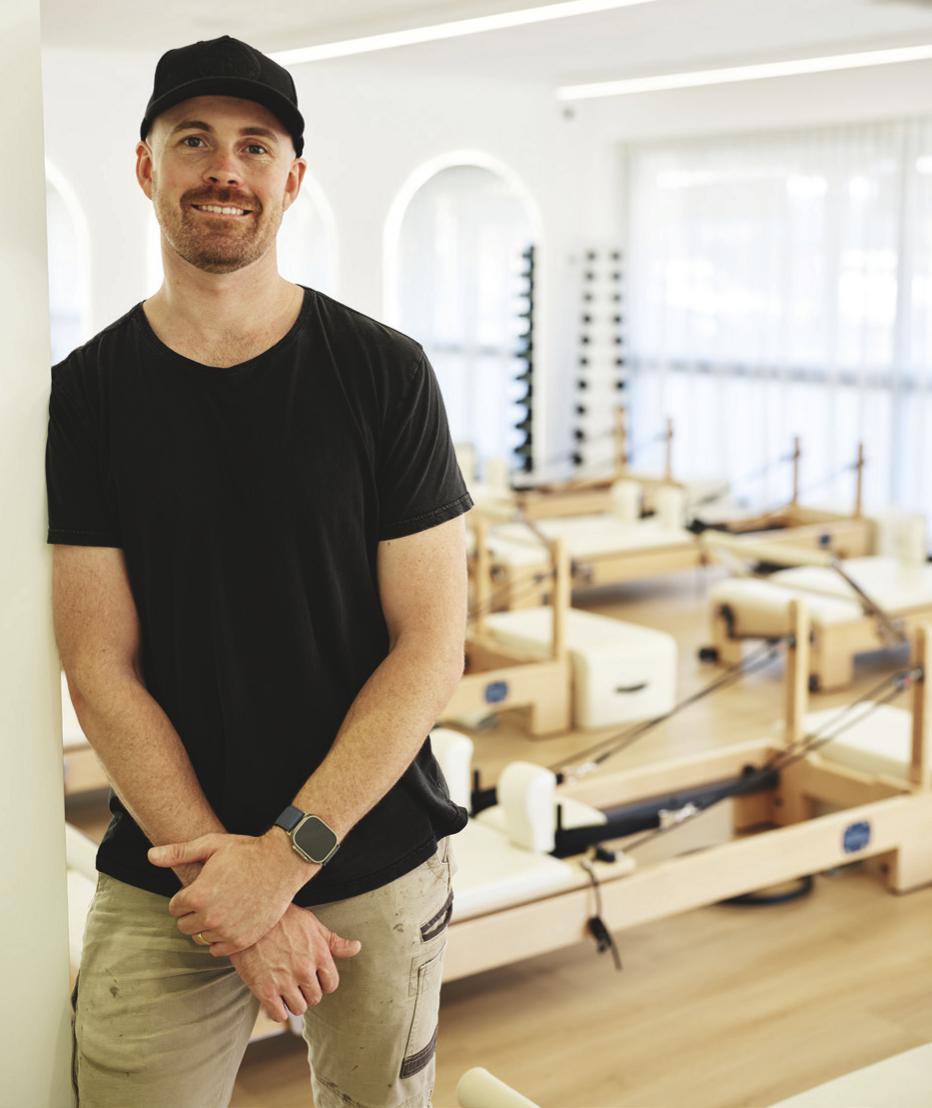
INSTAGRAM @jack_lebrocq
PATH TO SUPERCARS Started in karting and Formula Vee – winning the Australian Formula Ford Championship in 2012 while a member of the FIA Institute’s Young Driver Academy.
SUPERCARS DEBUT Sandown (Melbourne) 2015 alongside Ash Walsh, finishing 19th.
HOBBIES OUTSIDE OF RACING
Renovations and hitting the gym, golf course or tennis court.
Follow these practical tips from Xero to manage numbers, invoices, expenses and job costs with ease.
BY ANGELA TUFVESSON

First things first: commit to going fully digital and have confidence that you can do it. “If you can use a mobile and you have internet access, then you can use Xero,” says Nicole Acott, Xero’s senior education specialist. “You don’t need technical knowledge and experience. Xero is designed for small businesses.”
Sending online quotes from the worksite, easily turning them into invoices and adding a ‘pay now’ button to get paid faster helps you work smarter. Xero’s mobile app lets you send online quotes and invoices on the go, from your phone. “This means you can do business from anywhere and stay productive in your otherwise unproductive moments when you ’re in between jobs or on a break,” Nicole says.
“Xero works seamlessly between devices,” Nicole says, so you can work from your phone, laptop or a desktop computer. Connecting with other business apps like ServiceM8 also keeps everything streamlined, she adds. “Xero has an open API and you can easily connect with third-party apps. The information just flows through.”
Storing your receipts safely in the cloud means you’ll spend less time wading through boxes of paper come tax time. With Xero, simply take a photo of your receipts and bills as you go, so you never lose them. “It helps you keep tidy online bookkeeping records,” Nicole says.
Knowing what’s coming in and what’s going out is essential in running a small business. Xero helps tradies track costs and expenses, as well as project profitability – whether you’re on the job, in the office or at home.
6.
Incorporating super with the rest of your business admin saves time and helps to avoid any slip-ups. Nicole says tradies can use Xero’s auto super function, which sends employee super contributions to the super fund and super data to the provider as well as the ATO. “You just need to include the contributions to pay in a batch and submit for processing,” she says. Sole traders and contractors can use Xero to pay super directly into their fund or via the ATO’s clearing house.
Same goes for GST, which Xero calculates and speeds up preparing business activity statements. You can also submit your BAS to the ATO from Xero.
Going digital makes it easy to share your accounts with the experts. “You can invite your accountant or bookkeeper to your Xero file to get real-time help, rather than trying to figure everything out yourself,” Nicole says.
Invoice in an instant and see all your business numbers in one place. We’ve partnered with Xero to exclusively offer PowerPass members who sign up for Xero today 90% off for six months. Visit xero.com/bunnings. T&Cs apply*.

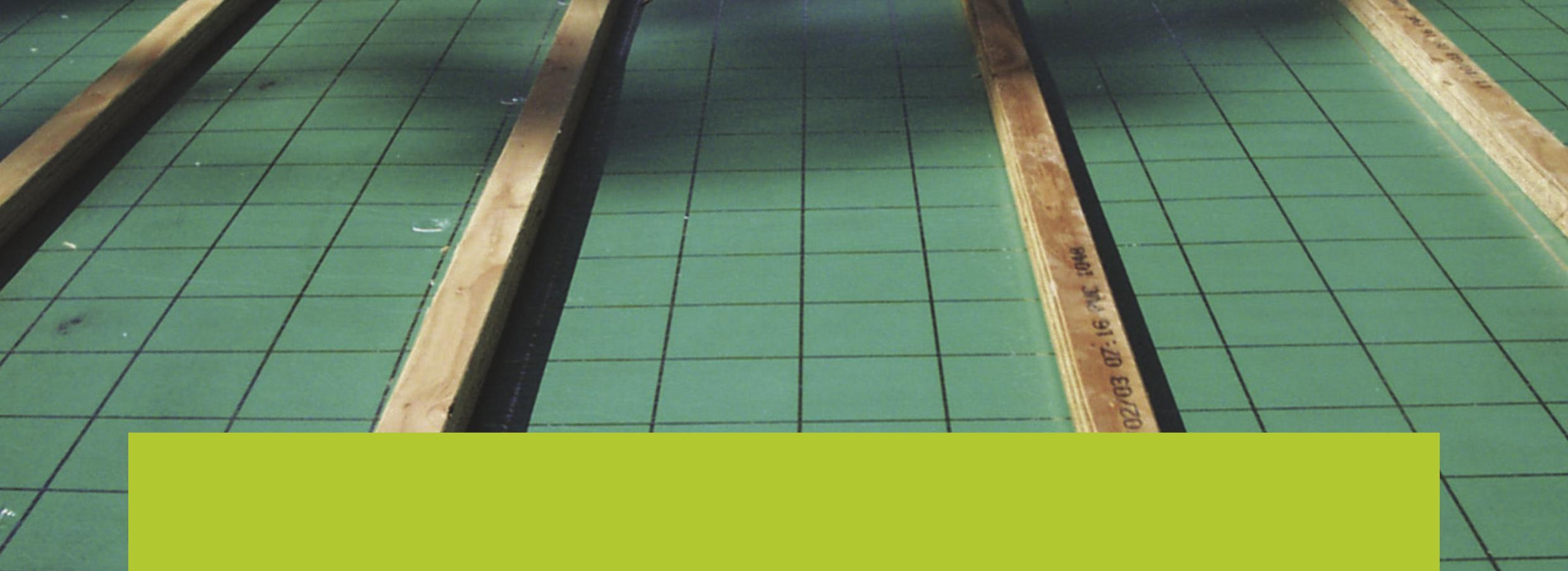


Keeping his tools secure and out of view was top of mind for window installer Matt Mahony when decking out his new work van.
BY JOSHUA DOWLING

Matt Mahony specialises in replacing old windows with new uPVC doubledglazed windows. You may have seen him on TikTok (@envirorenovations), where he has clocked up millions of views for his van fitout. His business, Enviro Renovations – which contracts to Solace Creations – refits modern windows in old homes, so they can be more energy efficient and more resistant to the outside elements.
A window installer for 11 years, Matt recently switched from a Ford Ranger ute towing a box trailer to a new Toyota HiAce van – and kitted it out to suit his specific needs.
“I prefer the van to the previous ute because I can just turn up to a job, open the doors, and it’s basically an instant workshop,” he says.
After making the switch – and completing the fitout of the van himself – Matt says he’s now a convert to the practicality of a van versus the limitations of a ute.
“I ordered the van in late 2022,” the 30-year-old says. “At the time there was an 18-month wait for
them because it was during COVID when demand out-stripped supply across the entire car market. But about a week later, I got a call from the dealer to say there had been a cancelled order, so I was thankfully able to jump the queue and get into this one straight away.”
To prep his van for the big overhaul, Matt made sure he did one major thing: “The van was initially delivered with a wire cargo barrier, but then I took that out and replaced it with a genuine Toyota solid cargo barrier because I wanted to keep dust out of the cabin. Plus, the air-conditioning works better in summer if it’s not cooling the whole van.”
Matt takes us around his workshop-on-wheels and explains why having “all the tools hidden from view when the car is locked” is a must in keeping his valuables secured.
“All you can see when the doors are closed is a ladder, some drop sheets, fold-up buckets, and a few other basic items,” he says. “The van also fits inside my garage, which makes it more secure, whereas before I had to leave trailers outside.”
“I wanted the ‘barn doors’ versus the liftback tailgate because it’s easier to work out of.”

“I had a plastic rack made using 3D printing technology – and fitted it to the left back door – to store spray-foam cans. This prevents my workers from opening a new can at every job.”
“The rest of the DeWalt table saw set-up is stored near the opening for the left sliding door. On the other side, I have a drop saw.”
“I covered the whole thing with marine carpet, which is hard-wearing and easy to keep clean.”

“To fitout the back of the van, I bought four drawers: 1300mm long, 500mm wide and 250mm high. The perfect size for storing my Makita power tools.”
“I like the tall driving position, the tighter turning circle and, without timber on the roof, it still fits under 2.1 metre car parks, even with these roof racks and an awning fitted.”
“Having carpentry skills, I filled the gaps either side of the boxes – and in between them – with formply, and utilised the available space for adhoc tools like a nail gun and leaf blower.”
“For shelter when it rains, I installed an awning so we can cut materials without getting our saws wet.”
“Between the main drawers, I’ve made a narrow slide-out drawer that securely stows all the Makita battery packs in divided sections.”
“I have seven long pockets for all the spirit levels to slide into. Below that I have a space for part of the saw bench.”
“Carrying about 750kg worth of equipment, I’m getting about 11.8L/100km from the 2.8-litre diesel automatic, which is pretty good for suburban use.”
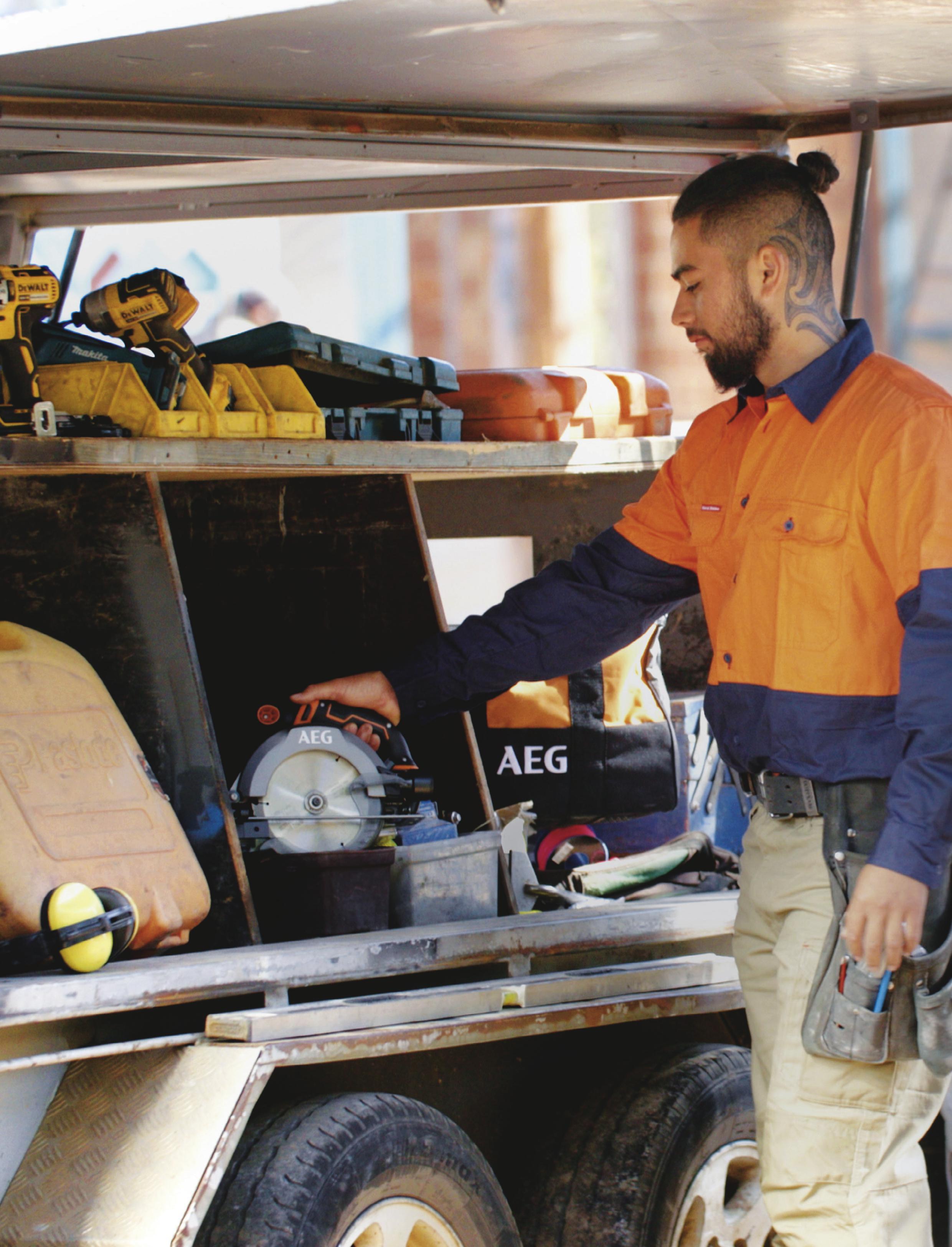
Your tools are your livelihood, so the cost of losing them could be huge. Here are the best ways to protect your gear.
BY JULIE LEE
Plumber Rob Brown parked his work ute out the front of his home on Friday after knocking off for the week, and woke on Saturday to find his toolbox open and power tools gone.
“It was probably only 20 metres away from the front door and I didn’t hear a thing,” says Rob, who works for Scott Plumbing Services in the lower Blue Mountains, NSW.
Rob was a third-year apprentice at the time and his entire tool collection was almost wiped out.
“It was about $9,000 in total,” he says. “They left my hand tools and just took the power tools – they knew what they were doing.”
Crime statistics around Australia show Rob’s story isn’t uncommon. In 2023, there were 13,053 reports of stolen tools in NSW*, while in Victoria, the cost of stolen hand and power tools alone added up to $33 million (an increase of 37 per cent on the previous year).
“All tools can be targeted and are appealing to thieves, but tools that are easy to access and left in plain sight are typically the most appealing,” an ACT Policing spokesperson says, where 2053 tools were reported stolen in 2023.
Here are some ways to help make sure you don’t become a victim of tool theft, too.
“One way to make [selling stolen items online] more difficult is for the tools to have a unique identifier engraved onto them, such as initials, a phone number and driver’s licence number,” the ACT Policing spokesperson says. “It also makes it much easier for police to track down the owners of tools quickly if they are recovered.”
Marking your tools with a UV pen can also help police identify stolen tools.
“Heavy-duty toolboxes with strong hinges and solid padlocks on the lids will act as a deterrent for thieves,” ACT Police suggest. Rob has now replaced all the locks on his toolboxes. “I bought two new locks with covers on them, so you can’t really break into it unless you drill it out and take the locks,” he says. “I’d tell all tradies to pay the extra money to get your toolbox fitted out with the correct locks.”
“There are a number of GPS trackers that can be linked to a smartphone app, which can increase your chances of your stolen tools being recovered,” says the ACT Policing spokesperson. But, remember: never approach thieves yourself. Call the police immediately. And do your research. GPS trackers can range in price and function. They ideally need to have real-time tracking, long battery life and a wide geographic range for maximum effect.
“The installation of CCTV at either your home or on a building site can act as a deterrent to thieves,” police advise. “The footage can also assist police to identify an offender or the vehicle they were using when a theft occurs. CCTV recordings should be kept for a reasonable amount of time (at least a week) to allow for collection of the footage.”
“My tools got taken out of a work vehicle so I went through my boss’s insurance,” Rob says. “It took seven months to get the money back, but I got the equivalent to their value so it was worth doing.”
deter thieves with some protection measures in place.


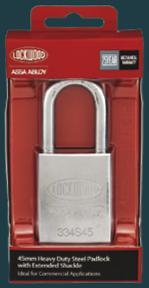
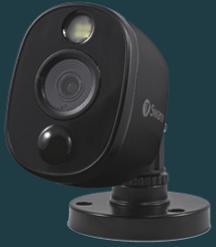

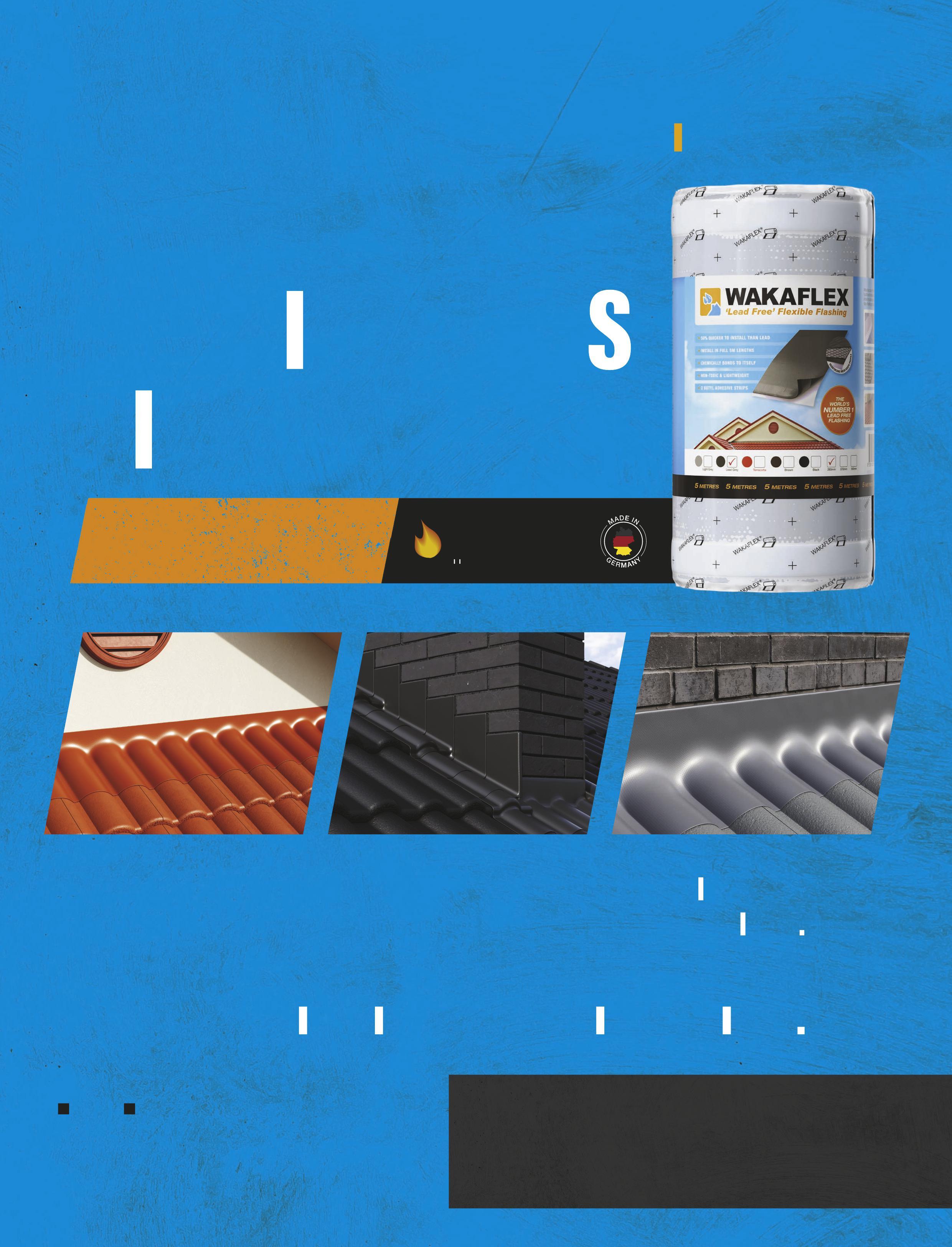
COVER UP Cancer Council research reveals 21 per cent of tradies don’t wear sunscreen as it’s too greasy. Best to find one that works for you – and add a wide-brimmed hat such as the Bunnings Large Straw Hat (I/N: 8510048).

Life tips and some light relief after a long day.
RISK FACTOR
Results from a YouGov consumer survey show almost six in 10 (58 per cent) of Aussie tradies know colleagues in the industry who have had skin cancer.
THIS TRADIE LEARNED THE HARD WAY ABOUT THE IMPORTANCE OF SUN PROTECTION
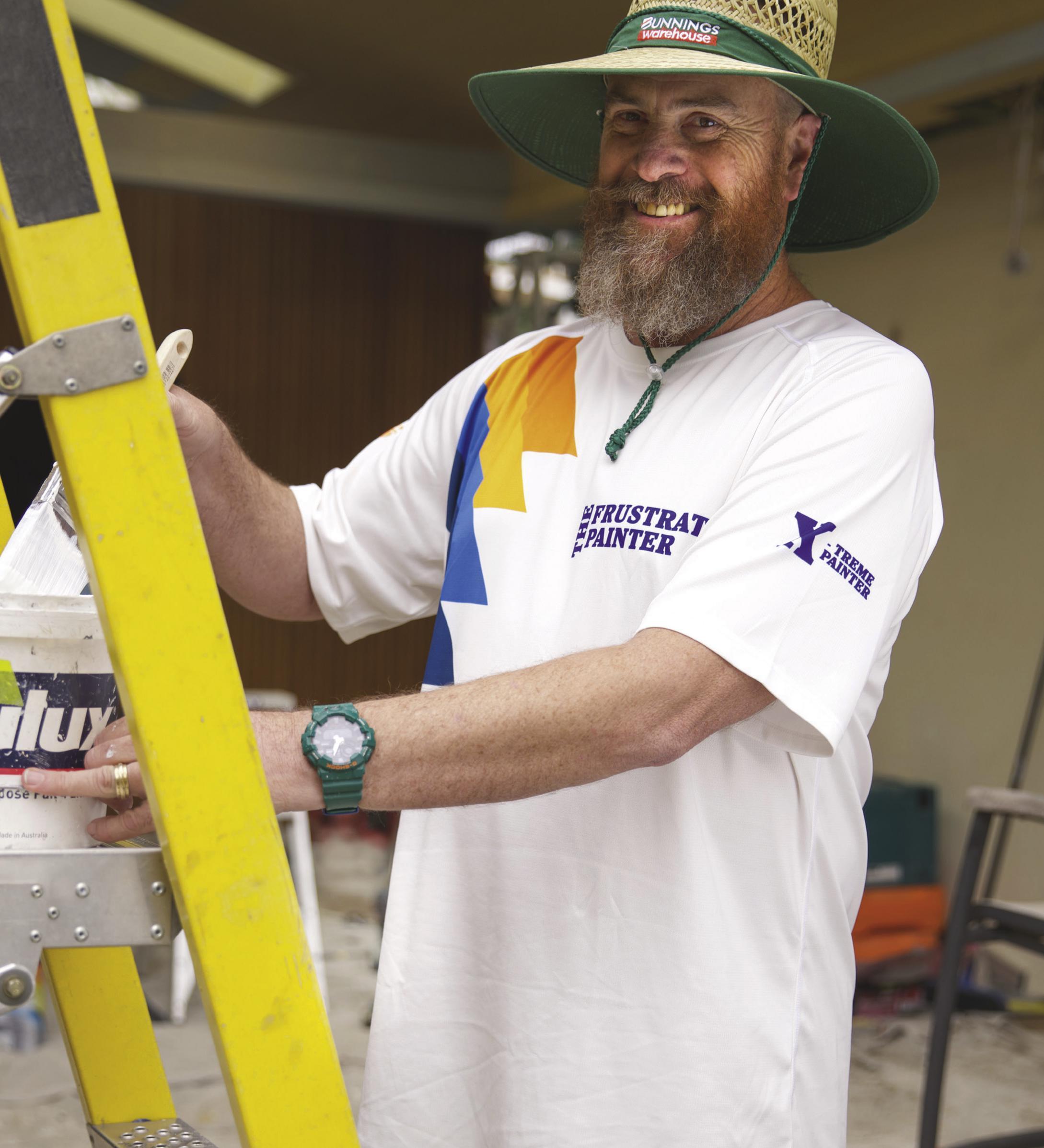











































































































Tradies have 10 times the exposure to UV rays, so how are you protecting yourself? We talk to a painter who has had multiple skin cancers removed and get Cancer Council recommendations on staying sun safe.







































BY JULIE LEE
hen commercial painter Anthony French first noticed a sore on his calf, he thought nothing of it. “I thought I must have hurt myself at work, but every now and again I’d look down and it was bleeding,” says the owner of The Frustrated Painter in Sydney. It was only when he realised it had been there for a while that he decided to get a medical opinion. “My doctor said, ‘Yep, that’s a skin cancer.’ He cut it straight out.”
Before this incident, Anthony admits that he paid little attention to sun safety on jobsites, recalling that he rarely wore a hat and he never wore sunscreen. “I grew up in the days when people used to put
coconut oil on to sunbake,” he says. “I didn’t really know about sun safety.”
Anthony’s story is common among tradies. “Research shows about nine in 10 tradies spend time outdoors on a typical work day, with almost half spending more than four hours working outside,” says Professor Anne Cust, who chairs the Cancer Council’s National Skin Cancer Committee. “We know about a quarter only rarely or occasionally wear sunscreen in the summer.”
The research, carried out by the Cancer Council, found tradies can have up to 10 times the rate of
exposure to ultraviolet radiation (UV) than that of workers who spend most of their time indoors.
“It depends on the type of trade and the type of work they’re doing, but if tradies are mainly working outdoors, or up on a roof, or on concrete with reflective surfaces, they’re probably getting higher exposure than if they’re indoors,” Professor Cust says. Anthony backs this up. “I’m a painter and I work outside all day, every day,” he says. “I’m always onsite with tradies, and the young ones have no shirts on at all. No one is too fussed by the risk.”
While 96 per cent of tradies have heard of the ‘UV index’, only 27 per cent felt confident explaining how
UV works, according to the Cancer Council research. For the record, UV index measures solar UV radiation. When the index reaches three, the UV radiation level is high enough to cause skin damage (it can go up to 11+, which is extreme). However, you need to protect your skin every time you go out into the sun. You can check the UV index for the day on the SunSmart or BoM (Bureau of Meteorology) apps, which also give you times of day when sun protection is recommended.
The main sign that you could have a skin cancer is when you have changes to your skin. “If you have a spot on your skin, like a mole that’s changing, or if you’ve got a new spot, then definitely get those checked out,” Professor Cust says. “Another potential warning sign is if you’ve got something on your skin that’s a bit itchy or bleeding.”
You can get an initial skin cancer check from your GP or go to a skin cancer clinic. At the skin screening, you’ll be asked to strip down to your underwear. The doctor will then look over your skin using a device called a dermatoscope, which is similar to a microscope.
“They might take a photo and ask you to come back in three months’ time to monitor it,” Professor Cust says. “If they’re really concerned about a spot, they’ll take a biopsy straight away. It’s not always obvious what type of skin cancer it is, or even if it is a skin cancer.” While many of those spots could prove to be benign, “It’s very hard to know without
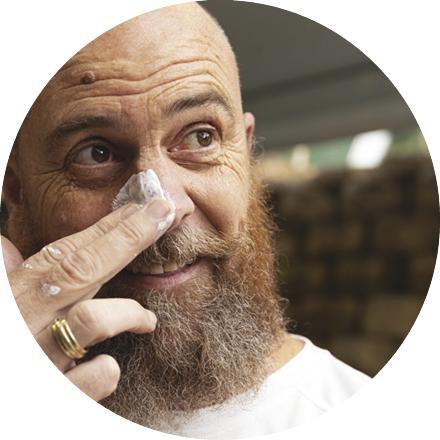
1
Make sunscreen top of mind. Put the sunscreen bottle right where you do something every morning – so next to the car keys or your toothbrush. And always keep it somewhere visible during the day so you won’t forget to re-apply it.
removing it. It is hard to make a proper diagnosis just by looking on the skin.”
Anthony, who has had multiple skin cancers removed, confirms that they can all be different. While the first one was bleeding on his leg, others have had almost no symptoms at all. “I was in the shower and it felt like I had a lump on my back,” he says. “There was no sore or anything. I went to my doctor again and he said that’s another skin cancer, so I had that one removed. I’ve had three or four of them.”
You’ve probably heard of “Slip, Slop, Slap”, but did you know the Cancer Council actually recommends “Slip, Slop, Slap, Seek, Slide”? That means: slip on a shirt, slop on some sunscreen, slap on a hat, seek shade and slide on some sunnies.
“Most sunscreens on the market now are SPF 50 or 50+ and that’s what I would recommend people use,” Professor Cust says. “And make sure it’s broad spectrum, which means it covers you for UVA and UVB.” Both forms of UV radiation are harmful and can cause different types of damage to skin.
As long as your sunscreen meets these requirements, Professor Cust says any brand you used is fine.
The Cancer Council has developed a SunSmart Tradie Toolbox with downloadable posters ready for display on jobsites. Visit cancer.org.au for more information.
according to the Cancer Council




MELANOMA
Uneven colour, irregular shape, smudgy outline.
Round black, brown, pink or red lump. Feels firm and may bleed.
Thickened red scaly spot. May ulcerate and bleed.
Red or pearly coloured lump or dry scaly area. May ulcerate and fail to heal.
Talk to your GP today about ANY spot that has changed size, shape or colour, or that bleeds, or any new spot or skin abnormality that appears. Do regular self-checks so you are familiar with your skin and make a plan with your doctor to have your skin checked regularly. The Cancer Council suggests those at higher risk of skin cancer, such as tradies working outdoors, may need a full check as often as every six months.
2
Don’t forget to re-apply. Sunscreen can sweat off and also rub off on clothing, so it’s important to re-apply after two hours – aim to do it every time you have a break. Try Living Protect 200ml SPF50 Plus Sunscreen Tube (I/N: 0075932) available at Bunnings.
3
Have multiple broadbrimmed hats. It might be raining when you leave home or you may just forget to pack a hat. Keep one in your ute and another on the jobsite so you’re never caught without a hat and left unprotected when the sun comes out.
4
Think long sleeves. Fabrics with a tighter weave will provide better protection for you than looser-weave ones, but Professor Cust says any fabric covering your skin is better than nothing. Anthony agrees and says if he could tell other tradies one thing, it would be to “cover up”.
5
One for the bosses –make shade available onsite. If there isn’t a tree for shade during break times, put shade structures up, even if they’re temporary. You could try Coleman 2.4m Ultra Compact Portable Gazebo (I/N: 0185612).




































































































The ‘silly season’ doesn’t equal ‘happy holidays’ for all of us, but counselling support service TIACS can help you look after your wellbeing this summer.















Reframe your thinking: Start by acknowledging there’s a problem and recognise the role you’re playing in it “There are two people in a relationship and both are contributing to the cycle,” Kurt says He does, however, urge caution on when to broach the subject with the other person “It might not always be a good idea to approach a conversation at Christmas time with everything that’s going on,” he says, suggesting it can be better to wait until post-Christmas when emotions are not so frayed


































BY JULIE LEE



You might be feeling wrecked after a big year. Your business may have been up and down, with financial pressures creating all types of head noise for you, and now it’s the Christmas holidays – but you aren’t feeling very festive









This time of year can end up being a pressure cooker of anxiety and stress Competing demands, social isolation and not having any ‘me time’ as you juggle family and life can be a lot


Throw in the current cost of living and the heat of summer – which free mental health service TIACS says leads to an increase in calls from blue-collar workers – and there’s a clear need for support Calls to TIACS doubled in the last year, and Ed Ross, pictured far right with Dan Allen – friends who co-founded TIACS and funky workwear brand TradeMutt – says those conversations will spark other ones


















Workloads – and clients – can get intense before the holiday season, and that pressure can sometimes play havoc on your mental health “There’s that fear of letting people down,” Kurt says “And that could be letting the family down; letting yourself down; and letting clients down ”










Reframe your thinking: Setting boundaries – and learning when to say no – is essential “Be transparent in how you are communicating those boundaries,” Kurt says “You can say, ‘I know in the past I’ve been someone who’s always there, but on these days I won’t be available.’ It’s more important to make the most of a rare couple of weeks with the family ”








“As soon as someone’s vulnerable, other people want to share their story We’re the mental health counselling service you can tell your mates about That’s what’s going to bring down these barriers.”









We spoke to TIACS counsellor Kurt – who through the service provides free counselling to tradies, farmers, truckies and blue-collar workers – about ways to approach the upcoming holiday season if you’re running on empty and your head feels heavy

























Troubled relationships are a common problem, especially at Christmas “It might be a marriage that’s in a tough spot and this is the first Christmas you’re not seeing the kids,” Kurt says, noting issues can also crop up between mates and colleagues



















You may be alone or you might be surrounded by people, but feeling alone – both are tough at the back-end of the year when the expectation is for more, not less, social interactions Head noise can set in







Reframe your thinking: Making an effort to reconnect with old friends can help, but Kurt acknowledges this isn’t as straightforward as it may sound “People who have distanced themselves from friendships may feel embarrassed or guilty about reaching out,” he says. “Generally, friends will understand ” He suggests being honest and approaching your mates with words like these: “Hey, I’ve been in a tough spot; I haven’t been feeling too social and I guess the flow-on effect is I’ve withdrawn from you I’m sorry You’re an important person in my life and I want to have you around ”


















































































A free mental health counselling service for Aussie tradies, farmers, truckies and blue-collar workers. Here’s what else you need to know...



















How do I or a mate reach out? Text or call 0488 846 988 to get in touch with TIACS 8am-10pm (AEST) Monday to Friday Don’t know what to say? Simply text ‘Hi’ and a counsellor will take it from there

When did TIACS start?


Tradie carpenters and mates Dan Allen and Ed Ross launched TIACS in 2019, off the back of their funky workwear business TradeMutt The service TIACS offers is funded, in part, from 50 per cent of the sale of TradeMutt shirts








How many has the service helped? TIACS has supported more than 18,500 Australian tradies, truckies, farmers, blue-collar workers and their families to the value of over $3 million More than 120,000 text messages have been received since July 1, 2021





Life’s too short to take it seriously. Get these funnies into ya.
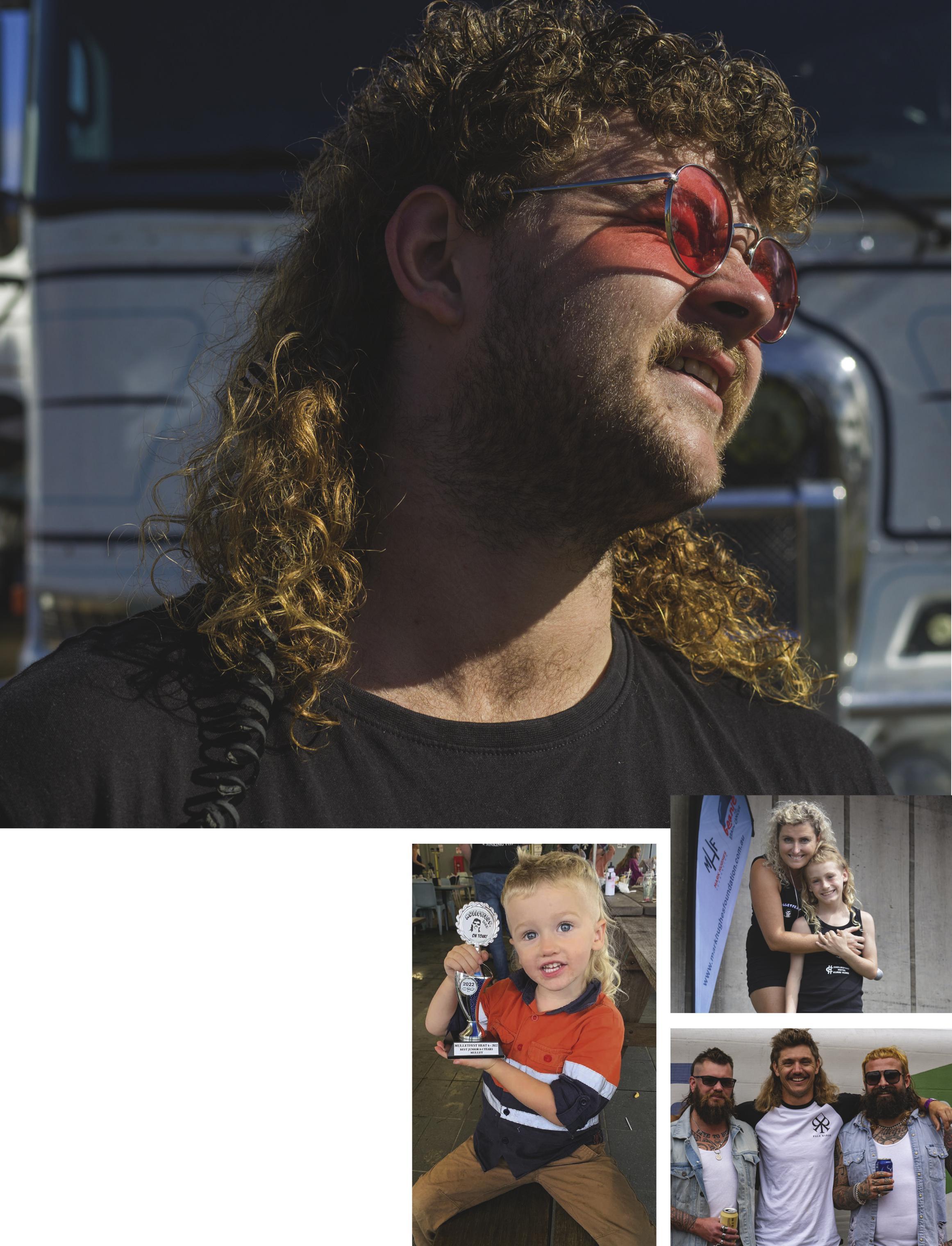
For these mullet-lovers, the party is most definitely never far behind them.
Mullets are well and truly back, baby. Some say they never left. You could argue it’s always been the quintessential Australian hairstyle. But no longer the ‘Outback mudflap’ of the ’80s, mullets have become a modern marvel – perfect for keeping a tradie’s neck shady on a sweltering workday.
Mulleteer and welder Mitchell White, who won ‘Best Mullet of Them All’ at Mulletfest 2023, knows a thing or two about keeping a glorious mane in pristine condition. Here, he shares his tips for maintaining a top mullet:
1. “Wash it with whatever shampoo is on sale.”
2. “Only brush it when wet, to avoid unwanted frizz.”
3. “Nanna told me to always eat my crusts to make it curly.”
4. “When welding, keep it tied up under your safety headgear – you don’t want that kind of fiery mullet.”
5. “Never get a haircut from the ears back – this is important!”
Foundedin2018,Mulletfesthasmadeanameforitselfaround theglobe.Visitmulletfest.com.auformoredetails,andsend usapicofyourbestmulletforaspotinournextissue!
CLOCKWISE: TRADIE-IN-WAITING HENRY BUTTERWORTH WINS THE MULLETFEST 0-3 HEAT IN 2022; MULLETFEST FOUNDER LAURA JOHNSON AND SON MAX; MULLETS FOSTER
MATESHIP FOR REFRIGERATION MECHANIC RORY RICHARDSON (CENTRE) AND PALS
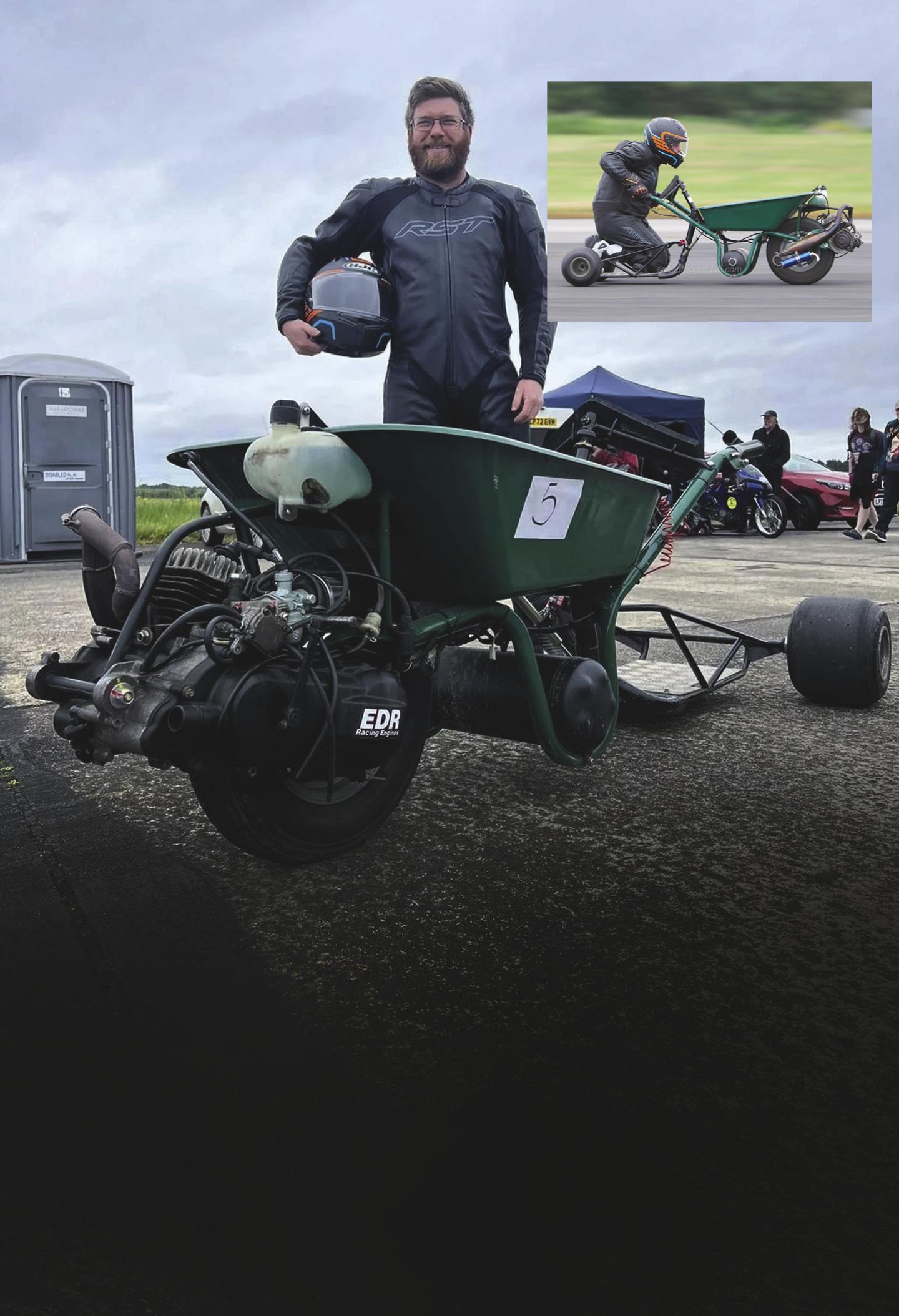
Clocking a top speed of 84km/h, mechanic Dylan Phillips has built the fastest wheelbarrow in the world. Claiming the Guinness World Record this year, the 38-year-old from Pembrokeshire in south-west Wales smashed the previous record time of 74km/h during Straightliners Speed Week. Phillips told BBC News that the idea came to him in the pub, and building his creation with bits he had lying around was initially just a bit of fun – then he wondered if there was a land speed record for a wheelbarrow. “Touch wood I’ve not come off it or had any mishaps,” he said. “It does leave you aching after a couple of runs because it’s got no suspension and it rattles you to bits.”
A heavily modified ride-on ‘Mean Mower’ holds the Guinness World Record for fastest acceleration by a lawn mower, clocking 161km/h in 6.29 seconds.
Need to boost your onsite comedy? These will make your mates either laugh or cringe.
“Out of all modern construction tools, I think the shovel is the most groundbreaking.”
“Old sparkies never die, they just keep plugging away.”
“I was offered a construction job in Egypt this morning, but I had to turn it down because it turned out to be a pyramid scheme.”

Test your tradie IQ and gues guess the amusing answers.
What do tradies do at parties?
Have you heard my under construction joke?
How many sparkies does it take to screw in a lightbulb?
What music do tradies listen to?
Six things have been changed in the image on the right. Can you find them all?

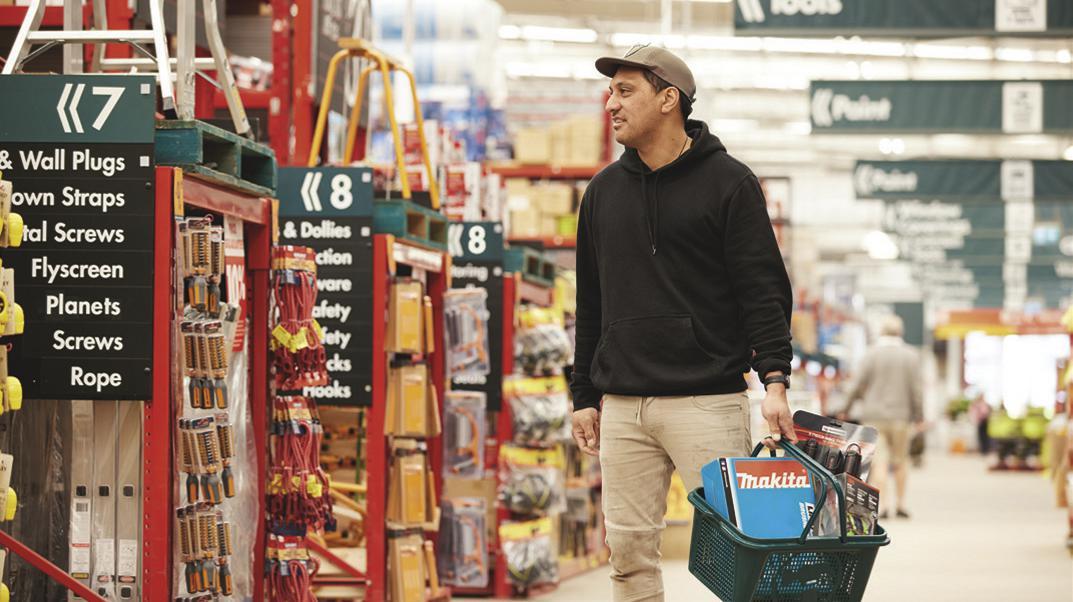

Yo. What up? The dog park is my fave beat
// NAME Wilbur, bordoodle
// HUMAN SLAVES All six humans in my family are my slaves (Sydney, NSW)
// YEARS ONSITE Nine months with Pangol Building Services.
// FAVOURITE RESPONSIBILITIES
Who doesn’t love waking all their family members up in the morning with a gentle tongue and plenty of fur to the face?
// SIT, WILBUR! At a solid 30 kilos, I can sit my larger-size rear on the edge of the couch to watch any movement out the front.
// I LOVE NOTHING MORE THAN... enjoying time in the sun and watching a little daytime TV after a run in the bush.
// WHEN I’M EXCITED... I can rip out the largest tufts of grass at any dog park.
// PROUDEST MOMENT I managed to get a hot tuna bake intended for eight humans down off the bench, smash the ceramic dish and devour the whole lot. Yum!
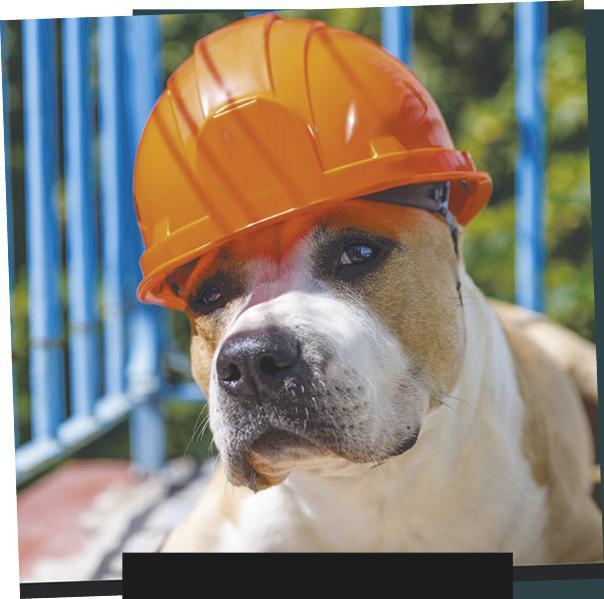
They don’t make a hard hat big enough for all my thoughts

// NAME Fernando, dachshund
// HUMAN SLAVES Alex and Laura (Sydney, NSW)
// YEARS ONSITE Four years with Harbourside Plumbing and Gas Fitting.
// FAVOURITE RESPONSIBILITIES Eat, sleep, bark, repeat.
// SOCIAL COMMITMENTS I love attending little parties with my fellow sausage tradie friends.
// ON THE ROAD, I LIKE TO… ride up front and give death stares to all the other plumbers, because my human’s company is the best.
// MY HUMAN SLAVE WOULD SAY I AM… his most loyal employee – apart from the occasional nap onsite.
// GOURMET TASTES I love human food, especially my humans’ homemade Italian food (I steal it when they’re not looking... shhh).
Sure, you might think you’re running the show, but we all know who the real CEOs of the home and jobsite are…
// NAME Daisy, unknown breed
// HUMAN SLAVES Laura and Damien (Brisbane, Qld)
// YEARS ONSITE Five with my self-employed carpenter.
// FAVOURITE RESPONSIBILITIES Sleeping. I can do that anywhere, any time, any which way.
// WHEN I’M HAPPY... my whole body moves as I go to wag my tail. True story. I love to shake my booty when I see a familiar face – it means I like you.
// MY HUMAN SLAVES WOULD SAY I AM... a big softie. Just look at my face!
// THE FOOD THAT WILL ALWAYS GET ME OUT OF BED IS... bacon. Or any noise I hear from the kitchen!
Safety first. Also handy when the boss is on a rant. Sorry…what?

// NAME Luna, English Staffordshire terrier
// HUMAN SLAVES Akira and Tash (Sydney, NSW)
// YEARS ONSITE Four-and-a-half years with Mindful Building sustainable construction.
// FAVOURITE RESPONSIBILITIES Accepting treats at lunchtime.
// FOOTY FAN Did someone say the Matildas? I love to play ball and reckon I could throw on a Matildas jersey alongside the best.
// MOST IMPRESSIVE TRAIT is that I win every tug of war.
// ONSITE, I AM KNOWN FOR... eating the new apprentice’s lunch. If it’s on the floor it’s mine, right? You snooze, you lose!
// WHEN I’M IN OUR CAR, I LIKE TO... ride shotgun, of course!
Can you hear the drill, Fernando? Not when I have ear protection! first. Also when theCalling all tradies with a pet that rules the roost! Email your pictures, along with some funny details as per our ‘site bosses’ above, to trademag@bunnings.com.au
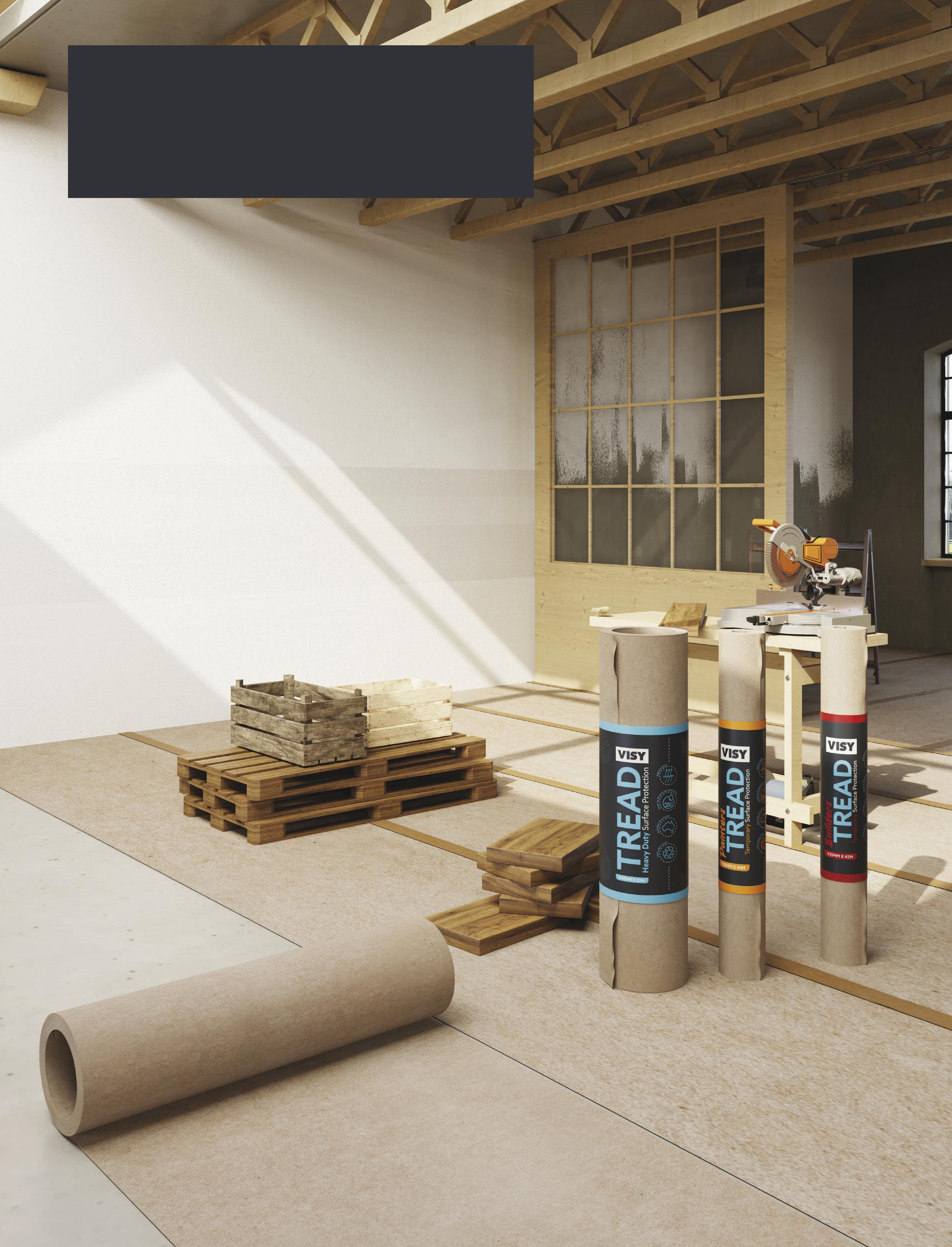
When you’re called to a site and what you find leaves you scratching your head...
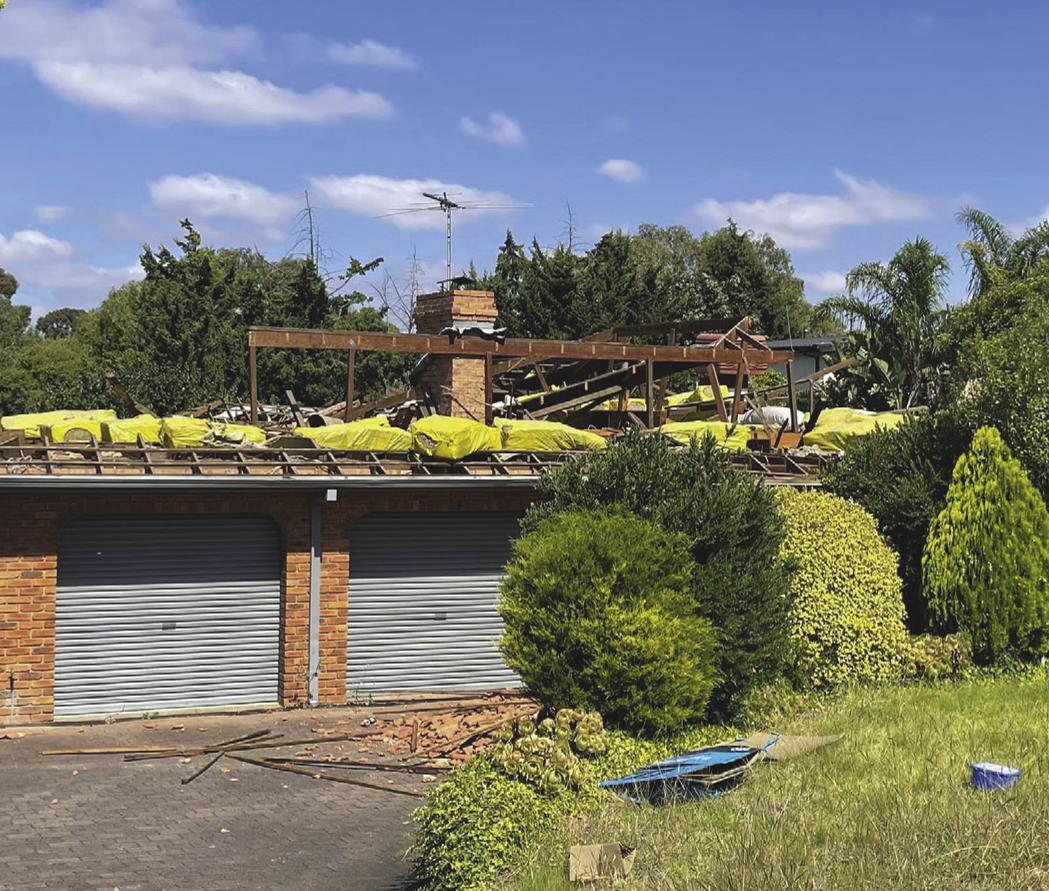
“This demolition exposed why the insulation felt so ineffective over the years.”
// JOHN STATESMAN, THOMASTOWN, VIC

“The client was wondering why the downpipe was blocked!” // COLIN, COLIN EDDY’S PLASTERING, PAINTING AND MAINTENANCE, SHEPPARTON, VIC
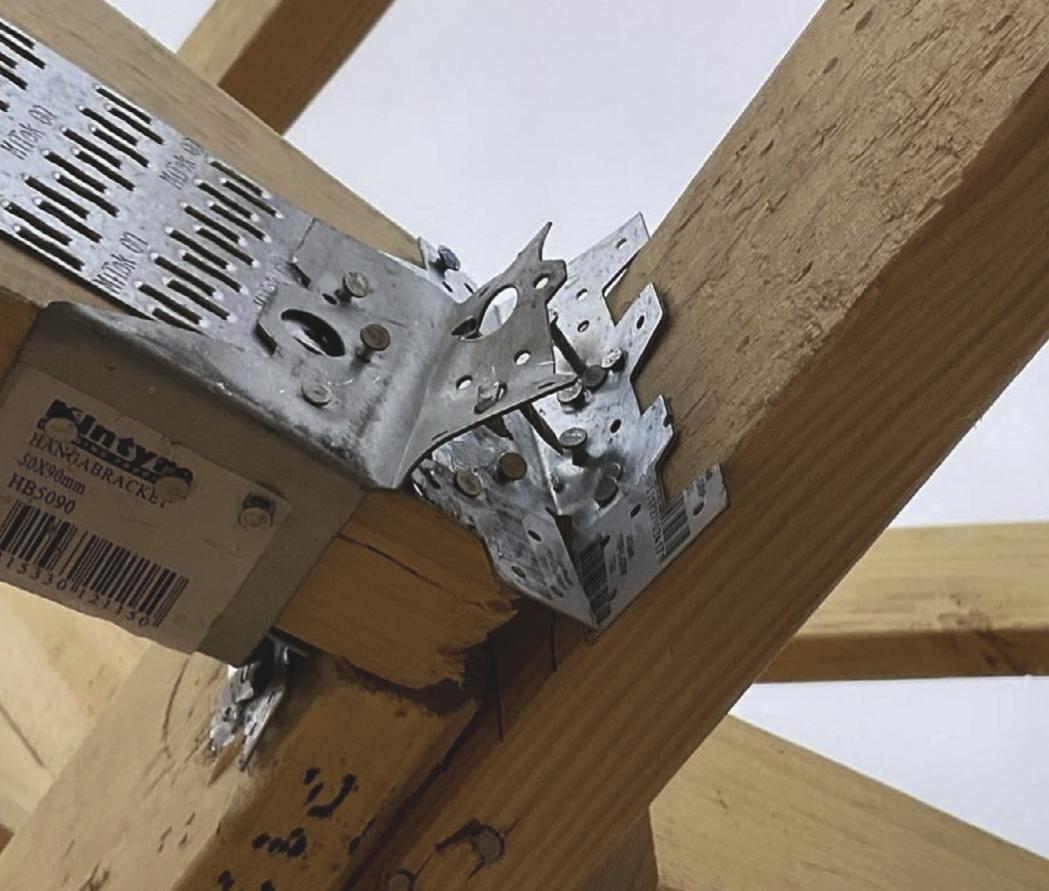
“‘Installed’ the correct hangers… right on top of the incorrect truss connectors. See if you can spot the other problems with this image.”
// NEW HOME INSPECTIONS, SYDNEY, NSW
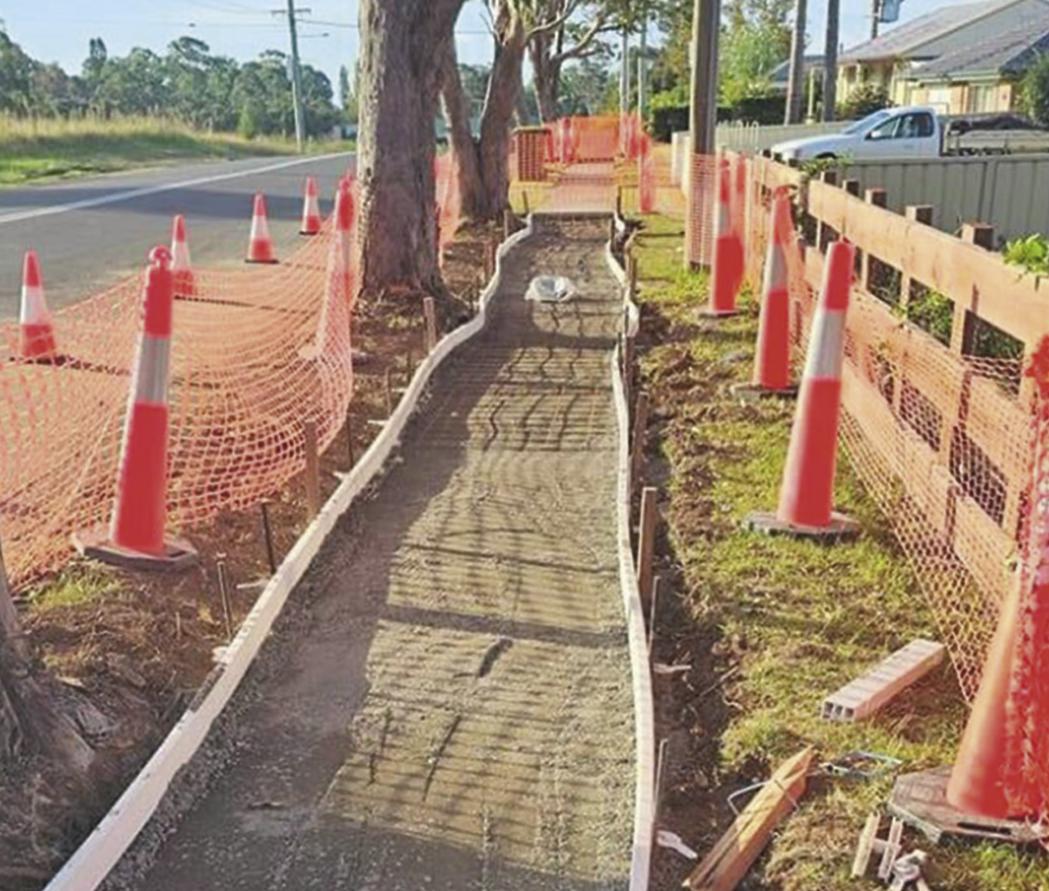
“Close enough to straight enough is enough, right?”
// MICK, PICTON, NSW
Seen some headscratchers on a jobsite? Email pictures to us, along with a caption of what the problem is, via trademag@bunnings.com.au
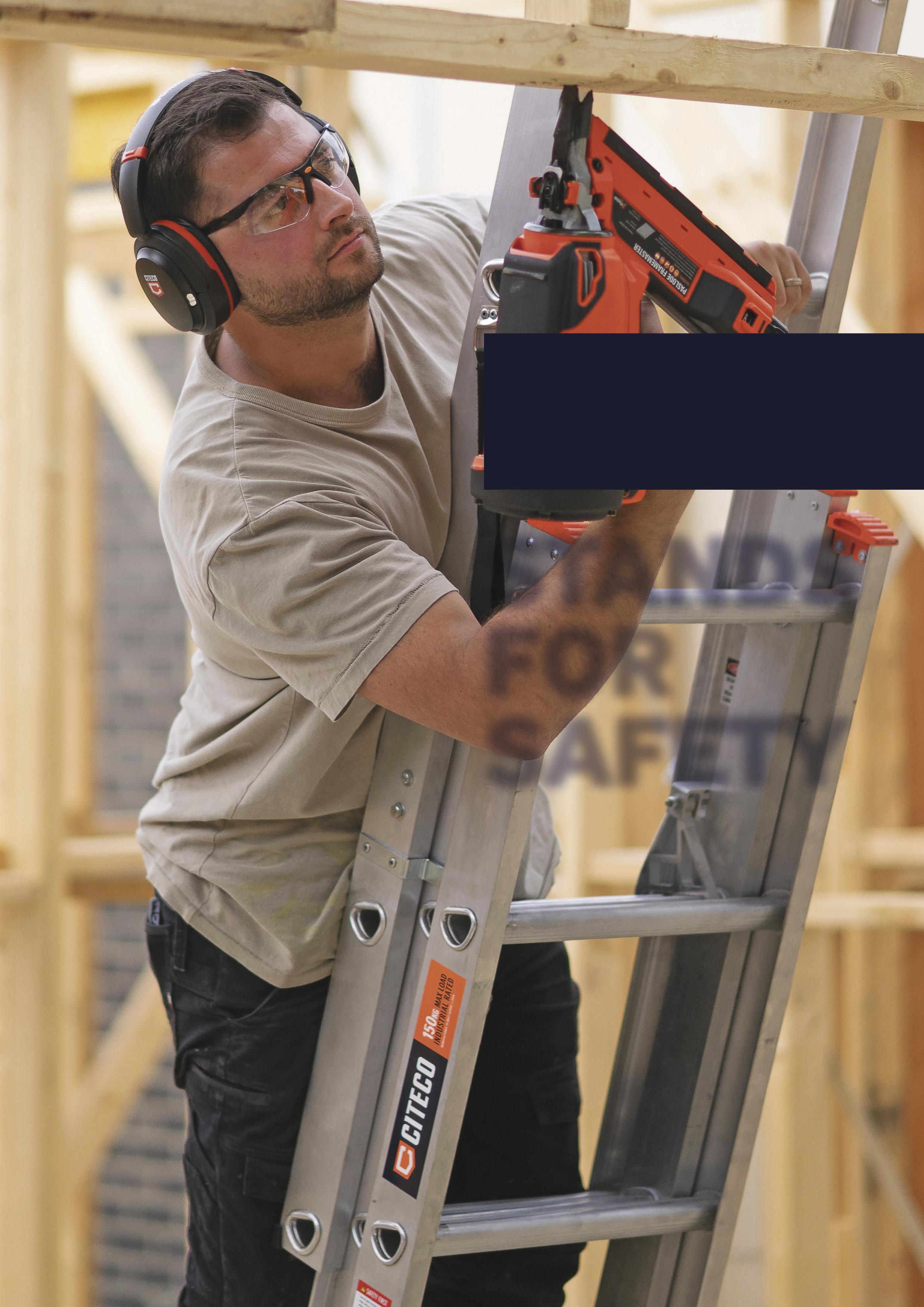
Platforms
Hearing protection
Eye protection
Face protection
